Appaloosa Territory
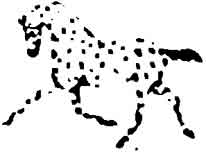
Home | Appaloosa History
Research, Opinions,
and Other Things about Appaloosas
Mexican In The Mix
by Rangerbred Researcher, Sherry Byrd
This piece might well be titled Latin in the Mix, as it covers way more than Mexican Appaloosas. There is a great deal of information here - enjoy! ~AT
It is well documented that Appaloosa colored horses and ponies have crossed the Mexican- U.S. border in large numbers from the time the Spanish explorers came to South America and Mexico, until the mid 1900s. It is documented as well that Mexican horses and ponies did influence the growth of the Appaloosa breed, which the ApHC has overlooked for decades, as it detracts from their “Nez Perce agenda” prior to the formation of the ApHC until current time. Even though Dr. Francis Haines, who some claim to have written the entire breed history on his own, gives credence to the Spanish influence, the ApHC has squelched any further influence of Spanish/Mexican stock on the breed, other than the purported original acquisition by the Nez Perce by natural and man-influenced dispersion of horses. All current books concerning the Appaloosa all offer the same “Spanish brought the Appaloosa to North America” scenario, in a continuation of the ApHC “story”. Cheryl Dudley writes that the Spanish conquistadors brought the “American spotted horse to the Americas”. Lynn M. Stone writes that the “most recent Appaloosa ancestors were spotted horses from Spain” brought about 500 years ago to North America. Bill and Donna Richardson say the “nucleus of the entire Appaloosa population of the Western Hemisphere” came from two spotted horses in the original group brought to the New World by the Spanish, along with more brought in later trips. Ann Hyland says that it is often thought that the Spanish influence started around the time of the conquistadores (late 15th or early 16th centuries) but has the opinion that the Spanish influence was present much earlier than is usually considered in the “main thread of the breed’s history”. Diane Keaster makes a broad and curious statement that the “Appaloosa is also of Spanish descent”.
To think that there was no further influx of Spanish horses after the Nez Perce got horses is ludicrous. Army records as well as writings of other whites tell of Nez Perce horses with Spanish brands decades after the original acquisition. [Note: There are several sources that purport the theory that the Nez Perce also came from Central or South America, since there are similar customs, and art forms]. A large percentage of POAs owe their ancestry to the spotted Mexican horses and ponies, and some of those horse/pony lines went into the Appaloosa as well. Also found in several registered POAs pedigrees is a Galiceno parent, a known Spanish breed without Appaloosa coloration. The September 2, 1967 Pombo and Sons Production and Reduction Sale catalog shows a 54-inch blue roan mare named Indigo Blue, that was imported from Panama, producing registered POAs. Research from multiple persons, as well as various registries’ records prove the influx of Mexican and/or Argentina Appaloosa horses and ponies into the border states. In Eileen Schissel’s article “Ponies of the Americas”( July/August 1979 Horse Illustrated), it’s noted out that some early POA breeders used Appaloosa crosses to develop foundation stock, while others imported large numbers of small ponies from Mexico, Central and/or South America, that had Appaloosa characteristics and coloration.
There is also substantial information that argues against the Spanish bringing ‘light horses’ to the New World, which goes against the established ‘norm’ of equine history from which deviation has been and still is greatly discouraged. In Heather Smith Thomas’ article, “America’s First Wild Horses” (March/April 1982 Horse Illustrated), she says that the first horses brought back to the New World in historic times were Spanish horses, which were a mixture of the heavy horse, the Norse horse (frequent dun colors), and the Arabian. Thomas goes on to say that Columbus brought first horses to the New World in 1493, to the island of Santa Domingo, on his second voyage. Columbus brought seed stock for the ranching colonies he was to establish. It is said that of the horses he brought, some were Spanish, while others were tamed descendants of the wild Iberian horses, including the "MarismeĖo" or Sorraria. It is also said that the lower quality Sorraria and Iberian horses were not what were supposed to be transported to the New World, but Columbus was taken in a ‘horse trader deal’. Spanish colonists set up horse breeding areas in the Caribbean and were shipping horses to North and South America for many years, with explorers and colonists. The rare Abaco Barb is a direct descendant of these early Caribbean Spanish horses. The report “Indian Horse Before Columbus", by R.T. Fitch correlates Thomas’ writings by stating that the early Spanish explorers like Ponce de Leon and others, had "heavy mounts", which as stray horses wouldn’t have contributed to the North American native horse population. Fitch also notes the records of Pedro de Mendoza’s 1536-1541 expedition, which spent 5 years in the Buenos Aires area, and lived on the herds of wild horses in the area. Bernal Diaz del Castillo wrote about how the Indians believed the “horse and the knight was all one”, when recording the 1519 Hernan Cortes expedition, which had horses on their ships. Hundreds of years later in the Personal Memoirs of U.S. Grant, by E.B. Long, U.S. Grant recounts the large wild horse herd found between the Nueces and the Rio Grande, and describes them as “very strong, formed much like the Norman horse, heavy manes and tails”. Grant further noted that the Mexicans caught these horses and sold them to American settlers and the Army, who found them very easy keepers just with grazing.
Early imported Spanish stock was used to set up breeding ranches in South American and Mexico and for the exploration northward through Mexico into what is now the United States. The West Indies/Caribbean were set up as the breeding area, which supplied horses for the Spanish explorations into Mexico, Florida and South America. Names of native sites and areas were changed to Spanish, as the Spanish invaders conquered people and life styles alike. Bernal Diaz del Castillo recorded being a part of the 1517 Francisco Hernandez de Cordoba expedition to the Yucatan Peninsula, the 1518 Juan de Grijalua expedition (Grijalva (Tabasco) River), and the 1619 Hernan Cortes expedition to the Valley of Mexico. Del Castillo writes that the horses on the Cortes ships were unloaded in several places, including Cozumel, the Grijalva (Tabasco) River area, and the port of San Juan de Ulua. Francisco Vasquez de Coronado’s 1540-1542 expedition through what is now New Mexico to Kansas, had over 1,000 people in the party. Translations of Coronado’s journals puts him in Kansas in 1541 at the Native American city of Etzanoa (existed between 1450-1700). Juan de Onates (or Ončte), founding governor of the New Mexico colony, led an expedition to the Great Plains in 1601 and also went to the Native American city of Etzanoa, where current archeological digs have uncovered Spanish horse shoe nails and cannon shot. Nelson Nye’s The Complete Book of the Quarter Horse, states the first colonization of Florida was in 1565, by Admiral Pedro Menendez de Aviles, who brought 100 head of horses with Spanish Barb breeding. Robert Moorman Denhardt’s book, The Quarter Running Horse, reinforces the first Florida settlement, saying the Admiral Pedro Menendez de Aviles established the first Florida settlement at St. Augustine, in 1565, with 100 head of horses. In David Weber’s book, The Spanish Frontier in North America: The Brief Edition, he states that Navaez landed on the Florida coast (near Tampa Bay) with 400 men and 80 horses but doesn’t give a date. Denhardt goes on to say that by the mid-1600s, the Spanish provinces in the southeast had 72 missions, 8 towns and 2 royal ranches stocked with horses and cattle. Today’s Corolla “Banker” Horses descend from ‘Colonial Spanish Mustangs’ abandoned on the North Carolina Outer Banks by Spanish explorers of Lucan Vasquez de Allyon in 1521. The southeastern tribes obtained their first horses from these sources. The Florida Cracker horse is said to have been developed from the crossing of Arabian stock brought by the Spaniards and the Chickasaw Horse (which also traces to Mexican/Spanish ancestry). In Jo Mora’s article, “The Californios- In Times of Drought” (June 1980 Horse and Horseman), in or about 1492 Spanish explorers set up breeding stations on the southern portions of the East Coast. In the Mexican state of Tamaulipas, the Huasteca natives defeated Francisco Hernandez de Cordoba and the first Spaniards in the area in 1517, then defeated Francisco de Garay and his forces in 1518, and then in 1522 the natives were defeated by Hernan Cortes (Cortez). DeSoto landed at Tampa Bay, Florida, in 1539, with horses, mastiffs, Irish Wolfhounds, and hundreds of pigs which were a mobile food source. Juan Cabrillo discovered and explored the land around the San Francisco area in 1542, and over 200 years later in 1769 Gaspar de Portola brought an expedition from Mexico to San Francisco, for the purpose of charting that area for the establishment of ports, missions and forts. The book The Horses of San Simeon (Hearst), states that sea captains would take horses from the Spanish missions and sell them at other ports, including Hawaii, which would further disperse the Spanish horses and their influence. Later, the building of the transcontinental railroad would greatly influence ranching, increase livestock herds, and further disperse Spanish horses. Professor D. J. Weber’s book, Barbaros: Spaniards and their Savages in the Age of Enlightenment, provides a timeline for horse acquisition in South America, with the Guaycuruans beginning to acquire horses in the late 1500s, and the Araucanians having horses before 1603, when the Spaniards fled the Araucania.
According to the book, The Spanish Frontier in North America: The Brief Edition, by Professor D. J. Weber, the Mexicans had vigorous trade with neighboring tribes-- weapons, ammo, horses and agricultural produce were traded for furs, buffalo hides, meat and slaves. The Huasteca tribe’s horses from the Yucatan was responsible for many leopard type markings. Leopard markings, which found their way into the Cherokee horses, came from Mexican stallions. “The 16th Century Environment of the Central Mexican Bajio: Archival Reconstruction from Colonial Land Grants and the Question of Spanish Ecological Impacts”, by Karl and Elizabeth Butzer, notes that there were over 10,000 horses in the San Juan del Rio and Queretera Valleys in 1582, and that the ranchers moved their large herds of cattle and horses into North America by the Sonoran Valley. Spanish colonization included Bonilla and Humana in 1586, Zaldivar and Onate in 1599 and 1601 (have also seen 1595), Archuleta in 1664, Ulibarri in 1706, Hurtado in 1714 and Valverde and Villasur in 1719 and 1720. In 1598, the Spanish colony Ončte, which covered all of what is now New Mexico, had over 7,000 horses. In Jo Mora’s article, “The Californios- In Times of Drought”, Mora cites a record of one mission having had 100,000+ horses and mules and cites records of travelers, who state having been to a hacienda that had 500+ broken and reined saddle horses for use. Mora also puts the Spanish in the Platte River area in 1590 and says in or about 1492 Spanish explorers set up breeding stations on the southern portions of the East Coast. According to Robert M. Denhardt’s book, The Quarter Running Horse, the Chickasaw and the Cherokee were noted as horse breeders, and they got their stock from the Spanish horses brought into the south east as early as mid-1500s. DeSoto is recorded to have taken horses and “freight animals” to Florida in 1539, and later into the middle west in 1544. Appaloosa historian Francis Haines once stated, in a letter to Thorton Chard, in reference to the Chickasaw getting horses, that “until 1800 the chief source of supply of horses to the Indians east of the Mississippi was, most probably, the Spanish Missions in Northern Florida and Southern Georgia.” Haines also states that the “woods Indians” along the Mississippi River didn’t have horses, and prior to 1750 the Chickasaw would have had to travel hundreds of miles west of the river to get horses, which he says (without proof by his own admission) they did not do because of travel dangers and barriers, as well as the difficulty in ferrying horses in canoes [reprinted Aug/Sept 1949 Horse Lovers Magazine]. Denhardt goes on to say that Patrick Henry, an early Kentucky breeder got Spanish blooded horses from the Prairie Indians across the Mississippi River. In contrast to Haines’ comments to Chard about the Chickasaw, history shows the Choctaw Indians lived in the areas of Mississippi, Louisiana and Alabama, and owned thousands of horses by 1830.
Crossing the Rio Grande, the Old San Antonio Road, aka the El Camino Real, began in east Texas and crosses the southern portion of what is now Maverick County. The trail was originally founded by Alonso De Leon in 1690 and is said to have been used by more early Spanish explorers and settlers than any other part of the state. By 1632 Franciscan monks established the San Clemente Mission. In 1665 Saltillo alcade Fernando de Azcue pursued Indians into what is now Maverick County. Fernando del Bosque traveled the area near Quemado in 1675 and Franciscans with the group are said to have celebrated the first mass in Texas. Don De Leon followed the El Camino Real across the country in 1688, going to Fort St. Louis. The first Governor of Spanish Texas, Domingo Teran de los Rios, led an expedition through the country in 1691.Spanish Texas Governor Martin de Alarcon’s 1718 expedition resulted in the founding of San Antonio. In 1720, Marques de San Miguel de Aguayo, the Governor of the Mexican provinces of Coahuila and Texas, passed through with an expedition that brought thousands of goats and sheep, and 2,800 horses—considered the beginning of Spanish ranching in Texas.
South Texas was settled in the mid-1700s by Spanish and Mexican families who were brought to populate the area by Jose de Escandon, a wealthy Spanish count. South Texas was under the Spanish flag as part of the frontier province of Nuevo Santander. Escandon founded his colony between the Panuco River in present-day Mexico and the Guadalupe River in Texas. To provide for the settlement, he brought ranching families who would in fact establish the American ranching industry base. Escandon founded five municipalities along the Rio Grande: Laredo, Guerrero, Mier, Camargo, and Reynosa. To the Mexicans these were known jointly as Las Villas del Norte (the Villages of the North). Actually, the Tejanos, or the original founders of Texas, were not immigrants as so many Americans think. While many current Texans boast that Texas was once a republic, those Tejano families are Texans who lived and served under all six of the Texas flags. Descendants of the early ranchers founded the Texas ranch towns of Los Saenz, Palito Blanco, Agua Dulce, El Sauz, Dolores, San Juan, Zapata, Cuevitas, San Diego, Los Olmos, San Luis, Penascal, and San Ignacio --- present-day towns founded as Tejano family ranches. Part of Nueces County that would later become Duval County (established 1858; separated 1876) was originally populated by Mexican settlers who came north from the village of Mier on the Rio Grande. After obtaining land grants from the municipality of Mier in the Mexican state of Tamaulipas, they crossed the Wild Horse Desert. These settlers would establish the Rancho San Diego on San Diego Creek about 1815 (became the town of San Diego). Later other settlers founded the ranches of La Rosita, El Palito Blanco, and the Penitas Ranch. Duval County lay at the crossroads of trade between San Antonio and Brownsville, as well as Corpus Christi, and Laredo. San Diego attracted stagecoach lines along those two routes. The trade routes were also used in moving stolen livestock. The Sulphur Springs Mustang herds in Utah, with its strong Spanish links to the Sorraia breed, no doubt descended from some of those stolen horses. Other influences from original Mexican or Spanish sources to the ranching world include the western saddle, the lariat and chaps. The county also became the point of origin of the famous cattle trails that took millions of Texas longhorn cattle north.
In the book, Barbaros: Spaniards and Their Savages in the Age of Enlightenment, by Professor D. J. Weber, the author writes that the natives were drawn to the central plains with the lure of bison, horses and Indian slaves, while the opportunities to steal goods and livestock from Spanish settlements drew them to the southern plains of New Mexico and Texas. The Apaches crossed the border into Mexico to steal goods and horses. The Native Americans: An Illustrated History, by Thomas, Miller, White, Nabokov and Deloria, also brings focus on the two trade/theft routes from the Spanish settlements going up into Canada. In The Atlas of North American Exploration, by Goetzmann and Williams, the idea that the Plains Indians acquired horses from the Spanish ranches in New Mexico, by trade or theft, is re-enforced. Jo Mora’s article, “The Californios- In Times of Drought” states The Old Spanish Trail from Los Angeles, California to Santa Fe, New Mexico, was a trading and horse theft route, where thousands of stolen Spanish horses traveled. Jonathon Trumball Warner would own the Warner Ranch, 45,000 acres from a Mexican land grant given to Jose Antonio Pico in 1840, and then to Warner in 1844. The California ranch, which had been known as Rancho Agua Calienter or the Valle de San Jose’, covered part of the main line of horseback travel and horse theft travel from Sonora, Mexico to Los Angeles. In New Mexico, the settlements in the Chama Valley was a favorite area for the Comanches and Utes to raid for food, livestock and captives, especially women and children.
Some horse historians state that the conquistadores’ horses were a mixture of Spanish, Ginete (Jennette), Arabian, Villano, Berber and Barb or Andalusian. In the World History Timeline, it notes that the Spanish explorers imported French Pottock stock during the 16th and 17th centuries. The book, The Horse in America, by Robert West Howard, states that the heritage of the horses of the western Indians and their development into superb horsemen has been a “mystery”. Historians have assumed that the Pinto, Appaloosa, Cayuse, painted ponies, and other horse types and breeds developed on the high plains prior to 1850 were descendants of Andalusian, Barb and Arab that were strayed or stolen from Mexico and New Mexico. Barney Nagler’s book, The American Horse, states that the Appaloosa had a “glorious history” beginning with the first one being raised on the ranges around Chihuahua in Spanish Mexico. Influences to the Appaloosa can most definitively be traced to Mexico and South America, through the Spanish influx of both people and horses. In Francis Haines’ article “A Short History of the Appaloosa Horse”, that appeared in the October 1962 Hillcrest Appaloosa Ranch Annual Production Sale catalog, he states that the “hostile attitude of the Spanish horsemen toward the breed helps explain why Appaloosas were not introduced into Argentina until 1920”. This statement is certainly incorrect as other sources show. This same article, which was reprinted in the 1970 ApHC National Show Program and the 1964 Midwest Appaloosa Breeders Directory, states that “Appaloosas were taken north from Chihuahua, probably by the Navajo, and finally reached the Nez Perce country [sic] some 200 years ago.” Contradictions to Haines’ statement that Appaloosas weren’t introduced into Argentina until 1920 are shown in these old advertisements:
- An advertisement in the Virginia Argus, June 4, 1804, is for stud service by ‘Appalusia’, a Spanish horse coming from South America, and owned by Benjamin Du-Val.
- An advertisement in the Virginia Argus, October 14, 1811, shows a “Spanish horse, Appalusia” for sale near Richmond, VA, in the Chickahomany area. {Note: this is the same horse as the previous ad]
- An edition of the Virginia Gazette, published in 1804, notes an advertisement for a horse, “Appolusia”, foaled in 1795, and coming from South America.
[Note: One would have to wonder, if these names are morphed from “Appaluchi”, which references the Appalachian Mountains-- one of the many suggested sources of the breed name, Appaloosa. --- from “Appaloosa and Nez Perce Myths”research project]
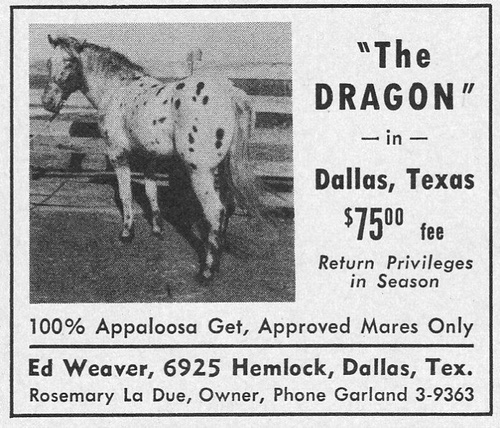
Another contradiction to Haines is Alvin G. Davis’ article, “Vive La Appaloosa!” (August 1971 Appaloosa News). Davis states to original spotted horses in Mexico, descendants of the Spanish horses, were known as “Winduri” or “Charaquis”. Davis goes on to note that these horses were never bred up, were allowed uncontrolled line breeding, and became poorly conformed ponies over many years. These spotted horses or ponies were found as late as the 1950s, in the states of Jalisco, Sinaloa, Sonora and Zacatecas. When the upsurge of interest in the Appaloosa horse was starting in the southwestern U.S., buyers went to Mexico and bought almost all of the spotted horses and shipped them back to the U.S. by the train car load. The Mexican states of Jalisco, Colimo, Nuevo Leon, Nayarit, and Tamaulipas are proven sources for Mexican Appaloosas that came into the U.S. Horses from Senor Moren (aka Moreno aka Moran) in Talaquepaque, Jalisco went into the John E. Baker program, as did horses from Senor Sesilio Alba, also from Jalisco (see below). The state of Tamaulipas gave us horses from Padro Garcia, Francisco Rodriguez and Manuel Garza Lopez (see below). Rafael Nievas, of the state of Nayarit sent horses, particularly Dragon, to the U.S. that had a large impact on the POA and Appaloosa. Horses from Pedro Vargas, in Nuevo Leon, also made a contribution. In the “Appaloosa Coat Color Inheritance” series, by Robert Miller, other Appaloosa color patterns are noted: the [Genetics of the Horse; Genetica, 1930] “Chubary” in England is very similar to the American Appaloosa, and [Pedro Sarciat’s “El pelo yaguane en el caballo criollo”, 1940] horses in South America also have a pattern similar to the American Appaloosa. Miguel Odriozola’s “A Los Colores del Caballo”, 1951, of the National Syndicate of Livestock, Madrid, classified Appaloosas into 2 groups- “atargrado” which is leopard and “Chubarie” which is blanket type. In the article “History of the Appaloosa”, author unknown, (6th Annual Mountain & Plains Appaloosa Horse Show Program, August 13/14-1960), it is noted that the spotted horses became the “Pintado” in Argentina, and were called “Quindure” in Mexico. An article, “Dick Spencer Photographs Appaloosas in Mexico” (unknown source), states that the Appaloosas are called “Wynduri” in Mexico and were considered a “raza” or breed and not a color. The term “Manchado” has also been used to describe spotted horses of Argentina, although this type is determined to be more of a polo pony type with heavy Thoroughbred influences.
The Mexican Appaloosas were in fact still being brought into the U.S. in the 1940s and 1950s and registered with the ApHC. Frank Austin, of Grapevine, TX, Pete Stout, of Brownsville, TX, and Jerry Randle, of College Station, Texas, sold Mexican Appaloosas in the Dal-Worth ApHC Club 1st Annual Southwestern Breeders Consignment Sale, October 1960. Robert C. Meyers sold Mexican Appaloosas in the September 1957 Mountain & Plains ApHC Sale, in Colorado. The Mexican Appaloosas, purported to be descendants of Austrian horses (which would bring the Knabstruber and Noriker into the mix) were small, and many found their way into the POA registry as well. Documentation of the Spanish ancestry of the Mexican horses has been given by the importer(s), as well as noted horseman/author Arnold R. Rojas {Pat Mefferd notes}. According to Jan Haddle research {via Pat Mefferd}, the first known “Spotties” were brought to Argentina in 1895. Other research by Rojas states that carloads of spotted horses were caught by Nevada and Utah mustangers and shipped into California long before there was a registry for spotted horses. [Note: The possibility of spotted horses from Utah and Nevada adds credence to stories like “The Kid” and Amasa Davidson, as well as actual Nez Perce stories of getting spotted horses from the Mormons].
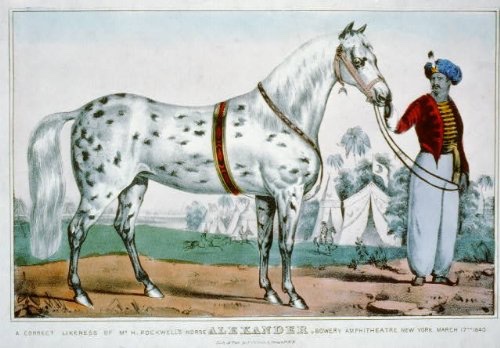
A different source for spotted genetics can be found in this advertisement—
An advertising lithograph shows the leopard horse Alexander, foaled circa 1830. The lithograph, which comes from an earlier Currier & Ives painting titled “A Correct Likeness of Mr. H. Rockwell’s Horse, Alexander, Bowery Amphitheatre, N.Y. March 1840”. The lithograph is titled “A Correct Likeness of Mr. H. Rockwell’s Horse, Alexander, Bowery Amphitheatre,
N.Y. March 17th, 1840”.
W.H. Rockwell owned the Rockwell & Company Circus. Alexander (also known as Majesty), was also used in Page’s Circus, purchased from Ohio in 1828, by Thomas Page, of Rutland, Vermont. Alexander’s spotted genetics have been traced into the Morgan breed, where spotted Morgans have been recorded and registered. It is interesting to note that the sire of Alexander, said to be Cox’s Arabian, came from Tunis, which is the same place that William Seward’s stallion, Omar, came from. Omar is the paternal grandsire of Killbuck Tom (aka Kilbuck Tom), whose spotted descendants can be found in both the Standardbred and Morgan breeds. Charles C. Jones wrote an article about Killbuck Tom, titled “Killbuck Tom - The True Story of a Famous Ohio Stallion”, which was published in the July 10, 1935 edition of The Horseman and Fair World magazine.
There is also the imported stallion Spotte, said to be a red leopard Barb. This horse is found in CRHA history, reported as having been imported from Algiers, North Africa, by the Cronin Horse Importing Company. The stallion was imported for the W.R. Thompson Cattle Company of Yuma County, Colorado, in 1918, as a wedding present for Thompson’s daughter. The CRHA Stud Book (combined Volumes 1-4) shows the bloodline of Spotte being carried on through a daughter named Spotted Babe (out of Hall mare [TB]), who is described as a “paint” in the handwritten records. Spotted Babe produced the stallion Ranger CRHA 4-P, who has numerous descendants in the registry.
BUT… records that equine historians overlook, because they do not fit into the “accepted” and preferred parameters of equine history and dispersion that have been promoted for so long, point to the Spanish bringing horses to the Americas and their dispersion throughout as being moot. Earlier historical records tell of horses already existing in the areas that the Spanish horses are so readily given credit for populating. In “Indian Horses BEFORE Columbus” longstanding records prior to the Spanish influx are brought to light. The Afghani Buddhist Monk, Hui Shen, has the oldest surviving travel account of an overseas explorer in the American Southwest, saying that the native people of ancient Mexico (Fu Sang) had horses and wagons during the 5th century AD. East Coast explorer Bjorn from Iceland reported seeing “Celtic Natives” or “Welsh colonists” on horseback in the 13th century. John Cabot, when exploring the East Coast in 1497 recorded seeing horse dung. When Jacques Cartier explored Quebec in 1535, natives reported a far West tribe that rode horses. Many other reports exist that argue the Spanish horse population theory used by Francis Haines and others.
In the book, Of Royal Blood, which details the history of the Missouri Foxtrotter, author Dyan Westvang adds information that also puts the Spanish horse history in the Caribbean and South America at odds with the ‘accepted’ norm. Westvang says that the Spanish breeding programs of the West Indies/Caribbean could not keep up with the demand of horses by Spanish explorers and settlers going to South America. The explorers, settlers and West Indies sugar plantation owners were demanding a better riding horse, than those being brought across the ocean. During the 1600s, the Spanish sent ships up to North American ports, with trade goods of rum, molasses and sugar, and passengers looking to buy gaited horses. The preferred horses for purchase by the Spanish were the Narraganset, the Galloway pacers, and the Canadian pacers. The Spanish ships would return to the West Indies with gaited horses for their breeding programs. The American breeders virtually sold out the Narraganset breed, whereas the Canadians did in fact keep stock to continue the Canadian Pacer breed. So many Narragansett and Galloway went into the Spanish breeding programs that those breeds were in fact interchangeable with the Spanish horse, itself. The Candian Pacer, the Narragansett, and the Galloway would go into the development of the Thoroughbred, Standardbred and Morgan, who in turn would go into the development of the Tennessee Walking Horse, the American Saddlebred, and the Missouri Foxtrotter. This “shared heritage” is also later found in the QH, Appaloosa, and Pinto/Paint. Were the North American horses the source of odd gaits in the later Appaloosa, and not the Spanish horses?
Getting back to the Mexican influences, it’s said that even the Appaloosa patterned Falabellas give credit for their spotted patterns from the native Criollo ponies and their far reaching Spanish ancestral influence. Even though there is speculation about some of the start of the Falabella, just as there is with many breeds, there is documentation since about 1900, as to the breeds that have influenced the Falabellas, and in turn the Appaloosa patterned miniatures in the U.S. today. In the article, “South American And Tropical Breeding Stock Raising in Cuba”, native Cuban horses are said to be of Arabian stock, introduced by the Spanish conquerors, who brought them from the Old World. Yet, in contradiction the Falabella site says there are no Appaloosas in the breed, but one takes that to mean there are no “Appaloosas” (as the breed), but there certainly has to be “appaloosas” in the bloodlines in order to get the color patterns.
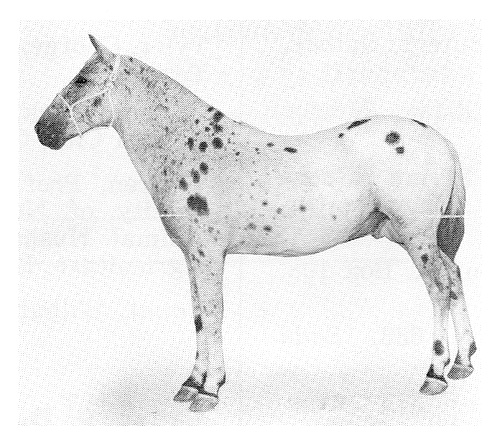
Dragon POAC 103
The American Indian Horse Registry has Appaloosa patterned and/or producing horses of Mexican ancestry too, through SMR (Spanish Mustang Registry) parentage, that trace the breeding back to Old Mexico and the Huasteca Indians. Mexican Joe SSMA 66/SMR 241 and Mexico SSMA61/SMR 240 are both from the Huasteca region of Mexico (like Dragon POA 103), where there were many Huasteca horses with appaloosa coloration and genetics.
POA and NAPI
The Pony of the Americas [POA], another spotted American breed, and considered to be the newest western pony breed in the U.S., claims part of its heritage from the Appaloosa, another part from Mexico and South America, and/or a combination of the two heritages. In the July 1974 Horse and Horseman article, “POA: More Than a Using Pony for Youth”, written by Mark Thiffant, the POA breed standard states the conformation of the POA is between the Quarter Horse and the Arabian, with Appaloosa color and characteristics. In the book America’s Horses and Ponies, the height requirements are ponies cannot be under 46 inches (11.2 hands) or over 54 inches (13.2 hands). In Eileen Schissel’s article, “Pony of the Americas” (July/August Horse Illustrated), Schissel notes the “imported herds of small appaloosa colored and characteristic ponies” from Mexico, Central and South Americas, which were used by some breeders as foundation stock for the developing breed. The registered POA mare Jasper Rose T6653, is shown to have a 51-inch flea bitten grey dam, called ‘Argentina’. [Note: An anomaly found in the POA Stud Books, is the 1952 leopard stallion Sierra Feather POA 4385, who was imported from Germany to California. His breeder Harry Schneuer, of Hamburg, listed his sire as ‘unknown’ and his dam as an ‘Appaloosa colored mare’. A popular POA sire in the U.S, Sierra Feather’s last foals were registered in 1968.]
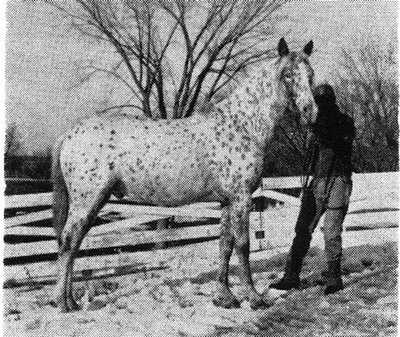
Holliday Dancer F-3110
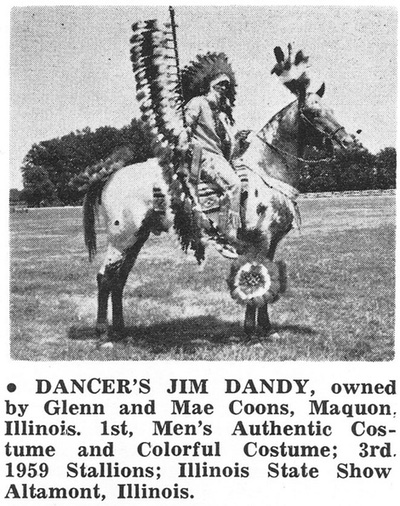
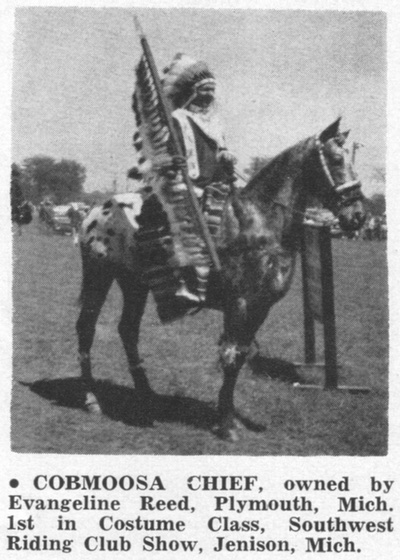
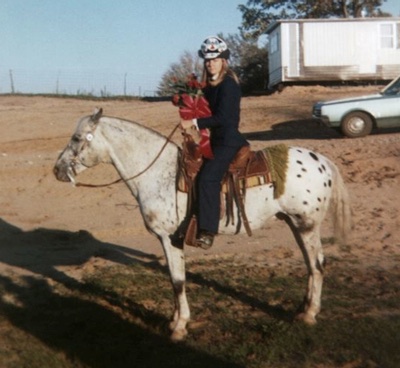
Quanah Parker
There was also the short-lived National Appaloosa Pony Incorporated (NAPI), in Indiana, which was in business the same time as the POA, Inc. An advertisement in the 9-1966 Western Horseman magazine, the NAPI stated that they registered “the most popular riding size pony… the Appaloosa Pony 40 inches up to 14 hands.” In the book America’s Horses and Ponies, the registry is called National Appaloosa Pony Association [NAPA] with height requirements from 40 inches up to 55 inches. The NAPI mantra is that the registry is “preserving the Appaloosa Pony” as found, as opposed to the POA which is “creating a new breed”. The 4th Annual National Appaloosa Pony Sale, held 4-8-1967 was promoted in the 2-1967 issue of the Horse Bits magazine. Many NAPI ponies were double registered in the POA. Registered Appaloosa stallions were sometimes used in NAPI programs. Holliday Dancer ApHC F-3110 (also sired POAs) and his son Dancer’s Jim Dandy ApHC F-3575 were used by the G-C Ranch (Appaloosa horses and ponies), owned by Glen Coons, Maquon, ILL. Dancer’s Jim Dandy’s sons, Dandy’s Running Otter ApHC T33049 and Dandy’s Redheart NAPI P1135 were also used in the program, and were crossed on NAPI daughters of Holliday Dancer ApHC 3110. Mary Tolan also bred and/or owned POAs that were double registered with NAPI- Tolanka’s Raindrop POA T2330 (Colimo line), Apple Jack POA T2140, and Tolan’s Peggy POA T4645. Tolan had other NAPI registered ponies, including Tolan’s Roan (to Dragon POA 103), Black Beauty T38, Tolan’s Pixie (Colimo line), Tolan’s Colimo, and Tolan’s Maggie.
POA registry records show breeders of the spotted ponies in areas where Appaloosa breeding operations were also located, as several Appaloosa breeders also bred POAs and/or NAPIs. Some prefixes and bloodline family names were well known in both the POA and Appaloosa including: “Miami” (Indiana), “Santee” (South Dakota- Gene Carr), “Nez Perce”, “Burnsides” (known for the imported ‘Argentine Appaloosas’ ), “Toyon” (Caifornia- Betty Veal), “Woodland” (Knudsons in Minnesota), “Alkhar”, “GRF” (Golden Rod Pony Farm), “Lannan’s”, Ed Vaughn (ApHC, ApHCC and POA), “Colimo” (John E. Baker and John Myres- ApHC and POA), “Tolan” and “Tolanka” (John and Mary Tolan- ApHC, POA, NAPI,AQHA, TB, and Welsh), “Dragon”, “Money Creek’s aka Money Creek” (ApHC and POA), “WayLo” (ApHC and POA), “Hunt’s” (Hunt’s Triple H, Iowa - ApHC and POA), “Dancer’s” and “Colimo” (Senor Sesilio Alba, Jalisco, Mexico), “D-D” or “D-D’s” (Dunn Brothers, Texas), “Hoaglund’s” (Clyde and Genevieve Hoaglund- ApHC and POA), “Amia” (Salvador Moreno and John E. Baker), and Rocking Chair” (F.W. Victor), “Moster’s” (W.F. Moster, Indiana - ApHC and POA), “Tejas” (Newton and Pearson Appaloosa Farm—POA and ApHC), “Missoula” (Howard Raser- ApHC and POAs), “Stump’s” (A.L. Stump- ApHC and POA), “Tyner” (Harold Tyner- ApHC and POA), “Creswell” (Creswell Farms ApHC and POA), “D-D” (Rafael Nieves), “Appalway” (POAs and ApHCC), and “Siri” (Paulla Cooper Kortsen). .
There are also name similarities between the POA and the Appaloosa programs that are in proximity of each other. There is a Cobmossa Chief ApHC T-28 and a Little Cobmossa Chief POA 3369 in Michigan. Pete Stout, of Brownville, Texas had Quanah Parker ApHC T-3057 and Quanah Parker POA T876. GRF’s Warhawk ApHC T12354 and GR’s Warhawk POA 778 (unknown parents)—possibility of sire of GRF’s Warhawk being GR’s Warhawk [Pat Mefferd notes].
Several registered Appaloosa stallions (ApHC and AAA) were used in POA breeding programs, because of their small size, including ** C.V. Frosty Timber ApHC T38928 (aka C.V.’s Frosty Timber AAA 400), Little Joe AAA 176, Appalo F-81, Arab Toswirah Alkhar F-2417, Bear Step F-3068, Chief Crazy Horse C F-3461, Chinook’s Waco F-1732, Money Creek’s Siri Rock 28606, Gumbo Ladd Chaco T-2314, High Thunderbird F-1822, Cimeron Chinook T-4552, El Morrocco F-18, H.W. Ocheye Chief T18249, Hard To Beat 76094, O.C.S. Lad T-4614 (to Dreamfinder), Peter K F-1054, Siri Shiek F-1733, Red Eagle’s Jr. T-4294, Son of Quanah F-2674, Tolanka T6759 (Mary Tolan), Twenty Three Leopard T13490, Tai-Pan of AA 68532 (Woodland’s), Bixby F-3270, Tip’s Polecat T56158, Red Sun Dog V 13370, Money Creek’s Lone Rock 68583, Kopfer’s Missouri Chief T-2168, Danley’s Eagle F-4399, Goblin T-1875, King Kingston T39986, Dude Dandy Sr. F-3325, Al’s Son of Little Man S F-3326, Money Creek’s Sundance II 38821, McCue Fe ID-57 (by Joker B F-678), Rocket Bars T44467, Siri Spotted Cord T83506, Holliday Dancer F-3110/T-611, and Buky Star F-2271, to name some.
[NOTE: ** C.V. Frosty Timber ApHC T38928 (aka C.V.’s Frosty Timber AAA 400) is listed as a sire of POAs with the designation AAA 400. I inquired to the POA registry about the AAA designation to determine that it was in fact the American Appaloosa Association and did not receive any knowledgeable answer as to what it stood for. The current officials had no answer. An older retired official ventured an incorrect guess that AAA meant the horse was a noted race horse. I later found verification of AAA in another POA Stud Book issue. [C.V.’s Frosty Timber was also listed as CAHC 400 in a POA Stud Book entry. I assumed that meant the Canadian ApHC, but upon checking the ApHCC stud books for verification, it was not correct.]
One needs to know that since POAs and NAPI registrations were limited by height regulations, if a pony grew too tall, it was cancelled from the respective registry. Some of these voided horses were still used in POA programs. Some would be registered with the ApHC, despite their known pony breeding. Sometimes the pedigree information was changed to remove the pony breeding verification. A few such horses include: Hunt’s Siwash ApHC T-2272/POA T911, Tolanka Jr. ApHC T21816/POA T5564, Boca Grande POA T877/ApHC T10038, and Tolanka’s Squaw ApHC T21818/POA T5840. One can only wonder how many voided POAs, or even registered ones, went into the Appaloosa breed, as ‘unknown’ or unregistered appaloosa colored animals, or under a different name.
Boca Grande POA T877/ApHC T10038 sired several registered POAs, along with registered Appaloosas, including Stout’s Peak T9464, Stout’s Tamie T9350 (dam of: Spotted Reputation 24640)AN 3-65:63*, and Boca Chico F-4144(who would also sire POAs). This bloodline also went into the American Appaloosa Association [AAA later AApA]. Colimo’s Desna Teck, owned by John E. Baker, Oklahoma, was double registered POA 819/ApHC T8340- [NOTE: the POA Stud Book shows her sire as Dragon #103, while the ApHC Stud Book “cleans up” her pedigree, saying her sire is an “Appaloosa”].
An oddity that I have found in talking to family members of some early POA breeders or reading about POA breeders is that some of them did not know about the ApHC/Appaloosa horse until later, and therefore did not know what to do with their oversized colored ponies. Some of those breeders, who learned about the Appaloosa, then went away from POAs and into Appaloosas, so they could have a larger more usable horse and still maintain the spots. With the ApHC being formed years before the POA Inc, it seems strange that the ApHC was unheard of until the 1950s, after the POA, Inc. had been formed.
PONY OF THE AMERICAS WITH PROVEN MEXICAN ANCESTRY
[NOTE: Although this article is supposed to be about Mexican bloodlines in Appaloosas, I felt it necessary to include the POA as they are connected]
DRAGON—DUNN BROTHERS PROGRAM
The most well-known registered POA of Mexican ancestry is the POA Hall of Fame stallion Dragon #103, bred/owned by Rafael Nieves of McAllen, Texas, and later of Guadalajara, Mexico (as per POA stud books). Pat Mefferd research says that the stallion may have been known as “Dragon”, “The Dragon” and even “Dragoon”. The POA Stud Book shows he was later owned by Hunt’s Triple H Ranch, Fairfield, Iowa. It is not sure when the Dunns acquired the unregistered stallion, but another version of the story of Dragon, shows that Nieves was actually the importer of the stallion, and that he went directly to the Dunns (D-D Ranch). Somewhere along the line, the unregistered stallion “The Dragon” was owned by Rosemary La Due, of Garland, Texas, in 1955 (was he sold by the Dunns ??), which brings up the possibility that “Dragon” and “The Dragon” could be different horses. Dragon, Dragoon, and The Dragon can also be found as sires of registered Appaloosas. Dragon was heavily used in the Dunn Brothers (Ellis E., C.J., Roy, and Ernest C.) POA program. POA and ApHC breeder John F. Myres also used Dragon (et. al.). Robert Miller of Lockridge, Iowa, POA breeder and owner of Ta Tanka Gleska POA 6, also bred to Dragon. Pombo and Sons, Hunt’s Triple H, and Golden Rod Pony Farm all used the D-D line(s) in their programs.
Rafael Nieves, then of McAllen, Texas, is credited as the breeder for D-D Lady No.4 POA 63, D-D Lady No. 5 POA 64, D-D Lady No. 7 POA 66 (owned by E. Dunn), D-D Lady No. 8 POA 67, D-D Lady No. 10 POA 69, D-D Lady No. 14 POA 73 (owned by Ross Bradford, Utah), D-D Lady No. 16 POA 75 (owned by E. Dunn), D-D Lady No. 20 POA 80 (owned by E. Dunn), D-D Lady No. 23 POA 82 (owned by E. Dunn), D-D Lady No. 24 POA 83 (owned by E. Dunn),D-D Lady No. 30 POA 89, D-D Lady No. 33 POA 92, D-D Lady No. 35 POA 94 (owned by E. Dunn), D-D Lady No. 36 POA 95 (owned by E. Dunn), D-D Lady No. 38 POA 97 (owned by E. Dunn), D-D Lady No. 39 POA 98, D-D Lady No. 40 POA 99, D-D Lady No. 41 POA 100, and D-D Lady No. 48 POA 107 (owned by E. Dunn), all sired by Dragon POA 103. Nieves is also the breeder of D-D Kiowa POA T104 and D-D Keyantha No. 47 POA T106. Dragon would sire the stallion Dragon’s Champion POA 410, out of the mare D-D Lady No. 7, and Dragon’s Champion would sire the stallion Dragonfly POA T4368, out of a Mexican Appaloosa.
Ellis Dunn used the Dragon bloodline for many years, using Dragon himself to sire many pony foals, both registered and unregistered. Ellis Dunn used the prefixes “D-D” or “D-D’s” (stood for D Bar D, later prefixes included “Debardee” and “Deebardee”) on both his registered and unregistered ponies. There are more than 100 ponies carrying the D-D prefix in the POA Stud Books. Dragon was often bred back to his daughters. Dunn had at least 74 registered POAs, with the D-D prefix, sired by Dragon POA 103. He bred the mare Dragon’s Little Doll POA T438, sired by Ta Tanka Gleska POA 6, dam was not named, but assumed to have been sired by Dragon. He also had 18 other D-D prefixed registered POAs, none of which had a pedigree. Some of the D-D ponies had their sires and dams listed as “grade Appaloosa”. Ellis Dunn also had at least one “Colimo” POA in his program- Colimo’s Lady of the Snows POA 816. Dunn also the breeder of several POAs sired by the noted POA stallion Ta Tanka Gleska POA 6, who was owned by Robert Miller of Lockridge, Iowa. Dunn also had a mare, Gentry’s Koko Cacique POA T4459, that was sired by the Mexican blood-lined horse Boca Chico ApHC T8429, out of a daughter of Dragon POA 103. Dunn would later use D-D Dragon POA T255, a son of Dragon POA 103. Ellis Dunn also bred POAs that were registered by the owners, and not by Dunn—Hunt’s Wrangler Joe POA 47, Hunt’s Chica Roja POA 51, Hunt’s Chica Poca POA 50, Hunt’s Bull Bat’s Estrella POA 49, and Hunt’s Bull Bat’s Senora POA 48, all without parentage, were registered by Hunt’s Triple H program. One would assume that the latter two ponies, with the “Bull Bat’s” designation were sired by Bull Bat ApHC T-954, a son of Dragon POA 103. Hunt’s Bull Bat’s Senora POA 48 would later produce Hunt’s Mahaska POA 1782 and Nik’s Siri Strawberry POA T10151, who sired by Siri Super Chief POA 528—combining Mexican and Argentine genetics. Dunn also bred Creswell Sparrow POA T1149, out of the mare D-D Lady No. 54 POA 266. [NOTE: Creswell Farm bred the POA mare Hex Hill Chance T4047, sired by High Thunderbird F-1822/CRHA, out of D-D Lady Alsama POA 588. Creswell Farm owned the POA mares D-D’s Blue Kitten 388, D-d’s Cherokee Ann 391 (by Dragon), D-D’s Bright Eyes 923, and D-D Lady No. 54 266].
Ellis E. Dunn’s Magic Valley’s D-D Pony Ranch {NOTE: first D is backwards}, at Irving, Texas, had a full-page advertisement in the (Frank Fichte) Appaloosa Journal, April 1960, May 1960 and June 1960, promoting “three generations of Ponies of the Americas”. The ad featured photos of Dragon POA 103, D-D Dragon POA T255 and D-D Dragon’s Dragnet. Another such ad is found in the August 1960 issue of the same magazine, with a photo of D-D Dragon POA T225. [NOTE: discrepancy in registration number in 8-60 and 4-60 and 5-60 and 6-60]. Dunn’s Magic Valley D-D Ranch had a full-page ad in the January 1961 (Frank Fichte) Appaloosa Journal, promoting Boca Chico at stud, POA and Appaloosa stud service, and “some of the top Shetland Ponies and Ponies of the Americas in the nation”. The ranch also had a full- page advertisement in the February 1961 (Frank Fichte) Appaloosa Journal, promoting both POA and Appaloosa stud service.
Ellis’ brothers, Ernest, Roy, and C.J. were active and well known POA breeders who used the bloodline of Dragon POA 103. C.J. Dunn was a member of the POA, Inc. Board of Directors in 1959. Ellis Dunn served on the POA, Inc. Board of Directors in 1958 and 1960. Roy Dunn sometimes used the prefix “4D’s”, and bred 4D’s Rising Star POA 780, sired by Dragon. Ernest Dunn owned ponies with the “Diamond D”, “D-D”, and “Avalon” prefixes; the Diamond D and D-D ponies had no pedigrees. C.J. Dunn and/or later the C.J. Dunn Estate bred ponies with the “Avalon” [Note: Avalon is also a Shetland pony program prefix, and the Dunns did use Shetland mares] and “Dillon’s” prefixes, as well as others- Avalon’s Bay Beauty POA T447, bred by C.J. Dunn, a son of Dragon POA 103, sired 19 registered POAs; Avalon’s Little Doll POA T445 was also sired by Dragon; Dillon’s Ha-Wee-Yah POA T497 and Dillon’s To-Yah POA T498 were both sired by Dragon; Cisco Kid POA T241 was a son of Dragon; Chester Good POA T299 had no pedigree. C.J. also owned the stallion Chief War Smoke POA T243, a son of Dragon POA 103.`
COLIMO
The “Colimo” line of POAs was also common in the breed. The line seems to have originated with Senor Sesilio Alba, of Jalisco, Mexico. It has not been determined if the name Colimo came from the Mexican state of the same name, or from the volcano of the same name. The state of Colimo shares approximately 75% of its northern border with the state of Jalisco, which is a proven source of many Mexican Appaloosas and ponies. The volcano called Colimo, which is active, is over 13,300 feet in height and located about 125 kilometers south of Guadalajara, Jalisco, Mexico. Most of the volcano actually lies in the state of Jalisco, with only a small part being in the state of Colimo.
Some of the early ‘Colimo” ponies have no pedigree, while others have ‘Mexican Appaloosa’ parents. Later, as generations built up, pedigrees became more common in the registry records. Senor Alba is credited for breeding Colimo Tearbac POA 332, a well-known sire in Chandler, Oklahoma area.
John E. Baker, the Dunn Brothers, John F. Myres, and John and Mary Tolan bred and/or owned “Colimo” POAs. Some of these ponies carried the Dragon bloodline. In the July 1988 Appaloosa Journal article “The Man With The Golden Touch”, by Debbie Pitner Moore, John E. Baker says that he “imported horses from Mexico by the semi load”, and states that “a lot of them are in POA pedigrees today”.
John E. Baker, of Oklahoma City, Oklahoma, bred and/or owned Colimo’s Blue Warbler POA T837, Colimo’s Pegmar POA T851, Colimo’s Walvis White POA T825, Colimo Choc Tau (aka Colimo Choctaw) POA T483, Colimo’s White Lip POA 812, Colimo’s Blue Polly POA 813, Colimo’s Redbird Fleet POA 814, and Colimo’s Madcap Pixie POA 815. Colimo’s Madcap Pixie POA 815 was later owned by Mary Tolan, and produced both POA and NAPI registered ponies. Colimo’s Madcap Pixie POA 815, listed as an ‘unregistered mare’, also produced the registered Appaloosa Stoneacres Raindrop T103829 (Mary Tolan program).]
John F. Myres, of Irving, Texas, was a well-known breeder of “Colimo” ponies, having bred Colimo’s Blue Warbler POA T837, Colimo’s Walvis White POA T825, Colimo’s Fadeaway POA T824, Colimo’s Silky Imp POA T823 (by Dragon POA 103), Colimo’s Little Man POA 678, Colimo’s Robin Lass POA 818, Colimo’s Desna Teck POA 819/ApHC, Colimo’s Lady of the Snows POA 816 (owned by Ellis Dunn), Colimo’s Blue Polly POA 813, and Colimo’s Redbird Fleet POA 814.
AMIA
The “Amia” prefix can be found originating with the program of Senor Salvador Morena (aka Moren or Moreno), of Talaquepaque, Mexico (have also seen ‘Old Mexico’). John E. Baker had registered Appaloosas tracing back to “Moren Appaloosa”. Morena/Moren/Moreno is listed as the breeder of Amia’s Black Satin POA T482, Amia Black Raven POA T481 (Mrotek program, WIS), Amia’s Pitty Pat POA T480 (Mrotek program), Ammo R.A.G. Totten No. 1 POA 465, and Amia’s Valley Runner POA 479. Some of the Amia ponies would go on to produce ‘Colimo’ line POAs.
HAROLD DOTY PONIES-----
A large breeding herd of Appaloosa horses and ponies of Mexican and South American ancestry has been said to have existed in a Missouri program started in the 1950s or 1960s, by Harold Doty. It is said that the herd’s size ranged from 45 inches to about 14 hands- the taller horses/ponies were from Argentina, while the smaller ponies were from Old Mexico. People familiar with the program claim that it produced consistent color, with only about 5% solid production, in over 60 years of breeding. Doty purchased the Mexican stallion JB’s Silver Peso ApHC T-7936 to start the program, with unregistered mares. JB’s Silver Peso was shown to be unregistered, when he sired Sky Chief POA T2156 in 1960 [NOTE: Sky Chief was recorded as being bred by Ross H. Gerber, Smithville, OH; owned by Andy Izzo, Waterbury, CONN]. JB’s Silver Peso also sired Speckald Maiden ApHC T33492, who was also bred and owned in Ohio, and Doty’s Irene T30203 (J.B.’s Silver Peso T7936 X Doty’s Blue -NR-). Doty’s Irene produced the ApHC registered stallion Batten’s-Go-Man T144862, the ApHC registered mare Chocolate Sundae T198148, and is said to have produced some unregistered horses. The mare, Beouf River Squaw 30204 (JB’s Silver Peso T7936 X Gray Gal), was owned by Doty and used in his program. A pedigree on ABDB shows Beouf River Squaw’s dam, Gray Gal, to be a product of “Doty Appaloosas”, but the ApHC database shows her parentage as unknown and doesn’t list a breeder in the Stud Book. The ApHC Database shows that H.L. Doty was the original owner of JB’s Silver Peso, and no other owners are listed.
Later it is said Doty purchased ‘imported’ horses and ponies through an auction, possibly in Louisiana. He added the Argentine stallion, Burnside’s Lad T12667, and supposedly an unnamed Argentine mare as well. This part of the breeding program will be discussed under “Argentina” below.
Although people in the area have claimed to have seen up to 300 horses/ponies in the Doty program, very little record of their existence can be found. It is claimed that a fire destroyed all of the papers for the horses and ponies, and that the registries would not give Doty replacement papers for the horses. Yet, in researching the first 10 volumes of the POA Stud Books, only one Doty pony was found—Chippewa’s Sootie (m) POA 11043 (fld 1961); bred by Harold Doty; parents both listed as “small Appaloosa”. There is at least one pony descendant of the Doty program registered with the International Champagne Horse Registry (ICHR), named Hills Classic Lil Duece, said to trace to the Doty pony program through his dam Five Hills Sheena.
OTHER LINES
The POA stallion Zorro #290 (unknown parentage), was bred by Henry Guerra, of Reynosa, Mexico, and owned by Leo Dunne (not of the Dunn Brothers), in Iowa. He sired several registered POAs for the Carl Lange program in Iowa and one for the Mary Tolan program. Guerra also is the breeder of the mare R-K’s Happy Dot POA T1179.
Victor Vasquez, of Quadaljeal, Mexico is listed as the breeder of F.K.’s Pancho POA 3562. F.K.’s Pancho was sired by Pancho (53-inch colored Appaloosa), out of the mare D-D Lady Ada POA 587 (sired by Dragon POA 103).
Many registered POAs showed Mexican parentage with such pedigree entries as “Mexican Appaloosa”, “47 inch bay Mexican mare”, “Mexican leopard Appaloosa”, “Mexican stallion”, “Mexican mare”, “Mexican Appaloosa pony”, “Mexican Appaloosa marbleized roan”, “Appaloosa colored Mexican mare”, “Mexican pony” , “Mexican bay leopard Appaloosa”, “Old Mexico mare”, “grade Appaloosa -Mexican breeding”, “brown roan Mexican Appaloosa”, “red Roan Mexican Appaloosa”, “Mexican bred”, black/white blanket Mexican Appaloosa”, Spanish mare”, and so on.
One should consider that the American names of some ponies could suggest their possible Mexican origins. Few of these imported ponies may have had names, and therefore were named by their new owners. Also, some may have been given a different name after they crossed the border. It is also possible that the person named as the ‘breeder’ in many of the registrations, may well have been the importer of the ponies, and the only person the new owners had contact with. The actual breeder may or may not have been known.
Other POAs showed possible Mexican heritage through their listed breeders, as pedigrees are not provided in the registry records. Chief of Nevada POA 1308 was bred by the Santa Anita Ranch of Guadalajara, Jalisco, MEX. Lopez Martinez, of Antlan, Guadalajara, Mexico bred Barnes’ Aztec Buck POA 873 and his son Barnes’ Aztec John POA 874. Sally POA 861 was bred by Carlos Ortega, also of Guadalajara, Mexico. Alfredo Cardenos, of Colimo, Guadalajara, Mexico, bred Barnes’ Aztec Kathy POA 872 (dam of Barnes’ Aztec John POA 874). A Jac Jac King POA 435 has his breeder listed as simply Gonzalles, of Guadalajara, Mexico. Hector Vasquez, of Quadalajara, Mexico is listed as the breeder of Oldham’s Minute Man POA T1896. True-Sun POA T620 was bred by Margey Farmer, of Atoyac, Mexico. Other POAs showing a possibility of Mexican descent through their names are Old Mexico POA T754 and Bud’s Mexican Princess POA T648.
APPALOOSAS OF PROVEN MEXICAN ANCESTRY
AUSTIN ----
The breeding program of Dr. Frank Austin, Grapevine, Texas, known as the Austin Patio Ranch (since 1830) used “Mexican Appaloosas”. His program promoted “Foundation mares chosen for conformation, color and disposition with pure bred (undiluted) bloodlines from which all American Appaloosas were derived.” Robert Denhardt says that Austin owned the unregistered QH sire Skeet (Yellow Wolf X Parrott Mare by Buncombe), whose lines comes from the Waggoner program.
There were several “Austin” horses registered in the ApHC: Austin’s Don Pancho T10070, Austin’s Buckwheat 1-3 T17380, Austin’s Yankeee Doodle 1-18 T17390, Austin’s Tic Toc 1-14 T17387, Austin’s Tiquita 1-13 T17386, Austin’s 1-10 T17385, Austin’s 1-9 T17384, Austin’s Duce Tray 1-8 T17383, Austin’s 1-6 T17382, Austin’s 1-5 T17381, Austin’s Snow Wing 1-2 T17379, Austin’s Ninety-Four T10077, Austin’s Ninety-TwoT10075, Austin’s Christene T23423, Austin’s Ninety-Eight T10365, Austin’s Rita 1-7 T23417, Austin’s Geronimo 1-11 T23418, Austin’s Candy Man 1-19 T23419, Austin’s Lorrie T23420, Karen’s Kookie T23421, Sheba’s Shiek 23424, and Austin’s Revelie T23422. Pedigrees provided in the 10-29-1960 Dal-Worth 1st Annual Southwestern Breeders Consignment Sale catalog, show the ApHC mares Austins Sixty Six T10079, Austins Ninety-Three T10076, and Austins Ninety Eight T10365 as having “Mexican Appaloosa” sires and dams. The ApHC Stud Book entries for the same mares show the pedigrees have been “cleaned”, with all parentage listed as UNKNOWN. There were three other ‘Austin’ horses registered with ApHC with UNKNOWN parentage. The Stud Books also show several unregistered ‘Austin’ horses in the listings- Austin’s Chris, Austin’s App Mare 69, Austin’s App Mare 68, Austin’s Lady, Austin’s App Mare 65, Austin’s Karen #21, Austin’s Sheba, Austin’s Revelon #25, Austin’s Pancake Twenty-Six, Austin’s Sixty-Three, Austin’s Thirty-Six, Austin’s Twenty-Nine, Austin’s Thirty-Two, Austin’s Thirty, Austin’s Ninety-Six, Austin’s Gray Lady, Austin’s Seventy-One, Austin’s Thirty-Seven, and Austin’s App Mare 64. Any of the unregistered horses could have Mexican ancestry as well. The Austin lines can be found in the pedigrees of Princess Neko 470240, My Nesler Bar 517402, LH My Candi Girl (aka My Candy Girl 551788 as per ApHC), and LH Little Muffin Bar (aka Little Muffin Bar 551787 as per ApHC).
Austin also stood the stallion Sequahia, sired by Dragon, out of “Foundation mare” by Dragon, according to an advertisement for his Austin Patio Ranch, in (Frank Fichte) Appaloosa Journal, May 1960. The same advertisement runs in the April 1960 issue of the magazine, but the stallion’s name is spelled Sequaria.
DRAGON/THE DRAGON/DRAGOON
Dragon aka The Dragon aka Dragoon has been discussed in the POA section above, as his production of POAs was far greater than Appaloosas. Dragon is said to have come from the Huasteca region of southern Mexico and is actually considered to be a Spanish Mustang by those who fancy that breed.
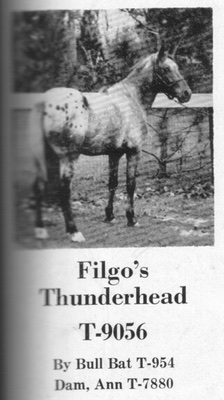
“Dragon” (listed as unregistered) is credited with being the sire of these Appaloosas- Debardee Floreska, Estelita T9473, [NOTE #1: *I have pedigrees that shows this Estelita being sired by “Dragoon”] [NOTE #2: Estelita produced the mare D-D’s Tico Frosty T28838 and the stallion D-D’s Tico Joe T28839 (both by Myres Tico Tico 8853)], owned by Ellis Dunn. , D-D Mazatlan T2602, Bull Bat T954, D-D Vicam T2599, D-D Esperanza T2604, Dunn’s Silver Lady T6253, Dunns Lady Blue T6255, Dunn’s Red Bird T6257, and D-D Sinaloa T2603, to name some. Pat Mefferd research says Dragon had 15 ApHC foals. The “D-D” prefix horses were bred and/or owned by Ellis E. Dunn.
“The Dragon” is credited with siring the ApHC registered horses Dragon Fly 4728 (dam of Chinook’s Dragon 4729), Hazelwoods Dixie Lee T6775 (dam of Spot Model T60941), Debardee Tiemipo T2189 (aka Debardee Tienipo on ABDB), Deebardee Amia (aka Debardee Amia) T2190 (bred by Jesus Herreria, Guadalajara, Mexico; owned by John Myres), Teewa T563, Cloud Dancer T564/F3172, Debardee Amia T2550, Dragon’s Concho T780/F3173 (dam of Johnny Ringo F3174 and Chief Bear Track F3157), Prairie Lark T952, [NOTE 1: Prairie Lark T952 is shown to be sired by Dragon in the ApHC Stud Book, but sired by The Dragon in the 9-7-1957 Mountain & Plains ApHC Sale catalog.], Bull Bat T954, [NOTE #2: Bull Bat T954 is shown to be sired by Dragon in the ApHC Stud Book, but sired by The Dragon in the 9-7-1957 Mountain & Plains ApHC Sale catalog, ABDB, and www.pedigree.appj.com.] Debardee Quanda and Dragon’s Princess T578. Pat Mefferd research says The Dragon had 11 ApHC foals.
Ellis E. Dunn used Bull Bat T954 to sire several registered Appaloosas including: Bull Bat’s Dallas Dandy T8169 and Bull Bat’s Hombre T8438 (both out of the E.E. Dunn mare D-D Lady Miss Dallas T7883- unknown parents), D-D’s Lady Hazel T7871 (out of the E.E. Dunn mare D-D’s Flashy Belle T7791- unknown parents), Filgo’s Thunderhead T9056 {AN 1-1962} (out of E.E. Dunn mare D-D’s Lady Wild Ann T7880- unknown parents), Oklahoma Papoose T9762 (out of E.E. Dunn mare Oklahoma Gal T4547), D-D Poca Tello T4547 (out of D-D Mazatlan T2602), D-D Atomic Cloud T4548 (out of Cooterville Cloudburst T494), D-D Columbus Day T4549 (out of Cooterville Cocoa T495), D-D Apache T4550 (out of Cooterville Yellow Mex T836), D-D White Man T4788 (out of D-D Lady 23 -NR-), D-D Yellow Boy T4789 (out of D-D Lady 41 -NR-), D-D Joker T4790 (out of D-D Lady No. 5 -NR-), Bull Bat’s Pride T13807, Bull Bat’s White Flash T25434, D-D Cindy Ann T31114, D-D’s Sunbeam T31115, D-D’s Brown Gal T31116, and D-D Mex T4551 (out of E.E. Dunn mare D-D Sinaloa T2603). [NOTE: Creswell Farm sold the unregistered mare Isoletta in their 1965 dispersal sale. Description of this mare is that she is “too small to register”. Her sire is an unregistered “small Appaloosa” named Sparrow Hawk. Her dam is Lady Isola, an unregistered daughter of D-D’s Lady Miss Dallas.]
Ellis Dunn also bred and/or owned many registered horses that had no pedigrees, either “unknown parents” or simply “Appaloosa parents”, including D-D Gonora T2600, D-D Obregon T2601, Oklahoma Gal T4547, D-D Mattie Lou T4786, D-D Bertha May T4787, Dunn’s Moon Glow T6254, Dunn’s Roan Lady T6256, Dunns Cherry Blossom T6258, Dunn’s Blue Judy T6259, Dunns Blue Freckles T6260, Dunn’s Blue Fire T6261, D-D’s Flashy Belle T7791, D-D’s Lady Terza T7876, D-D’s Lady Kewanee T7877, D-D’s Lady Soso T7878, D-D’s Lady Desdesmona T7879, D-D’s Lady Wild Anne T7880, D-D’s Lady Lucedale T7881, D-D’s Lady Fly Low T7882, D-D’s Lady Miss Dallas T7883, D-D’s Lady Miss Dorothy T7884, El Diablo T8432 (used as stallion by Dunn), D-D’s Lady Ovett T8926, D-D’s Lady Juliet T8927, D-D’s Lady Itta Bena T8930, D-D’s Lady Winona T8931, D-D’s Lady Pocahontas T8932 (dam of D-D’s Feathers 31113), D-D’s Lady Rita T8933, and D-D’s Babe T44441.
Ellis Dunn also owned the stallion Boca Chico F4144/T8429 (maternal grandson of Dragon or Dragoon), bred by John F. Myers. Boca Chico has also been listed as being owned by Pete Stout. Horses sired by this stallion, under Dunn’s ownership include: D-D’s Boca Boy T12491, D-D’s Boca Grande T12492, D-D’s Boca Pancho T12493, D-D’s Boca Chief T12494, D-D’s Boca Man T12495, D-D’s Feathers T31113, and D-D’s Boca Ace T12496. D-D’s Feathers 31113 descendants include Norsta Apache Snocap 613764, Flaming Joker T352008, Dakotas Shadow T337016, and Norsta’s Blackjack N555376.
Ellis Dunn bred and used the stallion Cimeron Chinook T4552 (Simcoe’s Chinook F1610 X D-D Gonora T2600) who sired 50 foals according to ApHC records- all colored. He is also listed as owning the stallion Charlie Horse D T44442 (by Hands Up F2217), who would sire the mare D-D Seranade (aka D-D Serenade) T44440.
COLIMO
“Colimo” is a program/herd prefix for John E. Baker. Baker also used “Dancer’s”, “Amia”, and “Co-“ prefixes. No doubt the name “Colimo” originated in Mexico, and probably designated bloodlines from a particular ranch or area. Baker owned many “Colimo” horses, some of which had no proven ties to Mexico heritage, and some were even bred by others. Baker owned Colimo’s Beartrap T6516, Colimo’s Bright Star T7748 (out of Colimo’s Mother Star -NR-), Colimo’s Star Bright T7749, Colimo’s Osage Queen T7751, Colimo’s Chrystal Clear T7753, Colimo’s Bravo Mio T8163, Colimo Miss Pert T8164, Colimo’s Desna Teck POA 819/ApHC T8340 [NOTE: Colimo’s Desna Teck POA 819/ApHC T8340. POA Stud Book lists sire as Dragon POA 103. ApHC Stud Book lists sire as “Appaloosa”.], Colimo’s Blue Slate T10536, Colimo’s Blue Sunstar T10968, Colimo’s Regal Lily T10969(bred in COL), Colimo’s Kit T10972, Colimo’s Fable Quick T10971, Colimo’s Sharri Bee T10972, Colimo’s Charm T11615 (sire is ApHCC), Colimo’s Silver Shine T11829 (sire is ApHCC), Colimo’s Bully Moon T11830, Colimo’s Blue Jayness T11831 (by High Hand F3366), Colimo’s Polka Queen T11832 (sire is ApHCC), Colimo’s Bit-O-Tart T11833, Colimo’s Red Tulip F4170/T11834, Colimo’s Dari Twig 11835, Colimo’s Black Orchid T11836, Colimo’s Golddigger T12397, Colimo’s Snow White T6514, Colimo’s Black Satinteen T11839 (sold in 4-1963 Stroube Appaloosa Horse Ranch sale), Colimo’s Drifting T11840, Colimo’s Snow White T6514, and Colimo’s Widow Maker T12398.
There was a stallion, of apparent Mexican heritage named Colimo, that sired horses owned by Baker that had the “Dancer’s” prefix (see below). The mare Flank’s Paradise Lass T5940 (dam was “Alba” breeding—see below), was sired by Colimo, and owned by Baker.
Baker bred POAs with the “Colimo” prefix. John Myres also bred POAs with the ‘Colimo” prefix, with ponies going to the Dunn’s D-D or Deebardee program, the John E. Baker program, and the John and Mary Tolan program.
Later, Baker’s Appaloosa program would handle many stallions and mares throughout the years, with a large turnover of horses, as to many he would have been classified as a “horse trader”. Baker owned the mare Juanita M T21700 (aka Juanita -NR-), who is said to be the dam of the great progenitor Mansfield Comanche F3096. The “M” was added when Baker registered her, as there was already a mare registered as Juanita (F339). One would have to wonder if the “M” stood for Mansfield. One of the purchasers of a horse or horses from the Baker Ranch were the Page Brothers, of Elk City, OK, who were also POA breeders, using the bloodlines of the Pete Stout bred stallion Boca Grande POA T877/ApHC T10038. The Page Brothers had POAs of recorded Mexican ancestry.
ALBA
The “Alba” designation came from the stock of Senor Sesilio (have also seen Cecilio) Alba, of Jalisco, Mexico. “Alba” lines can be found in the “Dancer’s” stock (see below), owned by John E. Baker. Baker also owned the “Alba” bred mare Gray Flank T5939 and her daughter Flank’s Paradise Lass T5940 (by Colimo -NR-). Flank’s Paradise Lass would produce Colimo’s Lasso 20429 and Little Lass T34738 (dam of De-La-Mac T153943. Colimo’s Lasso, bred by Bill Hudlow, Shawnee, OK, produced Colimo’s Kelly T95419 and Colimo Shiloh 134215.)
MOREN
The Moren aka Moreno aka Moren’s aka Morena Appaloosas were of unregistered stock of unknown parentage, bred by Senor Salvador Morens (or one of the aforementioned names, depending on the source used). Morens, et.al. was from Talaquepaque, Mexico. The “Moren’s Appaloosas” produced/sired the “Amia” line of Appaloosas, as well as the “Amia” line of POAs. John E. Baker, described as “a breeder who’s raised more world champion Appaloosas than anyone”, owned the registered Appaloosas Amia Turkey Wings T6521, Amia’s Yellow Dust T6515, and Amia’s Larkspur T6517. One would have to wonder if size was the only difference between the “Amia” POAs and Appaloosas.
DANCER’S
The “Dancer’s” line of registered Appaloosas is only a few horses- Dancer’s Princequillo T5284, Dancer’s Snow Back T5283, Dancer’s Blue Back T5282, Dancer’s Strawberry Sunny T5279, Dancer’s Tabby T5414, and Dancer’s Toddy T5274. All were bred by Senor Sesilio Alba, of Jalisco, Mexico, and owned by ApHC Hall of Fame member John E. Baker, of Oklahoma City, OK. The first 5 horses are sired by the unregistered stallion Colimo (see above), out of an ‘Alba Appaloosa mare’ (see above). The final horse has both parents listed as simply ‘Alba Appaloosas’. Dancer’s Snow Back was later owned by Mar-C Farms #1. Baker owned Dancer’s Joy Blue T6615 (sired by The Dragon POA), but the ApHC Stud Book does not list a breeder. Baker also owned Dancer’s Spring Dawn T6620, for which the ApHC Stud Book lists the sire an “Appaloosa” and doesn’t give a breeder- so it cannot be determined if this is actually a Mexican bred horse. Baker also owned Dancer’s Tailflutter T5281, Dancer’s Dora T5280, and Dancer’s Arizonian Queen T5278, all with “Appaloosa” parents. Dancer’s Cover Ground T5277, with “unknown” parents was also owned by Baker, who has been touted as “an Appaloosa expert”.
Dancer’s Tabby has progeny through a daughter M-B Cathy’s Choice 21629, going to Megins Flame 443659, CR Mystic 445363, CK Mighty Magoo 473742, Mighty Joe Bright 612184, CK Ladys Contessa 367226, Mighty Grand To Me 658502, Sherwoodssimplemight 636035, CK Mystical 532787, Lyka Bright Star 602150, Rock Canyon Cleatus 642337, Lauras Elegant Might 642337, and Ima Mighty Rockette 612137.
AMIA
The “Amia” or “Amia’s” prefix can be found in John E. Baker’s breeding program, along with “Co”, “Dancer’s”, and Colimo. The horses, Amia Turkey Wings T6521, Amia’s Yellow Dust T6515, and Amia’s Larkspur T6517 were owned by Baker. The ApHC Stud Book lists their sire(s) and dam(s) as “Moren’s Appaloosa” (see above), which were bred by Senor Salvador Morens (have also seen Moreno, Moran, and Moren) of Talaquepaque, Jalisco Province, Mexico.
OTHER…..
Rebel’s Zebra Lady ApHC T283958, is out of the mare Bouncy Mae ApHC 31088, whose dam was listed as a “Mexico Appaloosa mare”, in the pedigree found in the 5-24-1980 Plaudit-Bred Invitational Sale catalog (Oklahoma City, Oklahoma). Twister’s Warwhoop T133401 was also produced by Bouncy Mae 31088 (photo AN 5-1974).
Dollar Maid ApHC T6235, sired by a “Mexican Appaloosa”, out of an “Indian mare”, was bred by Padro Garia (Pedro Garcia ??), of Matamoris (Matamoros ??), Mexico. [NOTE: Have found many misspellings of Mexican names and locations in this research]
Good One M ApHC T4443, was a mare bred by Rafael Nieves of Santiago, Mexico, and owned by John F. Myres, of Euless, Texas. Her parentage is shown as “Mexican Appaloosa” for both sire and dam. Myres is known for breeding the stallion Myres’ Tico Tico ApHC T8853 (Cooterville Norell’s Little Red F1673 X Cooterville Pee Wee T1528), who would sire Appaloosas with the “D-D’s” prefix (Dunn Brothers). Myres had horses from the Pete Stout POA and ApHC programs, including Stout’s Peak T9464 and Boca Gringo T10037, both sons of the Mexican bred POA T877/ApHC T10038 stallion Boca Grande. He also owned “Debardee” horses from various breeders.
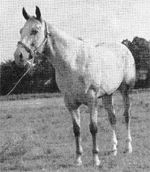
Boca Chico
In the 1st Annual Dal-Worth ApHC Southwestern Appaloosa Breeders Consignment Sale, October 29, 1960, Myres consigned Hi Lonesome T10040, sired by Boca Chico T8429 (Boca Grande X Estelita T9473), out of Kodacolor T9472 (Boca Grande X Estelita T9473) and Floor Show T6577 (Bull Bat X Cooterville Cocoa 495). C.D. Wyche, of Irving, Texas, owned Boca Sixty T10042 (Boca Chico T8429 X Little Sixty {TB}) and an unnamed filly by Boca Chico T8429, out of the mare D-D’s Flashy Belle T7791—all consigned to the 1st Annual Dal-Worth ApHC Southwestern Appaloosa Breeders Consignment Sale, October 29, 1960. In that same sale, Pete Stout consigned Stouts Tiny (out of Mexico Foundation mare), Miss Boca Chico, Stouts Tamie (out of Foundation Mexico mare), and Stouts Peak. T.W. Cobb of Grand Prairie, Texas, consigned Boca Gringo (Boca Chico X Estelita) and Boca Lena (Boca Chico X Kodacolor). Jerry Randle, College Station, Texas consigned Boca Nothing (Boca Chico T8429 X Mexico Appaloosa mare).
Boca Chico was featured on the cover of the (Frank Fichte) April 1960 Appaloosa Journal. The information on the stallion states that he was bred by John Myres and was sold in Mexico. His pedigree is given as: sire is Boca Grande (Flywheel AQHA P1942 X Dragon mare); dam is Eslelita [NOTE: this should be Estelita], said to be sired by Dragon, out of the TB mare Lady Wonder. Boca Chico stood at the Brit May Ranch in Mexico, being bred mostly to TB mares. Myres re-purchased the horse and brought him back to the U.S.
CHOCTAW HORSES
Into this section will come the Eastern Native American horses, particularly the horses of the Choctaw Indians, which Dr. D. Phillip Sponenberg names “Colonial Spanish horses”, which he states has more than one strain. These horses have been discussed earlier in this report. No doubt the Choctaw herds would have been a large source of horses east of the Mississippi. [NOTE: Dr. D. Phillip Sponenberg would partner with Donald Bixby to create the “Bixby-Sponenberg Breed Conservation Award” which is presented to breeders of various endangered breeds of animals, including the Spanish Mustang].
The Choctaw Indians were relocated to Oklahoma, along with the Cherokee, Seminole, Chickasaw, and Muscogee {Trail of Tears}. The horses from these tribes, which were known to carry Appaloosa color genetics from their Mexican ancestry would become part of the cattle ranches in Oklahoma and surrounding areas. Perhaps this could be the source of the spotted patterns of the Colorado Rangerbred horses, whose roots were in Nebraska on the Colby Ranch. The Rickman Spanish Mustang program has combined the genetics of horses from the Choctaw, Huasteca, Chickasaw, Cherokee, and other Native American tribes, along with Spanish Colonial Horses from Utah and New Mexico. [Example: “roan Appy Ute mare”, “Cheyenne Indian Pony”, “Crow Indian stud”, “Crow Indian mare”].
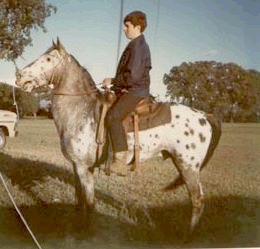
Chief Pushmataha
Another noted Spanish Mustang sire, Chief Pushmataha SMR 47/SSMA 40, is also registered with the ApHC T21400. Chief Pushmataha traces back to both the La Flores and Self Family’s Choctaw lines. The ApHC Stud Book lists his pedigree as sired by “Kiamichi Mountain Choctaw stallion”, out of “Kiamichi Mountain Choctaw mare”. The Spanish Mustang Registry pedigree states his sire is “Kiamichi Mountain (SSMA 44)-- sired by La Flores Family Choctaw, out of Miss Kiamichi (Self Family program); out of the unregistered Spanish Mustang mare “Lightfoot” (Choctaw stud X Choctaw mare). Chief Pushmataha has sired registered Spanish Mustangs, as well as registered Appaloosas. His ApHC progeny include Charlies White M T55685, Chief Santio T24373, Pushmataha Sue T121107, Pushmataha Bugs T121753, and King Arthr I B (aka King Arthur I B) T193119. This line also carried through grandget Sir Gwain I B T194154, Sir Grazda I.B. T194158, Misti Rae I B T194155, Lady Shooting Star I B T194156, Prince Valiant T272872 [?], Chief Histep T77206, Lanas Chief T99368, Sir Gallahad IB T194157, and Chief Pompay 157746. Lady Shooting Star I B, a daughter of King Arthr I B, was bred back to her sire to produce Sir Grazda I.B. Misti Rae IB, daughter of King Arthr I B, was bred back to her sire to produce Sir Gallahad IB T194157. These horses were bred and/or owned in Utah and/or Nevada. Chief Pushmataha originally came from Oklahoma. Some of Chief Pushmataha’s Spanish Mustang progeny and grandget had Appaloosa color patterns. A blue roan Appaloosa colored son named Majuba SMR 205, sired Chief Masada SMR 890, who had a spotted blanket.
Another roan Appaloosa Spanish Mustang was the stallion Straight Arrow SMR 5, whose ancestry included 2 lines to a ‘roan Appy Ute mare’ and also Crow Indian stock.
ARGENTINE INFLUENCES
Argentine Appaloosas also influenced the American Appaloosa. At least 77 of these horses were being brought into the U.S. and registered with the ApHC as late as the 1960s. The Burnside program imported two different groups of these horses into the U.S. The first known “Spotties” were brought Argentina in 1895 (this is documented). The Argentine leopards, like Tavisheen, Desert King, et. al. (called “Ghost Wind horses” by some), that came to California in the 1920s are said to be descendants of horses left on the Pampas many years ago (like our Mustangs). The long-standing Doty program, descendants of which can be found in ApHC, AApA, and CRHA, is also recorded to have used Argentine Appaloosas, as well as Mexican Appaloosas. Argentine Appaloosas have also been exported to Britain. ‘Petrukas’ (ApHC registered T236547 with unknown parents), an Argentine polo mare became the foundation mare at the Rivaz Stud (North Hartford, Herts, England) and in the British Appaloosa Society Stud Book.’Petrukas’ would produce the ApHC registered foals Pendean Bobby T236550/BAPS T14 (unknown parents), Rivaz Charade T236551 (unregistered sire), and Rivaz Epic T236553 (unregistered sire). The horse Tibertich Chaco BR/144 was imported from Argentina to Britian and founded the Tibertich Appaloosa program. In Moira Harris’ book, Wild Horses of the World, characteristics for the Criollo, found in Argentina and Uraguay, include sclera and leopard spots. Harris goes on to say that the Criollo descends from horses of the 16th century Spanish conquistadors. Records from Don Pedro Mendoza, founder of Buenos Aires, say the conquistadors’ horses were Barbs, with influences of Garrano and Sorraia, neither of which is known for spots.
The Argentina Appaloosas, like many of the Mexican ones, were said to be small, with lots of color, and poor conformation, according to many people who saw them. Research (Susan Larkin, Jan Haddle-Davis, Pat Mefferd) has traced the Argentina Appaloosas to the breeding program of Alzaga Unzue, or one(s) like it in Argentina. The leopard horse has been documented to have been introduced in 1895 at the Unzue Ranch by animal dealer/imported Karl Hagenbeck. The Unzue plantation is considered to be the origin of a South American leopard horse color line, that was kept pure, known as the “J Ramos Otero Pintados”. Hagenbeck captured animals for zoos and circuses and knew the area where the Przevalski’s Horse and the Altai (claimed to actually be Boltai) horses ranged. Although there are unproven claims that the location of the Altai was unknown, it is a highly probable that some of the early spotted circus animals, particularly leopard patterns, were captured, or perhaps even traded from the Altai herds by Hagenbeck.
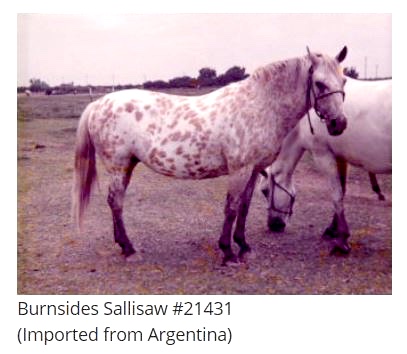
[Argentine x Argentine]
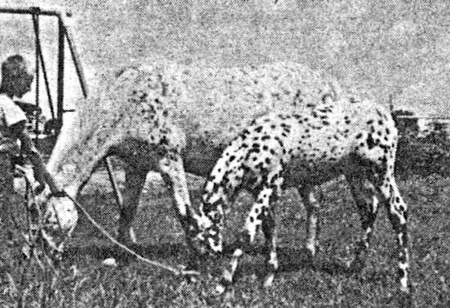
Burnside's Cactus Blossom [Argentine leopard x Argentine leopard]
with her colt, Red Polkadot Special
BURNSIDE
The Argentine Appaloosas were imported by Burnside’s Franklin Plantation, of Newellton, Louisiana. It is not certain how many shipments came to the U.S. – 2 or 3—but 2 are what the ApHC promotes. Only the second shipment gained any publicity, and not much is really known about the first shipment for some reason. The first load was inspected by Dr. Martin A. Spindel (federal veterinarian), and imported to New Orleans, LA, through Oscar R. Whilden. Roy Young, of the ApHC and AAA was involved in the handling of the second shipment. The second shipment was in the early part of 1962, and the horses, said to be “all tattooed by the ApHC”, were later sold in September 1962 at Shreveport, Louisiana. The first 20 imported horses were registered with the ApHC with unknown parents. Burnside Appaloosas were repeatedly said to have loud color, but poor conformation.
[NOTE: Gene Carr stated that Ben Burnside did not import the Argentine Appaloosas. They were imported by the father of Dr. Bob Hooker, who was shipping cattle to the U.S. and added horses to the shipment. Hooker claimed to have paid about $25/head for the horses.]
From the 77 horses with Argentine sires and dams, the Argentine Appaloosa bloodlines are still found in many current ApHC pedigrees, especially in the Pratt program of “foundation” Appaloosas. As shown above, concerning the Doty program, Argentine bloodlines were used as well as Mexican based breeding. These Argentine lines are found in multiple registries- ApHC, ICAA, AApA, ApHCC, FAHR, Sundance, and CRHA. The Argentine bloodlines pass through such horses as ShadowHeart Double 473657, Secret Pyramid 202776, Doe’s A Rollin T223049, Pepper’s Licorice T365100, Pratt Toby Secret 310323, Pratt Toby Buckaroo 522703, Rose Ridge Dynamite 57307 (aka Crocodile), Bama’s Jenks 42154, WOA Cheetah 482043, Pratt Secret Doll 375738, Mighty Doe Boy T341117, Tade’ Gleska T317134, Kingpin’s Princess (aka Proudfoot’s Cadence), Etched In Socks 576087, JAS Rockin Robin 515425, Big Duke Six, Four Wheelin PR 476910, Ace’s Sugar Baby AApA 2161, WR Pokadot Arrow 591990, Red Polkadott Special 61190, WAR Spider Mount, WOA Tatokala B 426471, Tom’s Ace High T337689, Sugar’s Leopard Rose AApA 3267, CTR Silver Snowstorm 626468, Neemeepoos Issaquah 623553, Bay Watch Babe CN581848, Plaudits Sassy Joker, Take Pride ICAA F4-2230, GKC Warriors Song, Ace’s Spanish Spice AApA H2160, Robinson Beauty Spot 553528, Colida’s Sunrise 540677, Unzipped 499524, Oxburn’s Doe Boy 94414, Dirty’s Snafu 252364, Colida Plaud Gold, Sundancing Fire AApA 2578, Post Commandoe 504693, Lane Bar 449897, Easy May Wind 575211, Jeannie Jinx N317209, My Wapiti Star, Call Me Starmaker ApHCC 24933, Pratt Desert Dove 522077, Blackfoot Warrior AApA H2452, Neemeepoos Chahayah 639708, Awesome Vision, Tobys Moon Song AApA B2593, Harlans Dream Weed 679843, Gosromannumerall 455328, Hands of a Hero 644878, WAR Toby’s Nightwind 538859, Mighty Bright Future 529279, Billy’s Harper 452403, Kolles Moneyrock, Mighty King 290033, PFAR’s Night Wind ID11199, WAR Cimmaron 563268, Redcloud’sjoker 392251, Colida’s Honeytwo N473506, Plaudit Warbeads 491630, Spanish Treasure AApA B2324, Never A Doubt 527162, Impress Me Zip, Lifegoeson 638827, Desperado Encore 539380, Dominion Pampas Rex 59230, Toby’s Buffalo Princess AApA H2368, PFAR’s Night Song ID11200, Love To You 347717, Justa Bar Hand ApHCC 5455, Chico’s Domingo T109040, Quavo’s Comanche T130286, Bonita Senorita AApA 2594, Duke’s Black Lady T173446, Cross’ Bob White T149186, Tobys War Chant AApA 2635 (aka Joe’s Ringo Star), and hundreds of others.
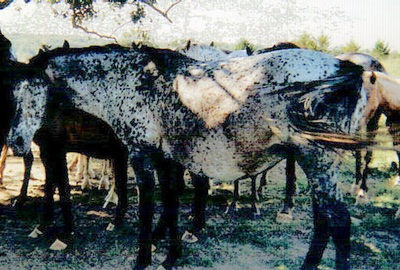
Doty's Blue Bird
HAROLD DOTY APPALOOSAS
As Harold Doty and Doty Farms had proven Mexican bloodlines in his program, he also had Argentina bloodlines with the use of the stallion Burnside’s Lad T12667 (tattoo 562842) and another purported Argentine bred mare that has not been identified (to my knowledge). The ApHC Database shows that Doty’s Farms was the original owner of Burnside’s Lad, but the ApHC Stud Book shows that Ben Burnside owned the horse, and no breeder is listed. Burnside’s Lad is shown to have sired 100% color on 24 ApHC registered foals. Later, a few horses said to trace back to the Doty herd, through the unregistered mares Doty’s Sweet Spice and Doty’s Bluebird, were registered with the ApAA.
Doty had several horses sired by Burnside’s Lad T12667 in the ApHC records-
- Batten’s-Go-Man T144862 (out of Doty’s Irene T30303), bred by Doty; owned by James Batten, Bolivar, MO
- Batten’s Duke T144863 (out of Beouf River Squaw T30204), bred by Doty; owned by James Batten, Bolivar, MO
- Argentine Lady T127470 (out of Gray Lady -NR-blue roan), bred by Doty; owned by Carl & Ethel Wilcox, Willard, MO
- Doty’s Red Spot T181567 (out of Appaloosa mare), bred by Doty; owned by Walter Hasler, Marceline, MO
- Bob’s Spotted Girl 192858 (out of Appaloosa mare), bred by Doty
- Black Moon C T197606 (out of Apache Moon -NR-gray), bred by Doty
- New Boss Konya T199879 (out of Dotty mare), bred by Doty. [NOTE: Assume “Dotty mare” may be “Doty mare”]
- Chocolate Sundae T198148 (out of Doty’s Irene T30203), bred by Doty
- Virginia’s Evening Star T160539 (out of McKnight mare-brown), bred by Doty
- Lad’s Rebel Rouser T152549 (out of sorrel Quarter mare), bred by Doty Farms. ApHC Database lists name as Lad’s Rebel Rouse.
- Chiquita Squaw 198149 (out of Beouf River Squaw T30204), bred by Doty
- Argentina Lad 116932 (out of Granado’s Blue -NR-blue roan), does not list breeder, but states foaled at Buffalo, MO
- Wright’s Lucky Girl 62918 (out of Silver -NR-chestnut), bred by Doty
- Argentina Night Hawk T66399 (out of Silver-NR-sorrel), bred by Doty Farms
- Red Fox Warrior 66781 (out of Pat-NR-bay), bred by Doty Farms
Also on Burnside’s Lad’s production list is –
- Burnside’s Cream T51016 (out of Burnside’s Sallisaw 21431) Ben Burnside is listed as the breeder and E.S. Murray of Campti, LA as the owner. Burnside’s Sallisaw is listed as being bred by an “Argentine breeder” and owned by Burnside.
- Burnside’s Teneha T24911 (out of Burnside’s Tama T20407) Burnside is listed as the breeder, and Bert Wheeler of Houston, TX was the owner. Burnside’s Tama (tattoo 562841) is listed as being owned by Burnside. No breeder is given.
- Burnside’s Tika T24913 (out of Burnside’s Betsy T12666) Burnside listed as the breeder and Dr. Henry E. Jones of Sterlington, LA as the owner. Burnside’s Betsy (tattoo 562840) is listed as being owned by Burnside.
- Burnside’s Quepaw T24909 (out of Burnside’s Pola T20403) Ben Burnside listed as the breeder and Dr. Emily Jones, of Shreveport, LA as the owner. Burnside’s Pola (tattoo 562837) is listed as being owned by Burnside in the Stud Book. The ApHC Database contradicts this, showing the original owner being Dr. Emily Jones.
- La Tigre T51017 (out of Lelita -NR-white) bred by Ben Burnside and owned by E.S. Murray, of Campti, LA.
- Burnside’s Miss Pampus T25076 (shown as Burnside’s Miss P in the ApHC Database) is listed as being out of an “Appaloosa”. She was owned by Ben Burnside, no breeder was listed.
- Burnside’s Kiva T24912 (out of Burnside’s Louise 12814), bred by Burnside and owned by Bert Wheeler, Houston, TX. Burnside’s Louise (tattoo 562839) was owned by Burnside.
- Burnside’s Lad is also shown to have sired Dugan’s Sur-Spot T79681 and Dugan’s Sur-Shot T79682, out of the mare D.R.D.’s Black Lady Bug 38692 (by Morgan’s Granado F1418). These full brothers were owned by D.R. Dugan, Elkland, MO. No breeder is listed in the Stud Book.
Beouf River Warrior 29873 (Cooterville Blanko 15365 X Barham’s Mare -NR-), was owned by Harold Doty/Doty Farms. No breeder is listed. Cooterville Blanko (Cooterville Red River T487 X Cooterville Sweet Sue F2506) traces back to the Davis Brothers’ AQHA, NQHBA and Palomino program through Kiowa Brave ApHC F324 to Golden Cargile. Kiowa Brave’s ancestry has been traced to the Indio Ranch [Pat Mefferd research].
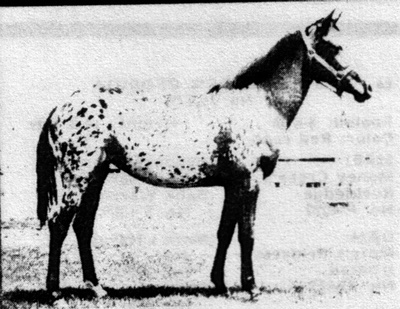
Cinder Mak Queen T175959
Money Creek Ranch once owned a mare that was connected to the Doty program—Cinder Mak Queen T175959 [Batten’s-Go-Man T144862 X Batten’s Queen T41337]. Batten’s-Go-Man is credited with siring 14 ApHC registered foals- Kays Miss Pocadot T246459, Lady Fire Bal T247536, Sno Cloud II T212362, Miss Casey T212408, Sebastian Go Man 190978, Domino Pola Dott 191101, Cinder Mak Queen, *JW’s Leopard Abe 163214, Stormy’s Wamego T152961, Ginger’s Nibbles T152960, JW’s Leopard Go B 167730, Go Man’s Tige 148042, Ty-Ee Go Man 172724, and Wilcox Chief 151285.
“GHOST WIND”- ACTUALLY FROM ARGENTINA
The “Ghost Wind” bloodlines label exploded onto the scene after the publication of the book The Story of the Ghost Wind Stallions, authored by Don LaLonde and ghost-written by Frank Scripter. The book is based on the supposed recollections of Native American George Long Grass and the coming of spotted horses to the Pacific North West on Russian ships. Some of this book has been debunked (the cross-country travel, the horses, George Long Grass) by multiple researchers, and other parts are very much in question. Yet this book gave a new light for promotion to foundation breeders that continue to use the “Ghost Wind” term, even though it is probably false advertising. The Ghost Wind movement even had its own museum. The Michigan Museum of Ghost Wind Horse History was formed October 30, 1985, as a Domestic Nonprofit Corporation, based in Caledonia, Michigan. Donald A. LaLonde was the registered agent of the now defunct business, which was dissolved on November 15, 1990.
The most famous ‘Ghost Wind” lines are Siri Sheik F1833 (aka Jazzo II according to some), Arab Toswirah Alkhar F2417 (aka Arab Taswirah Alkhar aka Arab Toswirah Alkar aka Jazzo I), Desert King ApHC-NR (aka Jazzo), Sudan (aka Desert Viento) ApHC-NR, and Siri Chief POA #2. Jim Hoffman (along with wife Irene), who owned Siri Shiek and Arab Toswirah Alkhar, was the breeder of Siri Chief POA #2. The Hoffmans promoted Desert King, Sudan, Siri Shiek and Arab Toswirah Alkhar (said to mean “Arab picture horse” in Arabic) as LYBIAN LEOPARDS, with the story that Sudan and Desert King were smuggled out of Libya in the 1930’s on the stipulation that they would never be bred. After Arab Toswirah Alkhar was registered with the ApHC, under the ownership of the Ulmers, the Libyan Leopard story was being questioned, especially since 4 different people in California claimed to be his breeder. Later, both the Libyan Leopard story and the Ghost Wind story would be labeled as MYTHS.
Arab Toswirah Alkar F2417, would not only sire Siri Sheik F1833 (sire of Pepper’s Shamrock F4090), but also a lesser known son named Guacho T1091. Gaucho would sire Poker Chip H T3875. Other descendants include: Wolosek’s Show Boy T148626, LVR Ratchet K ICAA F3-1951, Peppers Black Beauty N535667, LVR Apache Salsa ICAA F301956, Kolwalski Blue Chip 268527, WW Miz Phoenix 531740, LVR Apache King K ICAA F2-1953, Tribute To A King 336818, Littlebit Naugty 443742, Flamingos Image LVR 609194, among others.
The names of the owners and/or breeders of these horses can be found in the records of both the ApHC and the POA. The most prominent POA breeder/owner of these lines was Paula Cooper, of Wilcox, Arizona. [NOTE: also known as Paula Cooper Kortsen, Paula Cooper Cortsen, Paulla Cooper Kortsen]. Don LaLonde, of Caledonia, Michigan, owned Appaloosas with this breeding. George and Pat LaLonde, of Lewisville, Texas (and later of Mason City, Iowa) owned POAs sired by Goblin ApHC T1875. Money Creek Ranch, who would later own Siri Shiek and Arab Toswirah Alkhar* [note: Money Creek owned Pepper's Shamrock and MC Rockledge, Siri Sheik was owned by Paula Cooper, and Don Ulmer owned Arab Toswirah Alkhar, ...or am I wrong?? ~AT] and continue to promote them as LYBIAN LEOPARDS, as well as Money Creek’s Rockledge, bred both Appaloosas and POAS with these lines. In the article “The Money Creek Ranch- A True Working Horse Ranch”, by Sharron J. Seeling, [Appaloosa News, 1-1969], the Webers claim that the “Hoffman Leopards are true leopards”, and that they have “little time for people who misrepresent to the general public other Appaloosa types as leopards”. Ironic, given that the Hoffman Leopards were misrepresented by the Webers as being LYBIAN LEOPARDS for years. The 1975 Money Creek Ranches Appaloosas promotional brochure also touts the famous sire, Money Creek’s Rockledge F4092 as a “Libyan Leopard”, saying this type of horse has a “distinctive action, disposition, intelligence and hair coat”. Money Creek’s various promotional materials and sales lists have called the type “LYBYAN LEOPARD” and also “LYBIAN LEOPARD”, depending on the publication.
[NOTE: Coincidence that there are two LaLondes associated with the Siri Shiek/Arab Toswirah Alkhar (aka Ghost Wind) lines?? Still checking for family connection(s). George was the Managing Editor of the POAC Magazine and the Executive Secretary of the POA, Inc. in 1972. Pat was the Assistant Editor of the POAC Magazine in 1972. George and Pat owned Cayuga’s Raven POA T5572 (Corette’s Peace Pipe POA ID#19 X registered Shetland), bred by Ellis Dunn; and Cayuga’s Fawn POA T5765 (D-D Kiowa POA 104 X unregistered Shetland)]. George and Pat lived in Texas and later moved to Iowa.
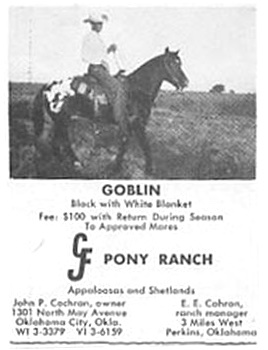
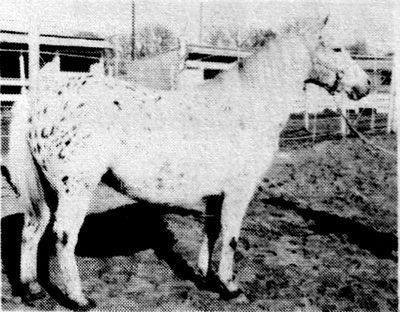
Sal's Gal T-2147
Goblin ApHC T-1875 is shown in the ApHC Stud Book to have unknown parents. Goblin was actually sired by Siri Chief POA #2 (see below), although the ApHC Stud Book shows Siri Chief to be unregistered; out of the mare Sally H ApHC F-2009/T1877, who was purchased from the Hoffmans, also shown to have unknown parents in the ApHC Stud Book [NOTE: ABDB shows her sire to be Pongee Morgan, a registered Morgan]. Goblin was bred by Paula Cooper Korsten, who owned his sire. George and Pat LaLonde owned Mrs. Goblin POA 7528 (by Goblin). Goblin also sired Gresham’s Dee POA #11484, out of the ApHC mare Bella Coola T-9746 (Canadian parentage). [AT: Goblin also sired Goblin Jr T-3815 out of Crow, bred by Paula Cooper Korsten] Advertisements for Goblin can be found in older The Western Horseman magazines, under the ownership of John P. Cochran’s CF Pony Ranch (Appaloosas and Shetlands), in Oklahoma. An ad with photo of Goblin can also be found in the June 1960 (Frank Fichte) Appaloosa Journal.
Bloodlines from these Argentine horses can be found in many current ApHC pedigrees, particularly through the foundation Appaloosa breeding faction, who promoted and continue to promote those early horses as “Ghost Wind” horses. Descendants include DJ’s Bugle Boy 474293, JAS Rockin Robin 515425, Money Creek’s Chiprock 121202, Ghost Wind El Bravo, DJ’s Warlock 217727, Pepper’s Shamrock F4090, Oakstopatchyeagle 468707, Tade’ Gleska T317134, Mint Chip 513996, Siri’s Jolie T24632 (sire of POAs), Solar Flair Eclat 372595, Oaks Lyon Heart 525119, Money Creek’s Prince Ern 46055, RH Ghengis Khan F3204, Waps Patchy Blueagle 643008, Neponset 197549 (have also seen Neponest), Money Creek Rockledge F4092, Eternal Destiny 543497, Pepper Shone T123054, CF’S Abra-Cadabra 398931, Shylock’s Cody 346072, PVSThundersmemory 413886, Sabik Star AApA, (Money Creek’s) Prince Valiant F2215, Van Ledge 219168, Prince Onta T277460, Jokerstwoeyedjack 479491, BBF’s Spanish Roca 325174, Endeavor 153287, Solar Snow Coyote 493904, Candy Coated West 554466, Howling Wind GHR 498245, Bay’s Leopard Lad 292166, BBR My Regal King 609712, Hollywood Tom Cat 267498, Lad’s Tahi Rio 355147, Geronimo’s Playboy T230322, and hundreds of others.
These Argentine lines are also numerous in the POA breed, through the noted sire Siri Chief POA #2 and his descendants. Siri Chief, a POA Hall of Fame inductee, was sired by Arab Toswirah Alkhar ApHC F-2417, out of a mare named pony Ginger (unnamed Welsh stallion X unnamed Hackney mare). Siri Chief is featured in POA- Pony Of The Americas, 50th Anniversary Edition, History of the Breed 1954-2004, compiled by B.J. Spahr, under the subtitle “The Mysterious Heritage of Siri Chief #2”. He is shown to have sired 3 ApHC foals: [Goblin T-1875, Sal’s Gal T-2147 and ? - AT]. The “Siri” POA line includes: Siri Super Chief 528, Siri Teton T1128, Siri’s Spot Cash T613, Siri Rex 3830, GR’s Siri Scottie Hand T7058, Devil’s High Noon T19016, Nik’s El Siri Cid 9836, Lannan’s Siri Super Spot 5948, Santee Princess T18848, Pecoy’s Siri Sweetheart T15980, Round Robin Pecoy T19260, Pok-A-Dot’s Black Blisters 3147, Lannan’s Siri Superdot Tom-Tom T7731, Santee Silver King T18965, Way Lo’s Siri Tonka T6303, Driftwood Siri T11547, Lannan’s Siri Superdot Borkaan 5824, Chirachua’s Siri Scout 7557, Siri Ghee-Zis (Sun) 1866, Driftwood Siri’s War Paint T13929, Lannan’s Siri Superdot Tonto 7704, Totem’s Sun Siri Ann 18789, Siri’s Fire Arrow 3488, Pok-A-Dot’s Little Heap 3148, Totem Siri Desert Dust 7205, O’'s Heap O’ Blisters T13550, Driftwood’s Siri Jingles T13812, Latch’s BB’s Number-One-Son 10023, Leopard Lair’s Siri Pete 3895, Lannan’s Siri Superdot Hi Hopes 13033, Hiva Siri Hawk’s Big Creek 12029, GR’s Siri Bellboy 13536, Ken-Wil’s Cupie Doll T21662, PH’s Siri Ocheye T15654, Sunny Bars T23034, Triple R Siri Bar ID1710, Pok-A-Dot’s SOS (Son of Super Chief) 3034, Chief Illini Rex T28296, Sabre’s Siri Sierra 18761, CA’s Shiloh T22966, Jack’s Minute Man T26503, Ima Silver Royal T33468, Miss Gold Velvet 29619, BH Bunny Britches 28208, to name only a few.
Siri Shiek ApHC F1833, was also used in breeding POAs, having sired Siri’s Silver Smith 8003, Okie Siri Elf 6142, J’s Not So Big 19129, and Siri’s Desert King 4260.
An addition to the “Ghost Wind” family tree, claimed from the Scripter research is Chief Chelsea F-2154 (aka Dancer’s Rainbow), said to be sired by the unregistered Appaloosa stallion Desert Dancer. Desert Dancer is said to be sired by the unregistered Appaloosa stallion Desert Knight. Desert Knight is said to be a full brother to Desert King ApHC-NR (aka Jazzo), who sired Arab Toswirah Alkhar F2417 (aka Jazzo I).
POSSIBLE ARGENTINA HERITAGE ?
If names suggest possible origins, then the unregistered mares ‘Argentine Heart’ (42-inch blue/blanket Appaloosa) and ‘Argentine Queen’ (45 inch blue roan) could very well carry genetics from horses imported from Argentina.
MORE MEXICAN HERITAGE ????
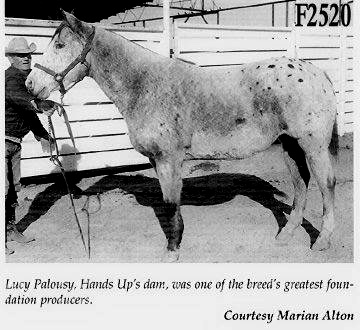
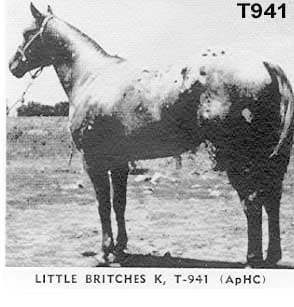
Although nothing provable at this time, one should consider that horses bred and/or owned by Mexican named people, especially those listed as living in Mexico, and/or horses with Mexican names may well have ancestry from Mexico or Argentina.
Enrique Guerra, of McAllen TEX owned the horses Sure Spot T7076, Jouera T7077, Lucero T7081, Loba T7080, and “La Nutri” T7079, all of unknown parentage, according to the ApHC Stud Book. Loba and Lucero were bred by Francisco Chapa, of Tamaulipas, Mexico. Sure Spot was bred by Francisco Rodriguez, Tamaulipas, Mexico. “La Nutria” was bred by Manuel Garza Lopez, of Tamaulipas, Mexico. The mare Kopfer’s Old Mexico T9916 (unknown parents and breeder), was owned by Earl Kopfer and son, Unionville, Missouri.
Another possibility could be the mare Lucy Palousey F2520. Lucy Palousey is recorded to be out of the unregistered mare named Magdalena. Magdalena’s sire is given as Burleson Stud (Captain Santa Rosa X Cabrara). Magdalena’s dam is given as Maria (Cachan X Leona). [NOTE #1: ‘Cachan’ which means ‘they catch’, comes from the Mexican word ‘cachar’]. [NOTE #2: ‘Cabrara’, a form of the Mexican word ‘cabrero’, can mean ‘goatherd’ if used as a noun, or ‘bad-tempered’ if used as an adjective.] Lucy Palousey is the dam of two noted performance horses and subsequent sires- Hands Up F2217 and Little Britches K 941. Lucy Palousey also produced the mares Joker’s Lu Cee 41941 (by Joker B F678), Lucy’s Pride 6119 (by Cherokee A F2847), Joker’s Lucy 2 35293 (by Joker B F678), and Sparkle Plenty F2521 (by Hands Up F2217). Hands Up and Little Britches K (April 1961 Western Livestock Journal “Horse of the Month”) are noted Appaloosa sires with many descendants. It is said that the breeding of the sire of Little Britches K (Kandyman AQHA 16615) is a cross on “sturdy Mexican-Spanish range stock”.
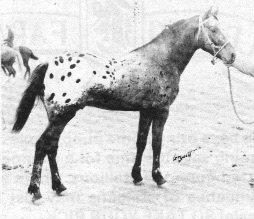
Quanah F-706
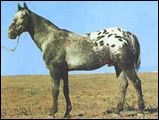
Lucky Dott F-2057
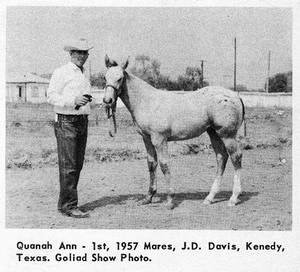
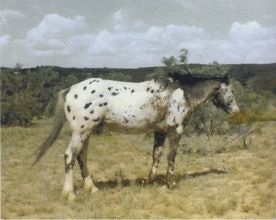
Mansfield's Comanche
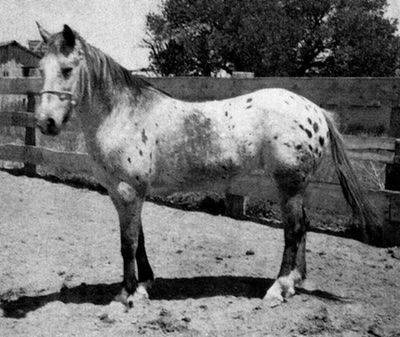
Junaita M
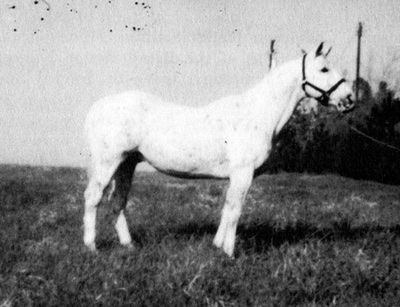
Candy Chief T-999
Another possible Mexican Appaloosa descendant is the roan mare named Apple NQHBA 428 (aka Appal). Being that she is thought to have been an Appaloosa, that heritage is said to come through her dam, an unregistered roan mare named Dazy, who was sired by a stallion named Pedro, out of a mare called Nell. Apple’s sire is Joe Bailey of Weatherford (NQHBA records) or Joe Bailey P4 (AQHA records), with no known Appaloosa genetics. Apple is recorded to have produced Red Cesar NQHBA (by Brown Ceasar AQHA 863- traces to King Ranch), Quanah ApHC (by Tony Waggoner AQHA 1327- traces to Waggoner and Roberds), Van Horn Waggoner ApHC (full brother to Quanah), and Lucky Dott ApHC (by Tindall Bailey AQHA 14266- traces to King Ranch). Apple is also said to have produced the unregistered mare Molly D, dam of Quanah Ann ApHC T2255 (sired by Quanah). Pat and Bob Hickman’s Longhorn Ranch, in New Mexico, used both Quanah (ad/photo, The Western Horseman 4-1960 and 8-1959) and Lucky Dott bloodlines in their Appaloosa program [Appaloosa News 2-1963]. Quanah was Grand Champion Stallion at the American Appaloosa Association’s 11-1954 2nd Annual Appaloosa Pageant, at Mineral Wells, Texas (photo The Western Horseman 2-1955). Quanah and Lucky Dott are featured sires in the Pendaries Ranch Sale Catalog, July 1960, which was published in the (Frank Fichte) Appaloosa Journal, June 1960 edition.
INDIO RANCH
The Indio Ranch originated in the early 1850s, when William L. Cazneau established his ranch on the northern section of the Antonio Rivas grant (southwestern Maverick County, Texas), by the Rio Grande and near Eagle Pass. The Cazneau Ranch would become the Indio Ranch by 1880. The (El) Indio Ranch and the settlement of El Indio were both probably named for Indio Creek which ran close by. Later in 1880 Indio (also known as Presidio or Indio Ranch) was established ten miles south of El Indio. Francisco Madero may have launched his Mexican Revolution against Porfirio Diaz from the Indio Ranch in 1910, with incidents of gun running, cattle theft and military activities in and around the area. In the book, The Texas Rangers: A Century of Frontier Defenses, it is noted that there were Mexicans stealing cattle, horses, and goats from the Indio Ranch in 1917.
According to the Cauble family history, as told by Gladys Collett Cauble, Gladys’ father H.C. Collett moved his family to the El Indio Ranch during the depression, where he worked for Jack Mansfield. Gladys’ future husband Jack Cauble also worked for Mansfield. In 1939 the Caubles and their two children would later move to the Alamosa Ranch at Vega, Texas, that had been purchased by Jack Mansfield and Houston Harte. The Alamosa was previously named the LS Ranch, for owners W.M.D. Lee and Lucien B. Scott.
Jack Mansfield was well known for breeding Appaloosas, according to the ApHC, but that may not have been the actual case. He was only a member of the organization for one year – 1956. He was listed as an owner in the ‘Owners of Appaloosa Horses List” in the ApHC Stud Book (Vol. 3- combined edition). He was active in the Appaloosa breed. He retired from the position of Vice President of the American Appaloosa Association in 1955. He was also a noted cattleman and served on the Board of Directors of the Texas and Southwestern Cattle Raisers Association in 1954 and 1955. Jack was featured in an article (along with Bob Mansfield) about the Alamosa Ranch cattle program, titled “Feeding Guar Beans to Steer Calves on Grass” (1954 The Cattleman).
Mansfield is known for the noted foundation stallion Mansfield Comanche F3096 and his dam Juanita (aka Juanita M T21700). There are questions about the history of Mansfield Comanche, with differing answers given in different sources and/or interviews of Mansfield over the years. Mansfield Comanche F3096 is recorded to have been sired by the Thoroughbred stallion (Remount) Dr. Howard. Dr. Howard is also shown as the sire of the unregistered QH mare Trammel’s Rusty, who would produce Navajo Britches F2709 and the sire of the Half-Bred mare Princess Pat.
Mansfield Comanche’s dam, Juanita -NR- (later registered Juanita M, T21700) has a pedigree that very much so suggests Mexican heritage. Her sire is shown as Cortez -NR-QH (Pancho Villa X Maria); her dam is (assumed Appaloosa) Senorita (Jose X Chiquita). The ApHC lists her parentage as “unknown” as they have no official evidence for her pedigree. Nor does the ApHC recognize that she was later registered, and still provides pedigrees with her as an unregistered horse. Juanita was said to be a part of a large herd of horses purchased along with the Indio Ranch by Mansfield. It was the tradition of the times that the stock went with the ranch, when the ranch was sold. Mansfield said he thought the spotted horses among the Indio Ranch stock came from Mexico.
It can be noted that the Indio Ranch also bred the paternal granddam of the ApHC stallion Kiowa Brave T324. This mare is called the “Cicero Smith mare” in the ApHC accepted pedigree [Pat Mefferd research]. She produced the sire of Kiowa Brave, known simply as “Cargile’s Appaloosa”. Kiowa Brave also had Anson bloodlines on his dam’s side (see below). Kiowa Brave’s dam, known as Gray’s Dun Mare in the accepted ApHC pedigree, was sired by Golden Cargile PHBA/AQHA/NQHBA, whose dam was an “Anson mare”.
Pat Mefferd research brought another bloodline into the Indio Ranch possibility, that of the stallion Candy Chief T-999. Candy’s Chief dam is India Speck F-3453 (bred by L.A. Clark, of Rocksprings, Texas) out of the unregistered mare Lady India (as per ApHC records) or Indio Maid (as per NQHBA records). Lady India and Indio Maid are from the India/Indio Ranch. Pat feels that possibly hard to read early handwritten records could be the cause of India/Indio usage, and that the mares are one and the same. India Speck produced 4 ApHC foals- Candy Chief T-999, Estrellita De Sonora, Inca Princess C F3454, and India Speck I ID6830. India Speck (aka Indio Lady) also produced Casa Grande NQHBA 13313. All 5 foals were bred by L.A. Clark, who bred AQHA, NQHBA and ApHC. If the Indio Ranch reference is correct, then that would put this bloodline originating most likely from the early Mansfield program. The India Land and Cattle Company is located in both Ft. Davis and Houston area, according to AQHA. There also was an India Quarter Horse Ranch.
AND THEN….
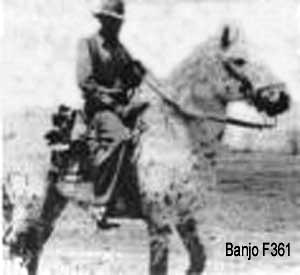
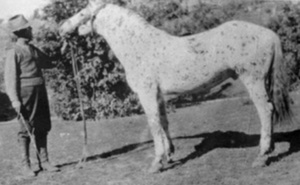
Starbuck Leopard

Daylight
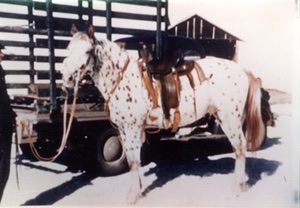
Sundance F-500
BANJO—K.K. PARSONS
Known Appaloosa and CRHA breeder K.K. “King” Parsons comes into this research. Information from Parsons and concerning his program, always has a doubtful aspect in being believable. Parsons was kicked out of the ApHC for falsifying pedigrees/registration information (Pavo, Rainy Moon). He sold horses to other Appaloosa breeders whose pedigrees turned out to be falsified, like Ben Johnson (Barrendo Red) and Lorne Knisley (Rio Dinero). The same can be said about some of the CRHA horses from the Parsons’ Wineglass Horse Ranch. Parsons also claimed to have owned and/or bred horses that he did not. Parsons sold horses to Texas, Kansas, New Mexico, Oregon, Nebraska, Oklahoma, North Dakota, Illinois, Arizona, Montana, Nevada, Colorado, North Carolina, Wyoming, Utah, Indiana, and Missouri. Parsons was also banned from having articles published in The Western Horseman magazine (info from Pat Mefferd). Parsons is on record for promoting his horses as “Libyan Leopard horses”, “Morocco Barb horses” and stating that the stallion Pavo was “imported from Persia” (Horse Lovers Magazine 9-1957, from Pat Mefferd).
There is more than one pedigree for the pre-registry leopard stallion Banjo because there may in fact be two different horses. Parson’s story on the Mexican “sabino” stallion called Banjo (unknown foaling date), is that he was brought to the San Luis Valley (have also seen as San Luis Rey Valley- depending on source) in the 1930s by Celedon Baca, from Coahuilla, Mexico. [NOTE: there is currently the 92,500 acre Baca National Wildlife Refuge located in the northeastern part of the San Luis Valley] Baca is said to have also brought the parents of Banjo from Mexico, supposedly his sire Indian Hills and dam Consoltine. This Banjo is listed as the sire of The Boss Hoss F194 by the ApHC, as per pedigree by King Parsons. Several researchers through the years have felt that Baca’s Banjo (some say is probably the same Banjo as F361) is not the same stallion that was owned by Clara Wilkins (sire of Juaquin F801). In fact, Banjo F361 was foaled in 1941, and The Boss Hoss was foaled in 1942… so??? There was also an unregistered stallion named ‘Little Banjo’, who is the ApHC recorded sire of Senator Hi T1491, owned by Cecil Dobbin, theorized to probably be the son of Wilkins’ Banjo.
Parsons and other early ApHC breeders exchanged stock among themselves, including the Kopfers, Chet Baldwin, Ben Johnson, Randall Van Patten, T.F. Osment, and others. Parsons also had stock from the Ruby CRHA program.
STARBUCK LEOPARD… SUNDANCE
The Starbuck Leopard saga can be brought into this report on a tenuous possibility of Spanish/Mexican ancestry. There are 11 POSSIBLE pedigrees and/or ancestry tales for Starbuck Leopard that I have uncovered. He is supposed to have been from two different locations in Wyoming (one being an Indian Reservation), from 2 different locations in Colorado, from St. Louis, Missouri, from Utah (The Kid- another mystery leopard), and from Texas. He has been said to have been an imported Arabian, an imported Spanish Barb, an imported European circus horse, Colorado Governor Shoupe’s ‘Waldron Leopard’, an Indian reservation horse, OR a Nez Perce stock descendant. Long-time Appaloosa breeder Frank Scripter provided 2 of the different ancestry tales. Long-time Appaloosa and CRHA breeder Ralph Cannon also had one of the ancestry versions for Starbuck Leopard, which came from people involved with the horse for this story. According to Cannon, the leopard stallion was brought by train (along with cattle) from a west Texas ranch. This would provide the possibility that the leopard stallion was of Mexican or Argentine descent.
The most noted descendant of Starbuck Leopard would be his paternal grandson Sundance F500. Sundance descends from Starbuck Leopard through his sire, the unregistered leopard stallion Daylight. It should also be noted that Daylight has 3 DIFFERENT pedigrees, all provided by Phil Jenkins, the man who supposedly KNEW his breeding: 1) sired by Starbuck Leopard out of a TB mare by Sands of Time (Remount TB); 2) a “freak” sired by a grey Arab out of a plain brown mare; and 3) sired by a white Arab out of a TB mare. The third version was actually a notarized statement provided to K.K. Parsons. It would seem that Phil Jenkins and Parsons were ‘birds of a feather’ where factual pedigrees were concerned.
MAYBE NOT APPALOOSA, BUT STILL MEXICAN …..
I will start this portion with history about the influence of Spanish horses on the eastern part of the United States. Spanish horses influenced breeds other than the ‘western’ Appaloosa and Quarter Horse. The “Hussey Manuscript” documents the Cox family bringing western horses of Spanish descent into the East. The Cox family traveled from Pennsylvania and later Ohio and Kentucky to Central Texas and back for over 90 years, from the late 1700s through the late 1800s. The purpose of these trips was to catch wild mustangs that were descendants of the Spanish horses. It is said that the Cox family brought “thousands of horses” of Spanish blood from Central Texas to the East. So not only was there Spanish genetics traveling South to North, and West to East toward the Mississippi River, there were Spanish genetics traveling from the actual West to the actual East, across the Mississippi. These Spanish genetics would be the basis of the American Saddlebred and would go into the more modern breed of the Rocky Mountain Horse. Genetic testing by Dr. Gus Cothran PH.D., showed that the Spanish markers found in the Rocky Mountain Horse are through the connection with the Saddlebred.
Back to the West, many of the early established ranches got some their breeding stock (cattle and/or horses) from Mexico, or from other ranches who did get stock from Mexico. Some also got stock from the Spanish land grants (sections or whole) that they purchased. It was the standard of the times that when a ranch or grant was purchased, most, if not all of the livestock went with the ranch, along with the brand(s) of the ranch as well. When Mexico gave the United States all of California, Utah, Nevada, New Mexico, Arizona, and parts of Wyoming and Colorado in 1848, there certainly would have been Spanish stock on the land. In fact, it is recorded that the 1807 Juan Bautista Valdez Land Grant (aka Canon de los Pedernales Grant or the Encinas Grant) in New Mexico, did in fact have horses on the land owned by Bautista. Early ranch programs also exchanged, bought or sold stock among themselves. To name a very few-- Swenson (SMS); Scotland-based Matador Ranch; King Ranch; Burnett Ranch; Greene Cattle Co {RO}; CS Cattle Company; Bell Ranch; JA Ranch; JJ Ranch (Charles Goodnight); Victorio Land and Cattle Company aka Diamond A (New Mexico); William Anson’s Head of the River Ranch; Hearst Cattle Company (Van Horn, Texas); Tongue River Ranch; Vail Cattle Company (California), Miller ‘67’ Ranch; Waggoner Ranch; Chapman Brothers Ranch, Philmont Ranch (New Mexico); Thomas Trammell; Capitol Freehold Land and Investment Company aka XIT; Scharbauer Cattle Company; Erie Cattle Company (New Mexico); Coleman-Fulton Pasture Company (183,805 acres in south Texas); Halsel Land and Cattle Company (Texas; Waggoner and King Ranch lines); Tovre Packing Company (Arizona); Santa Rosa Ranch (Texas), Diamond 2 Cattle Company (Arizona); Spur Ranch (1/2 million acres); Pratt Ferris Cattle Company; John Slaughter Ranch (Mexico border); Chiricahua Cattle Company; Espuela Land and Cattle Company (London-based parent company of Spur Ranch), Waddell Brothers and Company (Texas), Pierce Estate- B.U. Ranch (Texas), and many other ranches bred and/or owned thousands of horses. Although these ‘imported’ horses that were the basis of many ranch herds may not have been specifically Appaloosas, they certainly would have brought the Mexican ancestry into the Appaloosa breed years later by way of NQHBA, MQHBA, AQRA (American Quarter Racing Association), QHBA (Quarter Horse Breeders Association), and/or AQHA breeders and registered stock. And it certainly is possible that some of these horses may well have carried Appaloosa genetics in their Mexican heritage, since Appaloosa roan patterns, as well as solid colored horses with Appaloosa characteristics (sclera, mottled skin, striped hooves) were unknown back then to be breed indicators. Many ranches also had access to stock from Native American herds, which would have added Mexican heritage and perhaps Appaloosa heritage as well. Some of these ranches did operate below the border. Also, the time frame of any of the ranches’ beginnings and location would play a part in increasing the possibility of Mexican ancestry. Even after pedigrees started being kept in some of the ranch programs, one would see parentage such as ‘native mare”, “polo type”, “quarter stock”, “native quarter mare”, “steeldust”, “range mare”, “native Texas mare”, “rangebred mare”, and other non-specific horses like “Mex”, that may or may not have had Mexican and/or Appaloosa heritage.
The number of ranches that could be involved in the scope of this research is too great to even begin to count. Take into consideration there were thousands of ranches and homesteads of various sizes throughout numerous states and/or territories during the 1800s into the early 1900s, and that was after the Mexican/Spanish land grants. Hundreds of ranches and homesteads were bought by other ranches who were increasing their holdings or by somebody wishing to start their own ranch. Names changed, brands were absorbed into new ranch programs, and so on. Not to mention the size of some of the ranches. A few of the larger ranches in my opinion did have Mexican genetic influence on the Appaloosa as their bloodlines are found in many Appaloosas.
Most of the land grant and/or subsequent ranch information provided will be for those states closest to the Mexico and U.S. border, as the Mexican influence would no doubt be the strongest. But there were land grants farther away from the border including:
- 1) The Beaubien and Miranda Grant (aka Maxwell Grant) with the largest percentage of land in New Mexico, with some extending into Colorado, covering 1,714,764 acres. 2)
- 2) Beaubien’s son Narciso Beaubien, along with Stephan Luis Lee secured the Sangre de Christo grant of over 1,038,000 acres mostly in Colorado, with some in New Mexico. Part of this land grant would later become a large ranch which would play into the development of well-known Appaloosa family lines, [Research- Pat R. Sunstrom, Pat Mefferd, Patty Judson, Jan Haddle] one of which I will not name, give details about, or name people connected to the line, due to past issues and ongoing research. This ranch bred early QHs, TB, Half-Breds, ‘polo’ ponies, other crosses and contributed to the Appaloosa breed. But there is “open history” that can be discussed and will be later in this report.
- 3) The 1843 (Cornelio) Vigil and (Ceran) St. Vrain Grant (aka Las Animas), near Trinidad, covered a massive 4,000,000 acres. The Vigil and St. Vrain Grant was originally in New Mexico from 1856-1861, then became located in Colorado Territory when it was created. The Bent, St. Vrain and Company established a trading post in 1837 called Fort St. Vrain, named for Ceran St. Vrain who helped build it. One of the post employees was Jean Baptiste Charbonneau, who was with the Lewis and Clark expedition. Later would come the Bent, St. Vrain and Company Ranch (1846-1847) which was the first attempted settlement in Las Animas County. [NOTE #1: The Trinidad, Colorado area was where Senator Casimiro Barela’s ranch was located, where the TB stallion The Senator (aka Senator) stood. Coke Roberds has connections to Barela and his ranch, as he purchased the stallion Primero (sire was half-brother to Senator) from Barela. Also drawing stock from this area either directly or through shared bloodlines/breeding would be the Ruby ranch (CRHA founders), Hank Wiescamp, Coke Roberds, the Peavys, K.K. Parsons (Wineglass Horse Ranch), Lloyd Ortiz, Annie Davis, Ben Johnson, E.P. Deahl, and other early QH, NQHBA and/or Appaloosa breeders].
- 4) The Gervacio Nolan Grant contained 500,000 acres in northern Colorado.
- 5) The 1814 Tierra Amarilla Grant contained all 594,515 acres in New Mexico.
- 6) The Conejos or Guadalupe Grant held 2,500,000 acres, with the largest portion of its holdings in Colorado, and some in New Mexico.
- 7) The Anton Chico (or Antonchico) Grant, issued circa 1822, held 378,587 acres near Las Vegas, south of the Santa Fe Trail, and was later owned by the New Mexico Land and Livestock Company.
Pre-registry and early QH breeder Frank Stockley is shown to have lived in Montell, TEX, as well as Cloete, Coahuila, MEX. Stockley owned the pre-registry QH sires Stockley Horse, Allen’s Sykes and Custer’s Sykes Horse, when in Mexico. Fructuoso Garcia, of Piedras Negras, Coahuila, MEX, owned the pre-registry QH sire Tocho Garcia. The Greene “RO” Ranch straddled the border, so there was definitely a flow of horses from south to north and vice versa.
An early AQHA, Fred Bailey #743, is shown to have Mexican ancestry. Bred by E.A. Whiteside, TEX, and owned by R.L. Underwood, Fred Bailey’s dam, Big Dun -NR-, was sired by Buck (a Spanish horse). Fred Bailey would sire Buckskin Joe AQHA 9681/NQHBA 4004, also bred by E.A. Whiteside, and owned by Morris Clark, WYO.
Although cattle would be the main income source on cattle ranches, many ranches had back-up income or secondary sources, like horses, sheep/wool, and/or crops. Cattle ranching would of course require numerous horses for the ranch workers to use, wagon and driving horses, et. al. and ranches would have their own breeding herds to produce the necessary horses. [NOTE: Registered Hereford cattle were brought into Texas in 1876. The XIT imported registered Herefords and Angus from 1888 through 1900. The JA Ranch brought 200 Shorthorn bulls to Texas in 1881, and 25 Hereford bulls along with 625 Hereford cows in 1883.] Many ranches would sell their excess horses to other ranches. Some ranches later bred horses to sell to the Army, using Remount stallions to obtain the type desired by the government. In the 1920’s and later, the U.S. Army (Remount) was the single biggest buyer of western bred horses. Other ranches bred horses for sale for use as polo mounts, buggy and carriage horses, police horses, and hunters and jumpers, and sold them throughout western and eastern states, as polo was not just an ‘eastern game’ for the well-to-do.
As previously stated, there were many thousands of western horses on ranches, on reservations, and in wild herds. An oversupply existed for many years. In the early 1900s the Chappel Brothers Cannery (based in the East), leased a large part of the Cheyenne River Sioux Indian Reservation where they ran thousands of horses, which were grown out for slaughter and export to Asia.
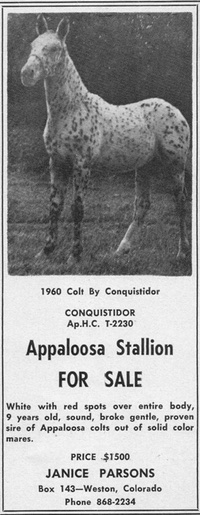
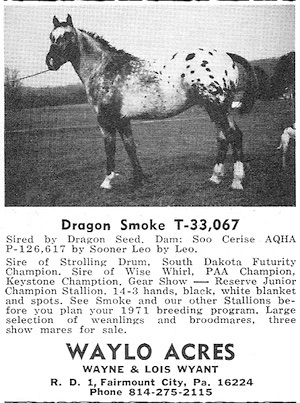
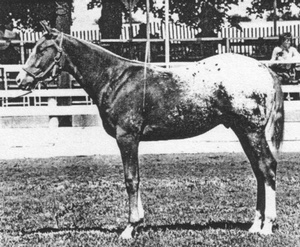
Wise Whirl
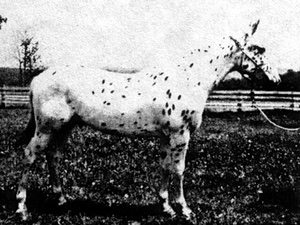
Cloud Hill

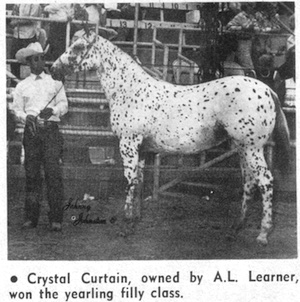
SWENSON “SMS” LAND and CATTLE COMPANY
The Swenson Land and Cattle Company was founded in 1883 at Stamford, Texas. The size of the SMS has been argued, ranging from 350,000 to 500,000 acres. The SMS is said to have started its ranch horse herd with 50 Spanish mares and a white Arabian stallion. Added to the gene pool would be Missouri saddlebreds, a Thoroughbred, Spanish bred stallions from the King Ranch, grade Percherons and Clydesdales (with Spanish dams), a German Coach stallion, a TB X Standardbred stallion, registered Morgan stallions {Red Bird 6775 and Gotch 5979} and 7 mares, 3 Remount Arabian stallions {Ghabir, Niwad and Rashid}, and a Remount TB stallion {Gordon Wells}. The SMS had its greatest impact on the Quarter Horse but was also a known breeder of Morabs.
The cross of the Spanish mares on the white Arabian stallion, called “Arab”, is said to have produced many white horses. The SMS Ranch was known for mounting the entire outfit on white horses for special occasions as late as the 1920s. As was usual, early breeding records or pedigrees were not well kept, if at all. Many of the producing mares and stallions, and stallions and mares produced in the early SMS program, were simply noted as “Swenson mare”, “Swenson stud” “SMS mare”, “Swenson dun”, “Swenson dam”, and so on. I have pedigrees that show a stallion as “Swenson’s Horse (aka Luther Jones)”, sired by Watch Charm (TB). The SMS program also used Triangle, Waggoner and Burnett lines. The SMS purchased the pre-registry QH sire Young Yellow Wolf from the Waggoner program.
Descendants of the SMS breeding program found their way into the Buchli Cattle Company (Montana), the Tongue River Ranch of Dumont, Texas (originally part of the Swenson Ranch before 1898), the Burnett Ranch, and the Pitchfork Land and Cattle Company—all AQHA breeders. ApHC breeders with these descendants included Stroube Appaloosa Horse Ranch (Texas) and Bo-Mar Farms (Kentucky). Appaloosa descendants of SMS bloodlines are quite numerous, including Waps Spot 2 162978, Wallowas Jubilee 613619, Tico Star T90647, Quanah’s Mist T22694, Wap’s Reflection 423433, Tico Tornado 22692, Mighty Aquarian CN424347, Shesa Sissy Too T196751, Equal’s El Charro 125823, Wapiti’s Dido Silver 47094, Lins Impresive Cabin 600899, Bugs Malone 509523, Wallowa’s Elegance 646300, Equally Bright 502909, Why Not 57504, Andrews Bright Sky 534529, and many others.
BURNETT RANCH
The Burnett Ranch, in King County, Texas, was founded in 1900. The 350,000 acre ranch carried the ‘6666’ brand. Burk Burnett bought the ranch from the Louisville Land and Cattle Company and named it the ‘6666’ after the brand on his first herd of cattle. Burnett got along well with the Indians, leasing thousands of acres of Indian land for the cattle prior to 1889 The headquarters and horse operations were done south of the Red River, in Texas, leasing 300,000 acres from the Kiowas and Comanches. Pre-AQHA Burnett horses included Joe Hancock (1/4 Percheron), Redolent (registered Morgan), Tom (aka Scooter--1/4 Arab), TB Remount stallions, Jubilee King (registered Morgan), and some registered Morgan mares. [Note: it is thought that the silver dapple gene in the QH came from the Morgans in the Burnett horse program.] The registered Arabian stallion, Montefik was also used in the Burnett program. [NOTE: his grandson Monte Hancock is double registered AQHA-Appendix and ApHC.] The 6666 registered both NQHBA and AQHA. The Burnett program used the pre-registry QH sires Burnett’s Yellow Boy, Burnett’s Yellow Wolf and Yellow Jacket (by Yellow Jacket), all bred by the Waggoner Ranch.
Many Burnett QH lines went into the Appaloosa, Paint, and Pinto. [NOTE: The AQHA has old records showing the Burnetts brought a large band of unregistered palomino mares from Mexico, which are thought to be the origin of the champagne color in the AQHA.] A sale advertisement for Spike Van Cleve, of Melville, Montana, found in the July 1947 issue of the Bit and Spur Magazine, show three QH mares named Red Girl, Lady Buck, and Sally Grey, being noted with breeding going back “to 1867 when Capt. D.H. Snyder, Georgetown, Texas, bred 15 Spanish dun mares to old Steeldust.” Some of the “Snyder mares” were products of the Burnett program [NOTE: I have this same Spike Van Cleve information from the same publication from Pat Mefferd]. The R.A. Brown Ranch, of Throckmorton, Texas, used Burnett and Steeldust lines in their ranch horse program.
Some Burnett bloodline horses included Roan Hancock AQHA 456, Dan Dee Bar II ApHC, Otoe AQHA, Cowboy Justice ApHC, Obvious Conclusion AQHA, Sonny Dee Bar AQHA, Alias Smith and Jones ApHC, Han D Echo ApHC, Kid Clu AQHA, Sully B Hancock ApHC, Dreamfinder 407333, Blue Valentine AQHA, Patchy Topa Too ApHC, Bob’s Folly AQHA, Circle S Cougar ApHC, GA’s Sundance Image ApHC, Joker B Jiggs ApHC, Alias King ApHC, Norstas Apache Snocap ApHC, Top Hat H ApHC T4164, and Buck Hancock AQHA 1479. Some of the Burnett bred horses would also go into the Triangle QH program, the Miller ‘67’ program, and the Swenson AQHA program. It is thought that the Steel Dust mares that Coke Roberds brought from Texas came from the Burnett Ranch, and may have had Appaloosa genetics.
Some Roberds’ Steel Dust based and other lines went into the Frank and/or Robert Parsons QH program in Weston, Colorado (still trying to determine connection to K.K. Parsons), whose AQHA and AQHA-Appendix bloodlines would descend into the Appaloosa through Ortiz’s Poco Spot T9415 (Lloyd Ortiz, Trinidad, COL), Sox Tosty Supreme T372647, Dragon Smoke 33067, Wise Whirl T108687, Cloud Hill T94493, Spectra T9414, and Crystal Curtain 69763 (Osment lines). Robert Parsons got the unregistered QH stallion Frank (Primero line) from Coke Roberds and used other Roberds’ lines.
The Burnett-bred stallion Moco Burnett AQHA 1608 was owned and used by A.T. {Cap} McDannald (have also seen McDonald), of Texas. This stallion is found in many of the Appaloosas from the McDannald program. A few of Moco Burnett daughters, used by McDannald were registered AQHA with the “Hartsel” prefix, although most of his “Hartsel” daughters were unregistered QHs and just given program ID numbers [example Hartsel mare 42, Hartsel mare 10, et. al.]. He also just had numbered mares without any prefix [Mare No. 48, Mare No. 61 and so on], with no breed designation. The “Hartsel” prefix was even carried over to some of the daughters of the “Hartsel” -NR-QH mares, [Hartsel mare 65, (-NR- Appaloosa by Spotted Eagle F2080, Hartsel Mare H 17 (-NR-Appaloosa by Spotted Eagle), etc..). McDannald bred his “Hartsel” QH mares to his Appaloosa stallions Spotted Eagle F208 or Osage Flash F2021, and later Tartan McDannald F1819 (son of Spotted Eagle). McDannald also used the stallion Tex North AQHA P30498, a product of the King Ranch program, on some of the Hartsel QH mares. McDannald would also use unregistered mares with the “McDannald” prefix (McDannald mare No. 73, McDannald Mare H-2, McDannald Mare #73), as well as just numbered mares (Mare No. 19, Mare No. `26, etc..) to produce some of his registered Appaloosas.
The Hartsel prefix came from the Hartsel Ranch, established 1862 by Samuel Hartsel, in Hartsel, Colorado. One assumes that the ranch owned the horse at one time, hence his name, but AQHA records do not show this. The Hartsell mares used by McDannald came from the Hartsell Ranch. Moco Burnett can also be found in some APHA horses. The JMB Appaloosa Ranch sold a daughter of Osage Flash 2021 (out of Hartsel mare 15 -NR-App by Spotted Eagle F208 in July 1963—named Osage Dusk T18781, and the colt Skiatook T6083 (Kaw Liga 1725 X Hartsel Babe AQHA P26580 by Moco Burnett AQHA). McDannald would later use Rustler Bill T1546 on Moco Burnett daughters. “Cap” McDannald, a wealthy oil (McDannald Oil Company) and cattleman in Texas and Colorado, purchased the Hartsel Ranch 1946 and the Ken-Caryl Ranch in 1949 (owned by Italian real estate tycoon Joseph Minissale, who raised cattle and thousands of turkeys on the ranch). In the late 1930s McDannald purchased the Pioneer Adobe Ranch on the south side of the San Augustine Plains, New Mexico.
MATADOR RANCH
The original Matador Land and Cattle Company, of Matador, Texas, was founded in 1882 by an investment group of five Scotsmen. In the 1950s the original ranch changed hands and part of it would be purchased by Fred Koch in 1953, along with the “Flying V” cattle and the “50” horses (aka 50M and Fresno 50). Koch would rename his portion the Matador Cattle Company. The Matador Land and Cattle Company, 1.5 million deeded and 1 million open acres, was headquartered in Channing, Texas. The Alamositas Pasture section of the XIT was purchased by the Matador. By 1910 the Matador Land and Cattle Company owned 861,000 acres in Texas, and had 650,000 acres leased in SD, and 500,000 acres leased in Montana, and 300,000 acres on the Pine Ridge Indian Reservation in South Dakota. The Matador had the northern portion of the Cheyenne River Reservation leased in the late 1940s and 1950s, while the southern portion was leased by the Diamond A Ranch (Thatcher, Colorado and Wagon Mound, New Mexico). The Matador also had ranches in Brazil. The Matador bred pre-registry QHs, as well as horses registered NQHBA and AQHA, with lines that would later go into the Appaloosa, the Palomino, the Pinto, and the Paint. One of the noted QH sires on the Matador Ranch was Sheik AQHA 11 (by Peter McCue), who they purchased from Coke Roberds and brought to Texas by Coke’s brother Emmett Roberds, along with other Coke Roberd bred horses. Emmett Roberds is said to have worked most of his life for the Matador Ranch and was sent to Brazil in 1916 to work on one of its ranches there. Another noted sire, Hollywood Gold AQHA 2220, was used by former cattle company president John Lincoln, building a strong base of ranch working stock from this line. The ranch also used several Remount Service stallions and Morgan stallions from the Richard Sellman ranch in Texas.
Senator Casimiro Barela, who owned 25% of the Matador Ranch at one time, owned the Thoroughbred race horse Leadville, who would sire the stallions Senator (aka The Senator) and Primero. Coke Roberds would later purchase Primero from Barela’s Trinidad, Colorado ranch, to use in his own program in Colorado, with a basis of Steel Dust mares from Texas. Some say the Steel Dust mares came from the Burnett Ranch (see above), which had a lot of gray and roan. Primero was killed on the train trip to Hayden, Colorado, and Roberds would replace him the famous stud Old Fred. Prior to Roberds moving to Colorado, he worked on the XIT Ranch in west Texas.
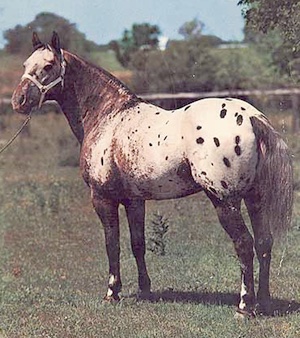
Rustler Bill
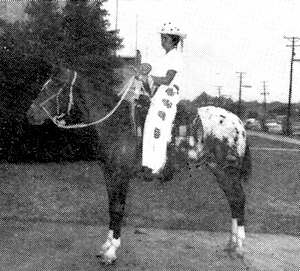
WRanglerBill
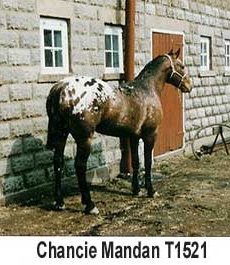
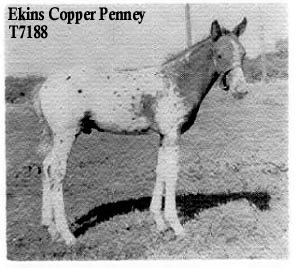
One of the most noted Appaloosa descendants from the Matador program is Rustler Bill F3372, a son of Matador Dun AQHA (Sheik AQHA 11 X Matador QH mare). Rustler Bill [photo Western Horseman 6-1969) had three full brothers-- named Wrangler Bill 5958, Cheyenne D Bill T5106 and Chancie Man Dan T1521 [photo/ad Western Horseman 4-1959], and a half-brother That’s Wild Man T65591 (That’s My Boy AQHA 38436 X Cheyenne Gold F2671). Rustler Bill would be used in the A.T. ‘Cap’ McDannald Appaloosa program on daughters of Moco Burnett AQHA 1608 (bred by Burnett Ranch).
Another notable descendant of the Matador program is High Hand 3366 (by Hands Up), who traces his Matador heritage through his dam Deacon Bess AQHA 16204, back through her dam Kansas Ginger AQHA 6014, who is a daughter of a “Matador mare”. [NOTE: in the Dispersal Sale of High Hand Ranch catalog, November 18, 1965, High Hand’s pedigree shows dam as Decon Bess 16204, and granddam as Kansas Ringer 6014].
Other Matador Appaloosa descendants included Woods Stormy Day 21426, Ozark’s Leopard King F4323, Bold Print 173189, Post Haste 148815, DRC Vintage Design 640614, Rollin A Little Doe 569228, Boogie’s King-Bee T182266, Ekins Serenade 11577, Sanskrit 54727, DREA Celilo Jingles, Lonsum Knight 315709, Bright Banner 8514, Beau Cheno 98251, Tuff Tonys Babe T336961, Stay Ready Too T282237, Mr. Postman 34339, Norgren’s Bright Bars 40802, The Conductor T222187, Frog’s High Hand T69061, Strawberry Bill T8111, Imboden’s Sun Rocket T1395, some of the Ochoco-bred horses, High Hand Jan T5274, Norstas Domino, DREA Celilo Topatchy, Tobys Kopperstone, Monte’s Hawkeye 371793, and hundreds of others.
Matador lines also went into the Ekins ApHC program, Pleasant Grove, Utah, along with bloodlines from the Coke Roberds and the Waggoner programs. The stallion Ekins Copper Penny T7188 traces to a “dun Spanish mare”. AQHA, Palomino and Appaloosa/CRHA-NR breeder, J.P. McWilliams owned Matador’s Golden Dave PHBA 7603/AQHA 10474. McWilliams lines went into the C.S. Danley and the T.F. Osment Appaloosa/CRHA-NR programs, John L. Baker’s Hydaway Ara-Appaloosa program, Glen Coons’ G-C Ranch ApHC and POA program, and the J.E. Baker Appaloosa program. Matador lines, along with other Coke Roberds lines also went into the Robert Parsons QH program in Weston, Colorado (advertisement Appaloosa News 9-1965), which later would descend into the Appaloosa.
TRIANGLE RANCH
The Triangle Ranch bred pre-registry QHs, and later NQHBA and AQHA documented horses, that went into the Appaloosa, Palomino, and Paint. Some of the Burnett bloodline horses that went into the Triangle program were daughters of the Morgan stallion, Redolant. Others were progeny of Roan Hancock AQHA. The Triangle Ranch program bloodlines went into horses like Two Eyed Jack AQHA, Mr. San Peppy AQHA, All Hands On Zip ApHC, Go To Impress ApHC, Hooked On Scotch ApHC, Steel Bars AQHA, Kelo AQHA, Bar Heels AQHA, The All Star ApHC, Revenue H AQHA, Ha-Dar Shado ApHC, Rockledgetoswirahtlc ApHC, Charlos Red Eagle ApHC, Colida Twisted Lace ApHC, and Hollywood Gold AQHA, to name only a very few descendants.
Triangle Ranch lines would go into the Jim Minnick AQHA and NQHBA program, along with Waggoner Ranch bloodlines. Minnick was a nationally known polo player and the AQHA’s first inspector. In breeding polo ponies, Minnick used several Remount TB stallions to sire his AQHA registered horses. Minnick bloodlines went into the Palomino, and also into the ApHC, through such horses as All Inclusive ApHC, Tobano Rip AQHA, Embers ApHC, ENR’s Joker Jocko ApHC, Docs King Chex AQHA, Nylon Lad AQHA, Chief Antelope ApHC, North Star’s Sweetheart ApHC, and Joker’s Dun Spot ApHC, to name a few. T.F. Osment and son of Chelsea, Oklahoma (ApHC, CRHA breeders) would use Minnick bloodlines in some of their NQHBA horses. The Roy Schenk AQHA program, Chickasa, Oklahoma, would also use Minnick bloodlines, and some of the Schenk QHs were by the Waggoner Estate. Schenk lines were found in the Creswell Farm Appaloosa program.
MILLER ‘67’ RANCH
The Miller ‘67’ program, at Big Piney, Wyoming bred pre-registry and early registered Appaloosas. Their most remembered sire was called “The Miller Horse”, aka Ding Bob II (unregistered Appaloosa) aka Ding Bob Jr, who was a grandson of Sheik AQHA 11 and Ding Bob AQHA 269/NQHBA 4220. Ding Bob II was often bred to TB or TB cross mares, listed in various pedigrees as “Miller 67 mare”, Miller Zev mare (Zev—TB stallion), “Miller mare”, “Miller TB mare”, “Miller range mare” or “Miller mare by Zev”. “The Miller Horse” also sired at least one NQHBA registered horse. There are horses in the Paint registry with “Miller 67 mare” listed as the dam. Some of the “Miller mare” are shown to have been sired by Ding Bob 2 NQHBA 9760, some by Ding Bob Jr. NQHBA 9760, others by Ranger Hancock AQHA 3994, some by ZEV (TB), one by Blue Dog AQHA 7821, and one by Black Twist AQHA 19394. Some of the “Miller mares” are shown as unregistered QHs, while others are shown as unregistered Appaloosas.
Some Appaloosas descending from the Miller ‘67’ program include: Hot Chocolate Chip 528117, Wa-Jos Chickabar T257713, Han “D” Echo 6977, VKS Thunder Moon 648929, Bobbie N F2675, Stoneacres Joker 3 #90379, Jockey Creek Joe 530282, Joker B Jiggs #B53022, Chic A Bob F3351, Handy Man W 13431, The War Lord T229218, Red Hawks Storm 493947, Tightsqueeze T130360, The Conductor T222187, Hakuba Jazz 569712, Bright Chip 20708, Make It Snappy 243433, Three Suns 101754, HH Cool Colors 538948, and many others. The Appaloosa mare Moose Milk 20509, dam of Joker’s Monte 28264, is out of a “Miller mare by Ding Bob II. The mare Blue 67 ApHC ID4604, the dam of Three Suns ApHC 101754 and other ApHC/CRHA registered horses, was also registered MQHBA 8833 (Model Quarter Horse Breeders Association) and carried Waggoner and Trammell bloodlines as well. The Appaloosa mare Chipeta A 3163, dam of Bright Chip 20708, is sired by Ding Bob II NQHBA 9760, out of a Miller TB mare. The AQHA mare Yellow Girl 17672 (Ding Bob II >aka The Miller Horse< X Miller TB mare) is shown to have produced Butchers Folly ApHC T1364 (by Butcher Boy AQHA P2146) [NOTE both parents AQHA].
WAGGONER RANCH
I have not found a lot of information that the Waggoner Ranch used horses of Mexican ancestry, but such ancestry was in fact present. Most of the ranches started in Texas, got many of their starting cattle and horses from Mexican ranches. The Waggoner Ranch was started in 1852, in northern Texas, just south of the Red River, near Vernon. The Ranch was started by Dan Waggoner and was originally called Dan Waggoner and Son Ranch. After Dan died in 1903, everything went to his son Tom, who renamed the ranch in 1923 to the W.T. Waggoner Estate, which covered 520,000 acres in 6 counties. There was also Paul Waggoner, who managed the Quarter Horse program at the Three D’s stock farm (an old TB race track), at Arlington, Texas. The Waggoners were neighbors and friends with the Burnetts, so you can be sure that breeding stock and bloodlines were exchanged and shared. The Waggoner breeding operations utilized TB sires, like many of the ranch programs during that time. Strideaway (TB) was used on the Waggoner Ranch, while the imported English stallion, *Royal Ford (imported by W.T. Waggoner), stood at the Three D’s. The Waggoner Ranch did in fact own the early pre-registry QH sire named Clover Leaf, who is said to be out of a ‘dun Spanish mare’. The ranch also purchased the unregistered Roberds’ bred stallion Buck Thomas for their program. [NOTE: after the formation of the AQHA, Roberds refused to register any of horses, despite being asked by some of the founders of the organization].
The Waggoner Ranch bred many pre-registry QH sires that went into other well-known programs. Adair’s Yellow Wolf went to the JA Ranch. Burnett’s Yellow Wolf, Burnett’s Yellow Boy, and Yellow Jacket (by Yellow Jacket) went to the Burnett program. Scharbauer’s Waggoner went to the Scharbauer program.
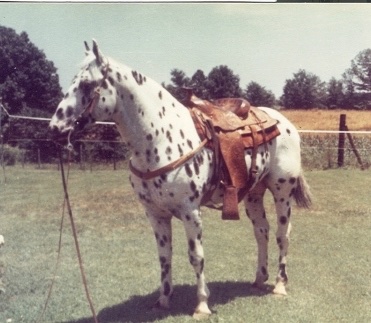
A noted AQHA and NQHBA sire, Chubby 656 is also a descendant of the Waggoner program. His bloodlines can also be found in numerous Appaloosas (ApHC and ApHCC). Probably the most famous descendant of Chubby is the leopard stallion Chub’s Powderface, whose bloodline was used in Frank Scripter’s “Ghost Wind” program. The Chubby line can also be found in many QH programs, including the Binford Ranch (TX), whose lines can be found in the ApHC.
Bloodlines from the Waggoner Ranch went into AQHA and NQHBA horses, as well as the APHA, the PHBA, the MQHBA, the ApHC, the ApHCC, the CRHA, and the AAA (Australia). ApHC descendants from this program include: Prince’s John 130528, Wolfs Tiny Bar 96409, Oakselah T346587, Sir Plaudit T71240, Dreamfinder 407333, Mistic Noble Favorit 565614, Kelo Connection 437805, Bright Banner 8514, Navajo Whirlaway 45695, Han “D” Echo 6977, Hakuba Jazz 569712, Bright Shannon 384823, Chicks Wonder 489662, Artfully Designed 604425, Apollo Creed 353835, Sox Tosty Supreme T372647, Mr. Goshen 68576, Bright Lad 294961, Nugget Jim 85969, Hes So Pretentious 589897, Umatilla Chief T65154, Pop Up’s Wagon Master 142842, Mighty Dun T156135, BWS Night Eagle 138485, Coke Roberds 5703, DREA Snowyrock Ghost 631672, Rustler Zip TW 17800, Deacons Tuff Babe 435492, Awe Striker 518636, Co Flight 50239, Absarokee Quasar, SRU Pile Of Clouds 557499, Shagbarks Starduster 612466, American Jester 647404, DZ Weedo 533898, Acclaim 341523, The Spot Broker 519946, Hot Chocolate Chip 528117, Dan Dee Bar II 201397, Cloud Be Proud 364756, Moon Me 518669, Chief Foxtail F4667, Three Suns 101754, 3N Dottie G T7137, some Cooterville horses, Quanah F706, Van Horn Waggoner F1700, Rasmussen’s Quavo 153214, some Ochoco -bred horses, Top Hat H T4164, and many more.
John Tolan used bloodlines from the Waggoner Estate program and the Schenk program in the “Tolan” (John and Mary) AQHA and ApHC breeding programs. Money Creek Ranch had Minnick bloodlines in their program. Minnick horses would go into the T.F. Osment and Son program, at Chelsea, Oklahoma, which produced NQHBA, PHBA, QHBA, AQHA, and ApHC registered horses, as well as unregistered Colorado Rangerbreds. Osment bred the grandson of Chubby, named Malta Wolf NQHBA 2541. J.E. Baker had Waggoner lines as well as McWilliams and Osment lines. Jim Wild had Roberds, Waggoner, King Ranch, JA, Triangle and Swenson lines in his Flying W program. The Snipes Appaloosa program used Waggoner lines. Jim Minnick, who played polo on Long Island and was a World Champion steer wrestler, used Waggoner bloodlines in his AQHA and NQHBA program. It is said that Minnick owned 1,000 horses at one time. At least one NQHBA pedigree shows that Coke Roberds had Minnick lines in his program. Waggoner lines, along with Trammell lines, are found in the T.J. Durrance and Son AQHA program (Florida). The Waggoner bloodlines were also crossed into the Blackburn QH lines. Harvey “Red” Foster, founder of the MQHBA owned NQHBA registered horses with Waggoner and King Ranch bloodlines.
BELL RANCH
The Bell Ranch was established 1824 in eastern San Miguel County, New Mexico. Its 290,000 acres came from the 656,000 acre land grant by Mexico to Don Pablo Montoya. Albert Mitchell, founder of the AQHA, would eventually manage the Bell Ranch, while owning his own ranch, the Tesquesquite Ranch. While managing the Bell Ranch, Mitchell shipped cattle to Old Mexico during the 1933-1935 drought to save them and the ranch, so one might assume that cattle and horses crossed the border in both directions. As founder of the AQHA, Mitchell got the NQHBA and the AQRA (American Quarter Racing Association) to consolidate with the AQHA in 1950 [Horse Lovers Magazine 1-1950; Bit & Spur Magazine 4-1949]. Mitchell’s father, T.E. Mitchell owned the 180,000 acre T.E. Mitchell and Son Incorporated, which was originally the Bar T Cross Ranch (owned by the Dubuque Land and Cattle Company—1881). The Bell Ranch owned the pre-registry QH sire ‘Mike’, who was bred by the CS Ranch. Little Joe Springer, son of the CS’s Little Joe was loaned to Albert Mitchell’s Tesquesquite Ranch, settling six mares before his death. Albert Mitchell’s daughter Linda married Les Davis, grandson of Frank Springer (CS Ranch) in 1953.
As was with many breeding programs with a large number of horses, the Mitchell stock is identified by a ranch prefix and number, if at all. Pedigrees can be found with “Mitchell mare”, Tesquesquite Lady (numbers 16, 18, 6, 25, 52, 28, 15, 3, 17, 216, 2, and so on), and Tesque Lady (numbers 50, 58, and so on). Bell Ranch QH lines, sometimes noted as “Albert Mitchell” mare, can be found in several QH programs, including the Binford Ranch (TX).
Images of Bell Ranch were long time promotion icons, being found on Stetson hat boxes, Marlboro cigarette ads, and the 1950s TV show “Rawhide”.
Bell Ranch QH lines were found in Appaloosa programs such as the Patocha Appaloosa Ranch (Texas) and Eze Acres Appaloosas (Tennessee). The registered Appaloosa gelding Tonka Man T27318, is a descendant of the Bell Ranch program through his dam Copper Light {have seen as QH-NR and as AQHA A9471 (Appx)}.
HEAD OF THE RIVER RANCH
The Head of the River Ranch was developed on the Concho River, near Christoval, Texas, by William (Billy) Anson. Anson is well known for his business of furnishing horses for the South African Boer War (1899-1902), selling over 22,000 horses to the British Army to be shipped overseas. A large majority of these horses came from western ranches, who used Remount TB stallions to improve their using stock. Anson, himself used the Remount TB stallion Dr. Howard (Mansfield Comanche fame). Dr. Howard is shown to have sired Doctor Russell (stallion, foaled 1923) and Adelante (mare, foaled 1924), both owned by Anson. Anson also bred another son of Dr. Howard, named Firecracker (aka Young Dr. Howard), maternal grandsire of Navajo Britches ApHC F2709. Anson also owned the noted early QH sire Harmon Baker. In a 1907 newspaper article, Anson called his stock “Texas quarter horses’, but others called them “polo ponies”.
Anson bloodlines went into other ranch programs. Little Joe aka Old Joe AQHA 2, sire in the CS Cattle Company program, was out of an “Anson mare by Jim Ned”. Jim Ned can be found in Half-Bred pedigrees. The unregistered stallion Silvertail, used by Coke Roberds, was also out of an “Anson mare”. Anson bloodlines went into the AQHA, the NQHBA, the ApHC, and the HBSB (Half Bred Stud Book). The pre-registry sire ‘Harmon N’, bred by Anson was sold into Mexico.
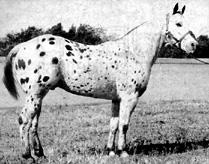
Joker B F-678
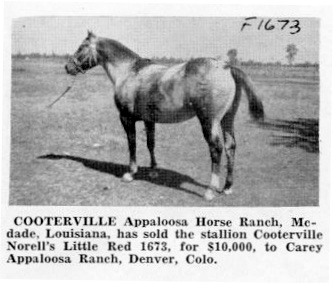
The history of Anson’s breeding program brings to light the omitted use of draft stock (in the AQHA and ApHC) in breeding up the native using stock for improved ranch horses. Anson’s program brings some questions as to the claim that “old line” or “foundation bred” Appaloosas do not have any draft ancestry. Anson started his “Concho” program with registered Suffolks—1 stallion and 9 mares, along with 20 grade mares from Suffolk stallions. In 1909 Anson imported twelve registered Suffolks- a mix of stallions and mares. Most of Anson’s early breeding stock is often seen in pedigrees as “Anson mare”, “Anson stud”, “Anson mare by Jim Ned”, “Anson mare by Sam Jones”, and so on. One of the most famous “Concho” prefix horses became a noted pre-registry AQHA sire named Concho Colonel (noted as a “Steeldust QH” in some pedigrees). Concho Colonel would sire the noted unregistered QH sire Balleymooney, who would be used by Dan Casement’s Unaweep Canyon Ranch, Colorado, along with his ‘Steeldust’ sire Concho Colonel. Casement also used the Anson bred pre-registry sire Wild Cat. Balleymooney would sire the famous AQHA stallion Red Dog P55. Red Dog’s dam, Cinnabar -NR-QH, carries bloodlines from the CS program twice through Old Joe AQHA 2 as well as tracing to the Anson program. Red Dog would then sire the famous Appaloosa foundation stallions Joker B F678 and Cooterville Norell’s Little Red F1673 (also registered as AQHA as Norell’s Little Red). Both Joker B’s and Cooterville Norell’s Little Red’s dams traced their roots to the Coke Roberds’ program. Red Dog also sired Chipita NQHBA 1810, scores of AQHA registered produce, and many unregistered QHs. The Red Dog AQHA lines went into several ApHC programs including the Dick and Edith Stanger ‘Double Arrow’ program, Rimwold (Prince Plaudit), Gene Carr’s ‘Santee’ ApHC and POA programs, George Holzberger program, Cedar Hill program, Prince Charles Enterprises, Mavis Peavy program (AQHA and ApHC), Dewey Norell program (AQHA and ApHC), Dale McDole’s Cooterville program, Carey program, the ENR program, JDel Farm, Money Creek Ranch, Jim Wild’s Flying W Ranch, Cecil Dobbin’s Flying ~N~ Ranch (NOTE: ‘N’ is written backwards), George Holzberger (ApHc and CRHA), and many others. Anson lines are also found in the ApHCC, the PHBA, the CRHA, and the APHA. The Carey Appaloosa Ranch, Denver, Colorado, held a sale for what they promoted as “Red Dog Appaloosas”, advertised in the 9-1960 The Western Horseman.
Noted QH breeder J.W. (Warren)Shoemaker had Anson lines in his QH/Palomino program (mixed with Roberds’ Old Fred, Primero, and Sheik AQHA 11). Some of the Shoemaker-bred horses, many of which were also registered Palominos, that carried these bloodlines include: Watrous Dandy AQHA 63273PHBA 15620, Golddust Shoemaker AQHA 1094, Shoemaker’s Golden Slippers AQHA 4215, Red Bird Shoemaker AQHA 5231, Mister Nugget AQHA 57931, Ponjets Halo AQHA AQHA 130690, and Billy Cue NQHBA 3376, to name a very few. Many Appaloosas carry Shoemaker genetics. Shoemaker also drew bloodlines from the Hank (H.J.) Wiescamp AQHA/NQHBA/PHBA program in COL, whose stallion Skipper W AQHA 7964, with Coke Roberds’ bloodlines, is an icon of the QH breed, as well as a noted bloodline in the APHA, PHBA, and ApHC. Wiescamp’s first registered AQHA horse was a paternal granddaughter of Concho Colonel.
Another noted early QH breeder, Dan Casement, bred the pre-registry stallion ‘Interrogator’ (aka Terry aka Big Steve), who was sired by Concho Colonel. Interrogator would be owned by the Eden Valley Ranch in California. Casement would also breed the pre-registry QH Moon, sired by Concho Colonel, who was co-owned by Wiescamp. Casement lines can be found in the ApHC stallion Mr. Goshen 68576, tracing back to “Casement mares” on his dam’s side of the family.
Appaloosas with Anson lines include: Colida 7681, King Plaudit 55157, Mighty Tim 86102, Wapiti Jr 13685, Prince Plaudit 55156, Dutch Bob 26731, Mercury 3235, Tip’s Polecat T56158, Sonny Boy’s Red Man T32975, Bright Tiger 28126, Rinky Jinks 6110, Dial Bright Too 107308, Got Jet’Em T260225, Money Creek’s Monte-Lisa 121207, Pratt Toby Secret 316323, Mighty Bright 9760, Colored By Charlie 582317, DZ Weedo 533898, Big Lewie T151931, High Sign T199760, Shalako’s Plaudit 175427, Secret Weapon 100247, Maumin Red Penny ID16496, Chant’s World T171314, McCardo F3220, Sully’s Little Squaw 19665, The Executive 183779, Post Haste 148815, Mighty Paul 51858, Neon Warrior 558812, Mr. Postman 34339, Goldie’s Red Dog T154799, Hollywood Tom Cat 267498, Domino’s Red Dog 35399, G.W. War Charger 310023, Deacon’s Dude 558548, Hard To Beat 76094, QAR Mr. Executive 567687/ApHCC 31841, Bay Hancock T38262, Lil Linus Plaudit 500585, Sen Sen’s Mr. Skip T319934, Joker’s Monte 28264, Wap Spotted 464460, some Ulrich-breds, Dreamfinder 407333, War Don 21774, some Scripter-breds, some ‘Coffee Cup’-breds, and scores of others.
THE HEARST RANCHES/CORPORATION
The Hearst empire was started by George Hearst, who was an U.S. Senator (appointed 1886), a lawyer, a miner, newspaper man, and had other businesses as well. George would get the Rancho Piedra Blanco Land Grant in 1865, in San Simeon, California, which would become Hearst’s San Simeon Ranch. George was the father of William Randolph Hearst, who would take over the newspaper business from his father. William also inherited the San Simeon Ranch, as well as a 1,000,000-acre ranch in Mexico (Vera Cruz and Yucatan) from his mother. George’s grandson George Randolph Hearst would become the Vice President of the Hearst Corporation. George Hearst would become law partners with James Ben Ali Haggin, who also worked in legal matters with Lloyd Tevis.
Law partners Tevis and Haggin would own 400,000 acres in Kern County, and 1,000,000 acres in Arizona and New Mexico. Haggin and Tevis would acquire the Rancho del Paso (aka Haggin Oaks) in 1862, a 44,371 acre Mexican Land Grant located in Sacramento County, Caifornia. They purchased the land from Samuel Norris, who was in legal debt to Haggin and Tevis from court costs for trying to get ownership of the Rancho del Paso land. Haggin was claimed to have had the largest known TB breeding operation, with up to 30 stallions, over 560 broodmares in foal, and over 2,000 young horses. Haggin would use Rancho del Paso for his well-known horse breeding facilities until 1905, when he moved his operation to Elmendorf Farm in Lexington, Kentucky.
George Hearst would become business partners with Haggin and Tevis in the Hearst, Haggin and Tevis Mining Company, which owned the Anaconda Copper Mine (Montana), the Ontario Silver Mine (Utah) and the Homestake Mine (South Dakota). George also had interests in the Comstock Lode Mine (Nevada), the Ophir Mine (Nevada), the Pacific Mine (New Mexico), and the Cerro de Pasco Mine (Peru, South America).
Tevis was the President of the Wells Fargo and Company 1872-1892, co-owned the California Steam Navigation Company, was President and co-owner of the Pacific Ice Company, owned 1300 miles of stage coach lines and horse drawn street car lines in California, and owned thousands of sheep and cattle. [NOTE: The “Western States Trail Ride” (Tevis Cup) founded by Wendell Robie, was a 100 mile/24 hour endurance ride, to honor Tevis. Parts of the trail covered in this event follows the old Wells Fargo trails. There is also a James Ben Ali Haggin Cup (aka Haggin Cup) awarded to the “superior condition” horse after the race].
Hearst (Piedra Blanca Rancho), as well as Tevis and Haggin (Rancho del Paso- Sacramento) would share business deals with the likes of Leland Stanford (TB and trotting horse breeder), Elias Jackson “Lucky” Baldwin (Rancho Santa Anita- Los Angeles), Marcus Daly (22,000 acre Bitterroot Stock Farm in Ravalli County, Montan) James G. “Jim” Fair (U.S. Senator 1881-1887—discovered the “Big Bonanza” at Comstock Lode), Theodore Winters (Rancho del Rio), Roland C. Hill (Horseshoe Cattle Company- Morgan breeder), and many other notables of the equine world at that time.
[NOTE #1: “Lucky” Baldwin’s Santa Anita Rancho was established in 1873, with an original 8,500 acres, and grew to 54,000 acres. His Anoakia Breeding Farm would produce TBs, Arabians, Arabian X TBs, Percherons, Spanish jacks and jennets, mules, and later Belgians. The ranch also had 20,000 sheep and 2,000 dairy cows. Some of the horses from Baldwin’s program can be found in Appaloosa pedigrees, as well as QH and Palomino pedigrees today. The TB stallion Cruzados has Appaloosa descendants through Lantados (TB), Red Lantados (TB—have also seen QH-NR), and Rey El Rio (TB). The Arabian stallion Ibn Mahruss AHR 22 has Appaloosa descendants through El Sabok (AHR 276—Remount), Stambul AHR 575—Remount in ORE), Oman AHR 570—Remount in ID), and Aldebaran AHR 778 (foaled 1930). El Sabok also descends from U.S. Grant’s stallion *Leopard AHR].
[NOTE #2: Daly was partners with Tevis, Hearst and Haggin in the Anaconda Copper Mining Company. Daly was also a well-known horse breeder, whose Riverside Stable produced TBs, trotting stock, Percherons, and coach horses]
*GRAY RANCH--
The original Gray Ranch was established in the “bootheel” of southwestern New Mexico by Michael Gray in 1880. Part of the Gray Ranch was made up from the Lang Ranch. The ranch was often attacked by roving bands of Apaches or by groups of Mexican thieves who crossed the Mexico border to steal goods and livestock. James Ben Ali Haggin bought the Gray Ranch in 1882-1883, contracted by George Hearst. The Hearst and Haggin purchase would be renamed the Victorio Cattle Company or the Diamond A Ranch (see below). Michael Gray would re-establish his ranch in the foothills of the Chiricahua Mountains at Camp Rucker in 1883, calling it the Camp Rucker Ranch. The ranch would be sold in 1897 to the Erie Cattle Company.
*DIAMOND A RANCH --
The Diamond A Ranch came into being in 1882-1883 (depending on source). California businessmen and partners in a law firm George Hearst and James Ben Ali Haggin purchased The Gray Ranch which they renamed the Victorio Cattle Company (aka Diamond A). Californians George Hearst, James Haggin, Lloyd Tevis and Addison Head came to New Mexico because of mining interests. Haggin had mining interests from Alaska to Chile. Hearst owned mines in both North and South America, and had large land holdings in several states, as well as the Baricora Ranch in Mexico.
In 1882 Haggin bought the 160 acre Cow Spring Ranch, as well as the Gray Ranch (see above). Haggin and Tevis’ Kern County Land Company was the parent company of what would become the Diamond A Ranch. Between 1880 and the 1890s Hearst, Head and Haggin recorded over 100 land transactions. The Diamond A Ranch would come to include the Fitzpatrick Ranch, John Gray’s Taylor Draw, the Double Adobes, Clanton’s Animas Creek, the Lang Ranch (located on the border it was part of the original Gray Ranch), Animas Valley Ranch, and the Apache Tejo (aka Apache de Ho). Addison Head bought cattle in 1883 from the Corralitos Cattle Company in Mexico and more a few years later.
*HEARST RANCH--
The William Randolph Hearst Ranch in California is based on an original Mexican land grant, documented in 1852, when Jose de Jesus Pico claimed the Rancho Piedras Blancas containing 48,000+ acres. This land would become part of the Hearst Ranch. The Hearst company, known as Piedmont Land and Cattle Company, would also buy 600 acres from J.H. McGovern in 1914. The Piedmont would go on to acquire 160,000 during the 1920s, before adding the Rancho Milpitas, which covered 43,000+ acres in 1925. In 1922 Piedmont would also buy five of the former San Antonio Mission ranchos in the San Antonio Valley, after they had been consolidated. Hearst Sunical Land and Packing Company (included James Brown Cattle Company) and/or Hearst would go on to own most of the Rancho Milpitas, Los Ojitos, El Piojo, San Miguelito, and most of Jolon, for a rough total of 200,000 acres. The Sunical division of the Hearst holdings also owned the 900,000 acre Babicora Ranch in Temosachic, Chihuahura, Mexico. In 1922 Hearst would also buy the Newhall Land and Farming Company land (a total of 6 land grants covering 38,000 acres), which was adjacent to George Hearst’s San Simeon. History shows that buildings and corrals for horses were at San Simeon as early as 1810.
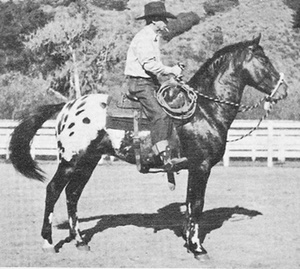
Appie
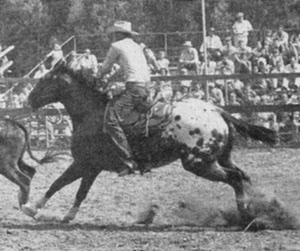
ChiefTapo
Hearst and the subsidiary companies bred registered Arabians, registered Morgans, Morabs, Palominos (registered and unregistered ancestry), double registered Arabians (registered as Arabians and with Jockey Club), Anglo Arabians, Crossbreds, and/or one registered Appaloosa. Some of the registered Arabians bred by the Piedmont Land & Cattle Company were sired by *Ferdin AHC 613 (sire of Claude Thomson’s Ferras). Some of the Arabians bred by the Sunical Land and Cattle Company (have also seen Sunical Land & Livestock Department) were sired by the U.S. Remount stallion, Jedriss AHC 3664 (used by Lester Riley to sire Appaloosas) Riley also owned at least one Hearst-bred Arabian mare. The Morgan program, of which there were over 100 registered horses, used the prefixs ‘Hacienda’ and ‘Piedmont”. Hearst purchased Morgans from Roland C. Hill (Horseshoe Cattle Company- California), who had breeding stock from Richard Sellman. Hearst would send some of his Morabs to his Mexican ranch. The Appaloosa, a stallion named Appie F338, shown to be bred by San Simeon Stables (Hearst Ranch), was sired by a horse called Rancher, out of a mare named Soto. Appie would sire Chief Tapo T429. Pat Mefferd research states there were unregistered Appaloosas among the years of Hearst breeding ranch stock, and some of those horses were later owned by George Spahn. Hearst also owned the pre-registry QH sire Millinette, who was at least 1/2 TB. Hearst’s Palomino program would be connected with the Swaggart Palomino program in Oregon and noted QH breeder Warren Shoemaker’s program.
XIT – CAPITOL FREEHOLD LAND AND INVESTMENT COMPANY LIMITED
This ranching enterprise covered all or portions of 10 counties in Texas, totaling 3,000,000 acres, and had 2,000,000 acres in Montana as a finishing ranch. The XIT, as it was called had many different sections of ranch area, including the Yellow Houses ranch near Lubbock, Texas; the Spur Company (acquired 1882 or 1883) which in itself had about 115 stock different brands; Buffalo Springs pasture; Capitol pasture, Alamostitos pasture, Mojares pasture; Rito Blanco pasture and calf pasture; Carrizo pasture, Agua Frio pasture; and many others. The Montana finishing ranch was located between the Yellowstone and Missouri Rivers, and included the Cedar Creek Ranch and the Hatchett Ranch among its land holdings. The Rita Blanca Division (64,000 acres) of the XIT would be purchased by the Reynolds Ranch in the late 1920s.
Ranch history says the ranch had “thousands of horses”. The first horses were imported from south Texas and were mainly older Spanish horses (with Mexican brands), that were mostly red roans and grullos. The book 6000 Miles of Fence has some color descriptions of the XIT horses throughout the years, from various solids, to grullos, and paint/pinto, but no Appaloosas. The XIT influence on the AQHA and ApHC cannot be traced through pedigrees like many of the other ranches’ influences were, because there are no “XIT” horses noted in pedigrees, so whatever influx of Mexican breeding into the QH and/or the Appaloosa cannot be determined. The XIT purchased the pre-registry QH stallion School Boy, who was bred by Thomas Trammel.
KING RANCH
A book in itself could be written about the King Ranch and the influence it’s QH program has had on the Appaloosa breed. Captain King and his partner Gideon K. (Leggs) Lewis set up their first cattle camp in 1852, and would purchase the Rancho de Santa Gertrudis in 1853, from the heirs of Juan Mendiola. The King Ranch, once over 1 million acres, was built on many Spanish and Mexican land grants, and carried almost 40 different brands, many of which were of Spanish or Mexican influence and/or origin. By 1861 King owned about 3,000 horses and 20,000 cattle. The King Ranch stock was full of Mexican influence, which was crossed with Arabian and Thoroughbred (Remount and unregistered). The original ranch program was to breed blooded purebred stallions from Kentucky to the Spanish type non-uniform grade range mares (also called “Spanish mustang mares- depending on source). Later as the ranch ‘s needs grew and progressed, the saddle horses would be upgraded with Remount stallions and other desirable breeds, eventually bringing the ‘high-grades’ into purebred status and AQHA registrations. Sources vary in King’s use of native stock, with one source stating Capt. King would not use the wild horses or cattle that were found on his range, while another source said that King used the mustang mares in his beginning horse breeding program. The wild cattle and horses were considered worthless and a waste of pasture, so were rounded up and driven into Mexico. Instead he preferred to get his ranch stock from Mexico, and King purchased livestock from Mexico, as well as hired Mexican workers, moving them and their families onto the ranch. Captain King bought livestock from Mexicans specifically south of Camargo, and from Pedro and Anselmo Flores at Tamaulipas. [NOTE: This would be the same Tamaulipas where the Huasteca Indians were located, that had Appaloosas (leopards and other patterns), and where Dragon POA 103 is said to be from].
King would add bloodstock to his horse breeding program from the Canales Ranch, the Pyle Ranch, the Lazarus TB program, and Guadalupe el Torero Ranch. Waggoner lines can be found in the King Ranch program. Oddly enough with the QH being touted as western based, the famous King Ranch stallion, Old Sorrel, had his roots in Illinois. It was found that the lines of early QH sire Little Joe (grandsire of King P234 and Rialto P2) ‘nicked’ with Old Sorrel. Some of the King Ranch foundation mares were varying degrees of roans. The King program produced sought after ranch horses. While King sold some, many others were stolen. King once said that between 1869 and 1872, that 978 horses had been stolen from his ranch.
Those involved in the King Ranch AQHA program followed the line of thought that the disposition and usability of the QH came from the Scottish Galloway stock. This was crossed into the Spanish stock (descendants of the Arab and the Barb), which was already in America, and in possession of the “Indians” [direct quote- NOT going to mis-quote to be politically correct]. [NOTE: the Galloway has been previously discussed as influencing the Spanish horses of the Caribbean breeding programs].
OTHER POSSIBILITIES [not proven] …
There were thousands of ranches of various sizes throughout numerous states and/or territories during the 1800s into the early 1900s. Many of these ranches were built on Mexican/Spanish Land Grants. It was estimated that there were 350,000 cattle in New Mexico in 1880, and those alone would require many horses in caring for them. Names changed, brands were absorbed into new ranch programs, and so on. Below are some ranches that might be possible sources of Mexican genetics either through location, time frame, and/or proximity to other ranches or areas with proven Mexican influences.
FORKER GAGE RANCH
This ranch’s holdings were 20,150 acres, but it was part of the larger Gage Ranch, which was established before 1883 in the Big Bend area. The Gage Ranch is one of the oldest Texas ranches, and covered 503,000 acres. Although I have found no records of Mexican influence, its location and time frame certainly make it likely. The Gage Ranch became the Presidio Livestock Company in 1883, with the purchase of the Running W Bar Ranch (from Edward Gage), leasing 68,000 acres and buying 14,000+ cows. E. L. Gage then started the Santiago Cattle Company in 1886, which had 52,000 acres under lease. In 1891 the Presidio and Santiago merged to become the Roscillo Land and Cattle Company, with 124,800 acres of land in Texas. After E.L. Gage died, the Alpine Cattle Company was formed in 1897, with 130,000 acres.
I have included this ranch in this research, since there are horses from this program registered in the ApHC. There are 46 mares registered in the “ID” portion of the registry. The mares are registered with the “FGR” (Forker Gage Ranch) prefix, with no names, just numbers [Examples—FGR 4, FGR 31, FGR 22, and so on]. ID Registration numbers range from 7534- 7555, 7567- 7590. The pedigrees I have checked to date (have not checked them all) show some of the mares as being sired by a “TB”, out of a “QH mare”; while the ApHC Database shows others with “unknown” parents. [NOTE: the ApHC will often show “unknown” parents as they claim the pedigree isn’t verified, but some parentage may be given in another source]
Registered Appaloosas from these FGR mares include Dandy Gage Queen 133475, Dandy Gage Lad 131702, Dandy Gage Diamond (aka Diamond P Bar) 131699, Dandy Gage Thunder T131700, Dandy Gage Grant T131701, Dandy Gage Kuana T131703, Dandy Gage Lucky T131704, and Dandy Gage Henry T131698—all bred/registered by Greenwood Farms and/or Forker Gage Ranch. All were sired by the foundation stallion Queen’s Dandy F4872.
TRAMMELL (Trammel) RANCH
Although I have not found any direct Mexican tie-ins for Trammell at this time, I will include him briefly in this coverage, as his program has had a large impact on the Appaloosa. The Thomas Trammell Ranch was near Sweetwater, Texas, and was started in 1883, after Thomas moved from his father’s (Philip) ranch, which was started in 1852, in Navarro County. Thomas (or Tom), known as the “Father of Sweetwater” started the first bank in Sweetwater, and would later acquire the Colorado River Valley Railroad. Trammell not only had 11,000 acres in Texas, but also had a ranch in New Mexico. Trammell was known as one of the largest cattle dealers in that part of Texas, and imported and bred registered Herefords. Trammell and his brother-in-law Jim Newman would be partners in breeding horses. Some of their notable QHs included Lucky Blanton AQHA 1746 and Revenue AQHA 2070.
Trammell lines can be found in many Appaloosas today, including Dreamfinder 407333, Alberta Mott Doolin 13705 (aka Alberta Doolin AQHA 157837), A Sundown Drifter 481102, Wild Hope 37245, The Secret 600257, Sahoma Dollie Badger T7733/AQHA 63594, Norstas Domino, Houston Jet 466666, and many others.
Noted AQHA sire Chubby 656 is a descendant of Trammell breeding. His bloodlines can be found in numerous Appaloosas. Some of his descending lines are listed in the above Waggoner Ranch section. Trammell also owned the pre-registry QH sire Sims Yellow Boy (aka Sims Yellow Jacket), who would later be owned by Dave Sims’ OXO Ranch. [see below]
IRVINE CATTLE COMPANY
The James Irvine Cattle Company of Tustine, California, was based on original land grants, one being granted to Juan Pablo Grijaiva in 1801, named the Rancho Santiago de Santa Ana, and the Rancho San Joaquin, originally granted to Don Jose Andres Sepulveda in 1842. Irvine would acquire 3800 acres of the Rancho Santiago de Santa Ana. Irvine would then acquire a portion of the Teodosio Yorba grant El Rancho Lomas de Santiago, in a partnership with Flint, Bixby and Company (would later become the Bixby Land Company). Irvine would later acquire part of Sepulveda’s Rancho San Joaquin
The original 1801 land grant to Juan Pablo Grijaiva, named Rancho de Santiago de Santa Ana, which covered 62,516 acres, was passed to Jose Antonio Yorba and Juan Peralta in 1810. By 1830 there were large herds of horses, cattle, sheep and goats on the ranch.
In 1846 Teodosio Yorba was granted 47,226 acres to be named the El Rancho Lomas de Santiago. Yorba would sell the Lomas de Santiago ranch to William Wolfskill in 1860. In 1866 Wolfskill, who also owned a share of the Yorba and Peralta grant Rancho Santiago de Santa Ana, would sell the Rancho Lomas de Santiago and his share of the Rancho Santiago de Santa Ana to Llewellyn Bixby (Flint, Bixby & Company- one of the largest land-owning and wool-growing companies in California), in which Irvine had an interest.
Don Jose Andres Sepulveda started the 48,803 acre Rancho San Joaquin with a land grant in 1842. The ranch owned about 3,000 horses, 14,000 cattle and 8,000 sheep. Sepulveda was a known an extravagant spender and big-time gambler who often bet the ranch and all that he owned on a single horse race. One such race occurred in 1852, against Pio Pico and his brother Adres. Interestingly enough, Sepulveda found an Australian mare, named Black Swan, in San Francisco, and brought her to his ranch to be his entry for the race. Black Swan, said to be the first positively recorded Thoroughbred mare to reach California, won the race by several lengths and the Pico brothers lost over 200 head of livestock – horses, cattle, sheep, goats—as well as $25,000 in gold. In 1864, Irvine would buy 1/2 of the Sepulveda ranch. Llewellyn Bixby would buy 3/20 of the Sepulveda ranch.
JA RANCH
The JA Ranch was founded in 1876 in Palo Duro Canyon, Texas, by John George Adair and Charles Goodnight. Goodnight established the ranch with 1600 longhorns driven in from Colorado, while Adair furnished the capital. The ranch was named for John Adair. In 1877 100 Durham bulls were brought in to improve the cattle. The ranch would include the Quitaque (Lazy F) and the Tule ranches, and have a total of 1,325,000 acres. The ranch sold horses to the New York City Police Department.
The JA Ranch used the pre-registry QH sire Adair’s Yellow Wolf, bred by the Waggoner Ranch program. The JA also purchased much of the original cattle stock and probably horses, from the Reynolds Ranch in 1876.
CS CATTLE COMPANY
The CS Ranch, founded by brothers Frank and Charles Springer, in 1873, was located near Cimarron, New Mexico. It was part of the Maxwell Land Grant and would grow to 180,000 acres. [NOTE: the Maxwell Grant, also known as the Beaubien and Miranda Grant, covering 1,714,764 acres, was considered the largest land grant given by Spain or Mexico]. The CS horse program would begin in 1885, based on a group of repossessed horses purchased by Frank Springer.
In the early 1880s, Maxwell Land Grant President, Frank Sherwin, bought 20 English Thoroughbred mares and the imported French TB stallion Uhlan. The horses were sold through a sheriff’s auction in 1885, where Frank Springer bought 2 stallions and 12 fillies. The CS program used the TBs Uhlan II and Ute Chief, and in 1912 purchased Little Joe (aka Old Joe aka Old Joe of New Mexico) a pre-registry QH sire from the Anson program. Little Joe lines would go into the Casement, Shoemaker, and Wiescamp programs. Wiescamp owned the QH stallion Little Nick (aka Nick Jr), who was bred by the CS. Casement’s Triangle Bar Ranch would breed the pre-registry QH sire Red Cloud, sired by Balleymooney (Anson program), out of a daughter of a “Springer mare” sired by Uhlan (TB). The CS neighbor, Waite Phillips’ Philmont Ranch would use Little Joe daughters and granddaughters to breed to Plaudit, and some of the mares produced by the Philmont program would be purchased by Hank Wiescamp, and bred to Skipper W, Spanish Nick, Skipper’s Lad and other Wiescamp foundation sires. The CS program also used the pre-registry QH sire Jiggs, who was bred by Coke Roberds.
Frank Springer’s grandson, Les Davis would marry Linda Mitchell in 1953. Linda’s father Albert Mitchell managed the Bell Ranch from 1933 until 1947. Ed Springer of the CS would be a horse breeding partner with Dan Casement in 1923-1924. Casement had horses tracing to “Springer mare”. The CS partnered with Casement to breed 20 Little Joe daughters to Casement’s stallion Balleymooney. Red Dog AQHA 55 was one of the resulting foals.
The CS and Philmont Ranches [NOTE: Waite Phillips’ Philmont Ranch was at one time 300,000 acres of the 1,714,765 acre Maxwell Land Grant aka Beaubien-Miranda Land Grant that covered part of New Mexico and Colorado] were sought after breeders of polo ponies by the beginning of the Depression. Will Rogers was one of their customers. The CS polo program was headed by the Englishman George Heming, who had been the head trainer for the Argentine breeding farm Martinez d’Hoz.
OXO RANCH
The OXO Ranch was founded in Kent County, Texas by Dave Sims. Sims knew the importance of good ranch horses, and along with running 1,000 cattle, he also raised horses that were in demand from other ranchers. Sims used Dr. Mack and Abe Frank, both TB sires in his program’s base. Appaloosa, Paint and QH pedigrees show “OXO mare by Dr. Mack”, or “OXO mare by Abe Frank”, “mare by Dr. Frank”, and/or simply “OXO mare”, as many large breeding programs didn’t name their mares.
Sims would also own the pre-registry QH sire Sims Yellow Boy (aka Sims Yellow Jacket), who was previously owned by the Trammell Ranch. This bloodline can be found in AQHA, APHA and ApHC pedigrees, including: Moorhouses Red Wolf AQHA 13245, Bar Nothing Springer AQHA 34962, The Spot Broker ApHC 519946, Roan Bar AQHA 74351, Big Time Hustler ApHC T300525, Gavit Bar AQHA, Sanpete Jewel ApHC ID14060, Texas Miller AQHA 17100, and Double-T-Onawandah ApHC, to name a few.
REYNOLDS ‘LONG X’ RANCH
The Reynolds Ranch was founded in 1868, by George T. and William D. Reynolds, on the Clear Fork of the Brazos River, near Fort Griffin, in Texas. The ranch, which carries the Long X brand, would consist of 232,000 acres. In 1871 the Long X moved their cattle to Bent County, Colorado, to the Point of Rocks Ranch. In 1875 the Long X moved its stock back to Texas. In 1876, most of the original Long X stock was sold to the JA Ranch. The Long X, which incorporated in 1884, had ranches in New Mexico, Arizona, North Dakota, and Montana, and ran cattle in Montana, Wyoming, Utah, Nebraska, and the Dakotas. In the late 1920s, Reynolds bought the 64,000 acre Rita Blanca division of the XIT ranch.
Sally Reynolds would marry John Alexander Matthews, who established the J.A. Matthews Ranch (aka Lambshead Ranch) in 1858 in the Clear Fork area of Texas.
GREENE CATTLE COMPANY aka “RO” RANCH
The RO Ranch consisted of a total of 257,000 acres in 1936.The original ranch was started in 1903 by William C. Greene, in the San Rafael Valley. The ranch straddled the U.S./Mexican border and had 3,000 horses. It was known as the Greene Cattle Company on the U.S. side of the border, and the Cananea Cattle Company on the Mexican side. Greene had 3 separate ranches, in Pategonia, Arizona, Chowchilla, California, and Cananea, Sonora, Mexico.
100,000 acres of the RO, came from the purchase of the ‘Baca Float’ in 1936. The ‘Baca Float’ name came from a lawsuit against the heirs of Don Luis Maria Baca in northern NM. The ‘Baca Float’ was one of five 100,000 acres land grants from Congress given to the Baca heirs in 1860, for their 500,000 acre Las Vegas Grant.
The RO, of Cananea, Sonora, MEX, bred and/or owned several pre-registry QH sires, including R.O. Sorrel, San Fernando Sykes, R.O.’s Sykes, R.O.’s Joe, Little Kid, R.O.’s King, Lover, and Son of Sykes. As the ranch properties were on both sides of the border, horses from both sides of the ranch were no doubt interchanged and interbred. RO bloodlines were used by Pete Smith, crossed into his Mansfield Comanche lines.
SPADE RANCHES (RENDERBROOK AND PANHANDLE)
The Spade ranches were two separate ranches owned by different family members of the Ellwood family. Colonel Isaac Ellwood and his son W.L. Ellwood came from ILL where they were well known for their herds of imported Clydesdales and Percherons. Col. Ellwood was one of the original patent holders of Glidden barbed wire. While in Texas, trying to sell barbed wire to ranchers, Col. Ellwood would become interested in the 130,000 acres Renderbrook Ranch owned by the brothers J.W. and D.H. Snyder. The Snyders originally purchased Renderbrook from J. Taylor Barr in 1882. Ellwood sent his son to purchase stock for their Renderbrook ranch. Looking to set up a ranch, W.L. Ellwood would buy stock and the “Spade” brand from the J.F. “Spade” Evans Ranch in 1880 who was in a partnership with another Glidden barbed wire representative. Also, in 1880 Evans purchased 23 sections of land from the J.A. Reynolds Ranch. In 1891, young Ellwood would buy 128,000 acres west of Lubbock, Texas from the same Snyder brothers, to become the Spade Ranch (Panhandle). The “Spade” cattle would be grazed on both the Panhandle and Renderbrook (Spade) ranches. Ellwood draft horses shipped in by railroad, were exchanged in both ranch purchases, as part of the purchase price.
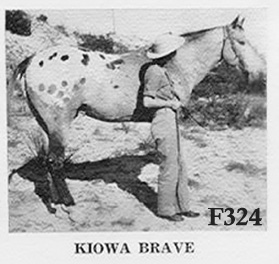
The Spade Ranch is another case, like the Anson program, that used a draft horse basis for its ranch horse breeding program. The Spade also used the Arabian stallion Matab (have also seen Metab) AHC 574. Spade Ranch lines went into the Davis Brothers (W.R. T.C. and Roy C. Davis) AQHA, NQHBA, and Palomino breeding programs when they purchased Palominos from the Spade. The Davis program, which used Golden Cargile (AQHA 4315, PHBA 2256, NQHBA 527) lines would produce one registered Appaloosa, Kiowa Brave F324, whose ancestry includes Anson and Indio Ranch lines. Davis Palomino lines would be crossed with Mansfield Comanche bred horses in later ApHC breeding programs. Top Button T6001 and Beau Lynn T6820 are examples of this.
Sources:
ApHC Stud Book Volumes -- 3 (Volumes 1 and 2 combined), 4, 9, 14, 16, 17, 18,21
All Breed Data Base
Appaloosa Pedigree Database; http://pedigree.appj.com
Correspondence (email and hand-written info) from Pat Mefferd; re: Dragon/The Dragon/Dragoon, J. Haddle-Davis research, Susan Larkin research, A.T. McDannald, Goblin T1875; Kiowa Brave pedigree T324, Mansfield Comanche F3096, Swenson Land & Cattle Company, William Randolph Hearst, Fred Bixby, The Kid, Starbuck Leopard, Spike Van Cleve QH pedigrees, Miller 67 Ranch, Jalama, George Spahn, L.J. Rose re: Appaloosas, Libyan Leopard, K.K. Parsons
Correspondence (email and hand-written info) from Debera Shields
Correspondence (email and hand-written info) from Cheryl Pederson; re: Ordell Pederson, DMA, Dell-My Acres, POA, Appaloosa and Morgan
Correspondence (email) from Dee Adkins; re: photos of Quanah descendant Painted Lady
Copy of letter from CRHA President John E. Morris to Pat M. Mefferd, 5-14-1979; re: Banjo -NR-Appaloosa; NOTE: This letter was sent to me from CRHA Executive Secretary some years ago. I also have a copy of same from Pat Mefferd.
Research projects by Sherry A. Byrd—"John E. Baker”, “Tolan, John and Mary” [re: Appaloosa, POA, NAPI, Welsh, QH and TB], “Appaloosa and Nez Perce Myths”, “Mexican Appaloosas”, “Mexican POAs”, “Dunn Brothers Mexican Appaloosas and POAs”, “American Appaloosa Association”, “Twila Merrill Program” [Paint, Appaloosa and POA], “Chickasaw Horse”, “Argentina Appaloosa”, “Pony of the Americas”, “Cooterville” program”, “Triangle Ranch”, “Burnett Ranch”, “Swenson Ranch”, “Matador Ranch”, “Coke Roberds” [AQHA, NQHBA, ApHC], “Rustler Bill”, “Money Creek Ranch”, “Jim Minnick”, “Schenk” AQHA program, “Miller ‘67’ “ program, “Ekins” program, “CS Ranch”, “Pitchfork Ranch”, ‘Greene Cattle Company” program, “JA Ranch” program, “Joker B F678”, “Cooterville Norell’s Little Red”, “Billy Anson”, “Bell Ranch”, “NQHBA”-National Quarter Horse Breeders Association, “MQHBA”-Model Quarter Horse Breeders Association, “QHBA”- Quarter Horse Breeders Association, “AQRA” - American Quarter Racing Association, “NQHR”- National Quarter Horse Registry, “NQHA”-National Quarter Horse Association, “PHBA”-Palomino Horse Breeders Association, “Quanah”, “King Ranch”, “Red Dog AQHA”, “Francis Haines”, “XIT Ranch”, “Spanish Mustang”, “American Mustang”, “H.J. Wiescamp”, “Dan Casement”, “J.W. (Warren) Shoemaker”, “T.J. Durrance & Son”, “Scharbauer Cattle Company”, “NAPI”, “CRHA”, “Leopard Appaloosas with unknown or unregistered parentage”, “Peavy Ranch (AQHA, Palomino, and Appaloosas)”, “AT. ‘Cap’ McDannald” program, “PHA”- Palomino Horse Association”, “Mansfield Comanche”, “W.R., T.C. and Roy Davis (AQHA, NQHBA, Appaloosa, and Palominos)”, “Cargile Brothers”, “Little Britches K”, “Starbuck Leopard”, “Imboden program”, “J.P. McWilliams” (Appaloosas, Palominos, “Jalama”, “Santa Anita Rancho and Anoakia Breeding Farm” (TAC 11-2011), “K.K. Parsons”, “Sundance F500”, “CRHA”, “Appaloosa Breeders who also bred/used Arabians”, “T.F. Osment” (NQHBA, PHBA, QHBA, AQHA, and ApHC), “Creswell Farm (Dominion)”, etc..
Welsh Pony Society of America Stud Book Volume 6 (1957-1958)
Pombo & Sons Production and Reduction Sale Appaloosas and POAs catalog, 9-2-1967, Tracy, CAL
Mary B. Tolan Appaloosa Production Sale catalog, 3-27-1965, Pleasant Plains, ILL
Correspondence(email) from Bob Lapp; re: Juanita/Juanita M; Mansfield Comanche
Correspondence from Frank Holmes; re: Peavy horse
Correspondence (email, letters and phone) from Cheryl Palmer
Correspondence (phone) from Frank Scripter; re: Ghost Wind, Russian Appaloosas
Nancy Botelho pedigree information from ApHC (through copies of CRHA archives)
Articles previously published by S.A. Byrd – “Spanish Horse Timeline by Way of the King Ranch History and Other Sources”- 2012; ‘Arab to Appaloosa Connections in the PNW”- 2013;
Pony of the Americas Stud Book Volume 1 (July 10, 1954-Fabruary 1, 1961)
Pony of the Americas Stud Book Volume 2 (February 1, 1961- December 31, 1962)
Pony of the Americas Stud Book Volume 3 (January 1 through December 31, 1963)
Pony of the Americas Stud Book Volume 4 (January 1 through December 31, 1964)
Pony of the Americas Stud Book Volume 5 (January 1 through December 31, 1965)
Pony of the Americas Stud Book Volume 6 (January 1 through December 31, 1966)
Pony of the Americas Stud Book Volume 7 (January 1 through December 31, 1967)
Pony of the Americas Stud Book Volume 8 (January 1 through December 31, 1968)
Pony of the Americas Stud Book Volume 9 (January 1 through December 31, 1969)
Pony of the Americas Stud Book Volume 10 (January 1 through December 31, 1970) NOTE: lists breeder only
AQHA Stud Books
NQHBA Permanent Stud Books, No. 1 and No. 2
Palomino Horse Breeders Stud Book and Registry, 1947
Appaloosa News, November 1964; re: photo and pedigree of Spotted Reputation ApHC 24640
The Quarter Running Horse, by Robert Moorman Denhardt; re: Francis Haines’ letter to Thorton Chard, who was studying the Chickasaw Horse; reprinted in Horse Lover Magazine, Aug/Sept 1949
JMB Appaloosa Ranch Production and Consignment Sale catalog, 7-27-1963, Waco, TEX; re: Chief Bear Track 3175 (grandson of The Dragon (photo and pedigree)
“The Story of Old Sorrel” by Bob Gray; Horseman’s Magazine, January 1967; from Pat Mefferd
1984 International POA Breed Promotion Sale catalog, October 12-13, 1984
“Pony of the Americas News Notes” by Mrs. Evelyn Weber; Horseman’s Advisor, 9-1957; re: E.E. Dunn’s support of National Sale catalog
The Western Horseman, 2-1955; re: photo/ad for “The Dragon”
POA Club, Inc. 19th International Breed Promotion Sale catalog, 10-11-1975
1996 POA International Sale catalog, 10-11-1996
Correspondence (email) and photos from Cathy Hill; re: Mexican spotted ponies (Doty)
Correspondence (email), photos and pedigrees from Loretta Glance; re: Doty program descendants
Correspondence (email) from Verne Hendrickson; re: Chappel Brothers Cannery
“A Big Day… Arrival of Argentine Appaloosas” by Howard C. Poor, Appaloosa News 5-1962
Advertisement for sale/auction of Argentine Appaloosas, Appaloosa News 9-1962
Advertisement for Burnside’s David M 20411 (Cadet & Eva Oxandaburu-“Oxburn’s”), Appaloosa News 1-1968 and 1-1969; photo Appaloosa News 12-1965
“Burnside’s David M- Reining Horse Supreme”, by Gene Carr, Appaloosa News 11-1968
Advertisement for Argentina mares for sale, Jerome O. Wilson, AAA Appaloosa Ranch, Metairie, LA; Appaloosa News, 6-1964
Plaudit-Bred Invitational Sale catalog, 5-24-1980, Oklahoma City, OK
Mountain & Plains ApHC Sale catalog, 9-7-1957; re: foals by The Dragon
Davis Ranch Appaloosa Sale catalog, 4-25-1968
Davis Ranch Appaloosa Sale catalog, 4-25-1959; re: Butchers Folly T1364 pedigree (cropout)
Davis Ranch Annual Spring Sale catalog, 4-27-1967
Davis Ranch Annual Fall Sale catalog, 9-27-1968
https://en.wikipedia.org ; re: Maverick County, Texas history; Maxwell Land Grant; Rancho Azusa de Dalton; Rancho Canada de Capay
The Texas Rangers: A Century of Frontier Defense, by Walter Prescott Webb; re: Indio Ranch
6000 Miles of Fence- Life on the XIT Ranch of Texas, by Cordia Sloan Duke and Joe B. Frantz
https://weather.com/news/news/2018-08-20-Native-American-lost-city-etzanoa-kansas ; re: Spanish expeditions
The Complete Appaloosa Horse- Revised, by Jan Haddle-Davis; kyquarterhorse@aol.com ; 2002; re: Hagenbeck, Senora Unzue, A. Rojas research, Leopard mustangs in Utah and Nevada
The Complete Book of the Appaloosa Horse by Jan Haddle; 1975
The Appaloosa Breed Characteristics & Registration Requirements by R.E. Hawkins and S.J. Hubbell; 1964
The American Appaloosa Anthology, by Palmer Wagner
22nd National Appaloosa Sale catalog, July 1969; re: photo and pedigree of Zack 99186 (Argentine bloodline)
O.H. Dodson & Sons Flying W Appaloosa Ranches Sale catalog, 10-22-1964 (Burnside horses)
Appaloosa News 12-1965; re: photo and show results for Burnside’s David M
Creswell Farm, Inc. Complete Dispersal Sale of Appaloosa and Quarter Horses catalog, 8-21-1965; re: Schenk AQHA line, Burnside Tears T20408; D-D’s Lady Miss Dallas T7883
‘Libyan Leopard Horses” by K.K. Parsons, The Cattleman, 9-1946 [2 copies- one of my own acquisition, one from Pat Mefferd]
‘Wineglass Stables Send Barb Stallions to Distant Homes”, Western Livestock Journal, 7-1937; re: Morocco Barb horses; from Pat Mefferd
Correspondence (email) from Jolie Alongi; re: SMA horses, Falabellas
“Rare Horses Found in Mississippi, Descended from Line Bred by Choctaw Indians”, Associated Press’ www.nola.com/news/2018
https://companiesmi.com/company/738498/michigan-museum-of-ghost-wind-horse-history
“Indian Horse BEFORE Columbus”, by R.T. Fitch, www.MarcoPoloinSeattle.com ,2-20-2016
The Przevalsky Horse by Dr. Sandor Bokonyi; re: Hagenbeck knowledge of Altai Mountains
World History Timeline-The Timeline of Native Americans, by Greg O-Brien
G-C Ranch Near Dispersal Sale catalog, 7-10-1971; Glenn Coons; Appaloosa horses and ponies; NAPI
First Annual Dal-Worth ApHC Consignment Sale catalog; printed in (Frank Fichte) Appaloosa Journal, September/October 1960; re: pedigree and photo of Hi Lonesome T10040; pedigrees of D-D’s Flashy Belle T9971, Boca Sixty T10042, Boca Gringo (also photo), Stouts Tiny, Boca Lena, Bona Fide T9471 (also photo), Stouts Peak, Stouts Tamie, Miss Boca Chico, Boca Nothing, and unnamed mare by Boca Chico T8429, Austins 66, Austins 98, Austins 93, Floor Show (also photo),
2nd Texas ApHC Consignment Sale catalog, October 31/November 1, 1970; Forker Gage (FGR) descendants from Greenwood Farms, San Antonio, TEX
Advertisement for Dr. Frank H. Austin program, Austin Patio Ranch; (Frank Fichte) Appaloosa Journal, May 1960
“Rocking Chair Ranch and the P.O.A.”, article by F. Dexter Cheney, The Western Horseman, April 1962
www.centerforamericasfirsthorse.org ; re: Spanish Mustangs
www.horsecity.com ; re: Rickman Spanish Mustangs, “A Breed on the Edge of Extinction”
Cauble-Rotan Family reunion, Whitney Theatre, Albany, Shackleford County, Texas, June 18-20, 2004
Spanish and Mexican Land Grants in New Mexico and Colorado by John R. and Christine M. Van Ness; 1980
Texas Historic Sites Atlas—LS Alamosa Ranch Headquarters
Texas State Historical Association; https://tshaonline.org
“Marcus Daly Family Papers” 1883-1996 (inclusive); University of Montana, Missoula
“Marcus Daly’s Horses” by A. M. Hartung (last part in series); Bit and Spur, April 1952
“Hungarian Half-Breds in the Bitterroot Valley” by Helen Clark; The Western Horseman, January 1963
1916 Santa Anita Rancho and Anoakia Breeding Farm Private Catalogue; re: TBs, Arabians, Percherons, Catalonian jacks and jennets, mules
The Cattleman, 1955; re: Jack Mansfield AAA retiring Vice President and Texas and Southwestern Cattle Raisers Assn BoD
The Cattleman, 1954, re: Jack Mansfield Texas and Southwestern Cattle Raisers Assn BoD; article “Feeding Guar Beans to Steer Calves on Grass” by E.H. McIlvain- Jack and Bob Mansfield- Alamosa Ranch
The Cattleman, 1974, re: Nellie Trammell
The American Hereford Records & Hereford Herd Book, Volumes 33 (1910), 44 (1917) and 47 (1918)
www.aqha.com
www.thespiritofblackjackmountain.com/gilbert-jones.html ; re: Spanish Mustang history, SSMA
“Comanche Superb Sire of the Southwest”, by Dale Martin, Appaloosa Breeder’s Chronicle, 1-1961
Spotted Pride, by Frank Holmes
Appaloosa The Spotted Horse in Art and History by Francis Haines; 1963
Fifty Years of Appaloosa History by Edith M. Stanger; 1997
“Working Appaloosas on the Mansfield Ranch”, by Tom Hutton, The Western Horseman, 3-1954
“A Visit to the Alamosa Ranch”, by Joseph Sweat, Appaloosa News, 12-1967
“Appaloosa Inspection at the Famed Mansfield Ranch”, by Fred R. Olds, Appaloosa News, 10-1962
3rd Annual Mansfield Comanche Breeders Appaloosa Consignment Sale catalog, June 6, 1964
Mansfield Comanche Breeders Directory 1964
“J.E.’s an Appaloosa Expert”, by Vince Hennigan; www.newsok.com/article/2002079, 11-8-1982
“The Money Creek Ranch of Minnesota”, by Mae Patrick; Appaloosa News, 4-1962
“Color Experience at Money Creek Ranch”, by Evelyn Weber; Appaloosa News, 8-1962
Money Creek Ranch “for sale” advertisement—Pepper’s Shamrock 4090, Appaloosa News, 8-1962
Money Creek Ranch advertisement- Money Creek’s Rockledge F4092; Appaloosa News, 6-1964, 12-1967, 4-1970, 5-1971, 2-1970, and 7-1962
Money Creek Ranches Complete Dispersal Sale catalog, 8-29-1981; re: “Libyian Leopard” promotion of Money Creek’s Rockledge, Siri Sheik and Arab Toswirah Alkhar
Undated Money Creek Ranch Appaloosas brochure, article “The Money Creek Ranch- A True Working Horse Ranch”, by Sharron J. Seeling, reprinted from Appaloosa News, 1-1969
Appaloosa News 11/12-1959; re: Goblin
“A Jigsaw Puzzle in Time The Legend of ‘The Kid’, by Mary P. Hare; Appaloosa News, January 1972
“The Science of Success at the Matador” by Christine Hamilton; American Quarter Horse Journal, 10-2011
“The Horses of the CS Ranch”, part 1 (of 2), by Frank Holmes; Western Horseman, November 1995
http://aqha.com/Museum/Exhibits/War-Horses/Locations/Matador-Ranch
http://aqha.com/Museum/Exhibits/War-Horses/Locations/Tongue-River-Ranch
http://aqha.com/Museum/Exhibits/War-Horses/Locations/Spade-Ranch
“The Early History of the Range Cattle Industry in Northern Mexico” by Donald D. Brand; Agricultural History, Vol. 35 No. 3, 7-1961
Historia Verdadera de la Cinquista de la Nueva Espana [ (translated) True History of the Conquest of New Spain] by Bernal Diaz del Castillo; 1576; 1904
Appaloosa Horses by Dorothy Hinshaw Patent; 1988
The Appaloosa (Allen Guides to Horse and Pony Breeds) by Kim Sands and Stephanie Woollon; 2009, Great Britain
Know the Appaloosa Horse (Farnam Horse Library) by Lee Arlandson; 1973
Appaloosa Warrior Horse by Margo Weise; 2001
“Coke Roberds…A Famous Name And How It Got That Way”, by Gene Carr; Appaloosa News, 3-1968
“Coke T. Roberds—Breeder of Fine Horses”, by Don Flint (part two); Western Horseman, 2-1947
Coke Roberds Quarter Horse Sale advertisement; Horse Lover’s Magazine, 9-1951
http://aqha.com/Museum/Exhibits/War-Horses/Locations/Waggoner-Ranch
The Complete Book of the Quarter Horse by Nelson C. Nye
The King Ranch Quarter Horses, by Robert Moorman Denhardt
Quarter Horses: A Story of Two Centuries, by Robert Denhardt
L.J. Rose of Sunny Slope 1827-1899, by L.J. Rose Jr.; 1959
The Horses of San Simeon by Mrs. William Randolph Hearts, Jr.
Personal Correspondence (email) from Bob Lapp; re: Coke Roberds horses
Personal Correspondence (email) from Gene Carr; re: Coke Roberds horses, Peavy horses
http://aqha.com/Museum/Exhibits/War-Horses/Locations/6666-Ranch
The Running Quarter Horse, by Robert Moorman Denhardt
Foundation Sires of the American Quarter Horse by Robert M. Denhardt
Personal Correspondence (email) from Vicki Johnson; re: Burnett Mexican horse influence
Personal Correspondence (email) from Bruce Burton; re: Morgans in the QH
“The TW Appaloosa Ranch of Texas” by Chuck Bearden; Appaloosa News 1-1963
http://aqha.com/Museum/Exhibits/War-Horses/Locations/Jim-Minnick
http://aqha.com/Museum/Exhibits/War-Horses/Locations/William-Anson
11th Texas Appaloosa Horse Club Annual Sale catalog 3-3-1973; Johnny Ringo pedigree; photo of Lucky Lady R T45255 (by Johnny Ringo)
Kadon Stock Farm Dispersal Sale catalog 10-26-1963; re: photos and pedigrees of Cochetopa 3357 and Billy Hancock 23108
Flying ~N~ Appaloosas Red Carpet Sale catalog, 9-1-1962; re: pedigree and picture of Bright Banner
3rd Texas ApHC Appaloosa Sale catalog, February 15, 1962; re: Bell Ranch descendant
10th Texas ApHC Annual Appaloosa Sale catalog, March 4, 1975; re: Panora Jack T15930, descendant of Bell Ranch stock
“SMS Ranch Horses” by A.M. Hartung; The Western Horseman, March 1950
Stroube Appaloosa Horse Ranch Near Dispersal Sale catalog, 4-1963
6th Annual Northern-Cal Appaloosa Association All-Breed Stallion Parade catalog, 1970; re: Bright Chip 20708 (photo and pedigree)
Golden Acres Appaloosas 10-26-1968 sale catalog: re: War Play T45401 grandson of D-D Gonora T2600 (photo and pedigree)
Estate Dispersal Sale of the Late A.T. [Cap] McDannald Appaloosas, June 5, ??? (assume 1964)
“The Horses of the CS Ranch, by Frank Holmes; Western Horseman 11-1995
“The CS and Philmont Ranches’ Polo Ponies of the West” by Stephen Zimmer; Western Horseman 11-1984
“Breed Research”; The Morgan Horse, Sept/Oct 2010; re: Swenson Brothers Morgans
Flying W Appaloosa Ranch 4th Production Sale catalog 5-21-1966 [Jim Wild]
Flying ~N~ Sale catalog 4-18-1959 [Cecil Dobbin]
Kentucky Mountain Saddle Horse Association; www.kmsha.com
History of the Gaited Horse in North America by Annette L. Gerhard
Of Royal Blood The Missouri Foxtrotter, by Dyan Westvang
Quarter Horses: A Story of Two Centuries, by Robert M. Denhardt
Foundation Dams of the American Quarter Horse, by Robert M. Denhardt
Outstanding Modern Quarter Horse Sires, by Nelson C. Nye
www.sporthorsedata.com
www.omagdigital.com; re: NFQHA- Collectors’ Edition, Volumes 1 and 2
www.westernhorseregistry.com
www.comanchetraceblog.com
www.southwestspanishmustangassociation.com ; re: Spanish Mustang registry
www.spanishmustang.org ; re: Spanish Mustang registry
www.spanishmustangfoundation.org ; re: Columbus bringing horses to Caribbean
https://www.corollawildhorse.com ; re: Corolla Banker Horses
“Hereford Conquest of Texas Began in 1875”, The American Hereford Journal, October 1936
“Spanish Survivors” by Pam Rubin, Equus October 1990, ‘The File’ department
“The Californios - In Times of Drought” by Jo Mora, Horse Illustrated June 1980
“Working Lines” column, Workinghorse by Michael Gerbazm Feb/Mar 2016; article, “Dan and Jack Casement Important Stockmen in the Development of the Quarter Horse Breed”, by Larry Thornton
“Dan Casement”, Kansas Quarter Horse Association, 7-21-2017; www.KQHA.com
“Little Britches K”, by Nancy Van Orden; Appaloosa World, August 1987
The Hank Wiescamp Story, by Frank Holmes
Early Tejano Ranching in Duval County: The Family History of Ranchos San Jose and El Fresnillo, by Andres Saenz; 1999
The Western Horseman, June 1960; re: photo and pedigree of Howdy Doody T4268
The Morgan Horse, September/October 2010; re: “Breed Research Column—Swenson Brothers (SMS)
San Simeon Stables Hearst Ranch sale catalog, 1950; registered Arabians
America’s Horses and Ponies, by Irene Brady
Sundance Newsletter October 1997; re: (Scripter) Ghost Wind Appaloosa pedigree
100 Years of Horse Tracks The Story of the Gray Ranch, by George Hilliard
“An Auto Trip to a Colorado Ranch”, by Dan D. Casement; The Breeder’s Gazette, August 24, 1922, Volume LXXXII, (digitized by Google), original from Penn State,
www.stanseyscookranch.com
www.AmericanCowboy.com ; October/November 2013; re: Spade Ranch
Appaloosa Horses by Lynn M. Stone; 2008
(Read All About Horses) Appaloosas by Lynn M. Stone; 1998
The Appaloosa by Bill and Donna Richardson; 1969
Appaloosa- The State Horse by Diane W. Keaster; 2006
The Appaloosa (Allen Breed Series) by Ann Hyland; 1990
The Legendary Appaloosa by Cheryl Dudley; 2007
(Appaloosa) Opinions
Home | Appaloosa History
This page posted March, 2019.